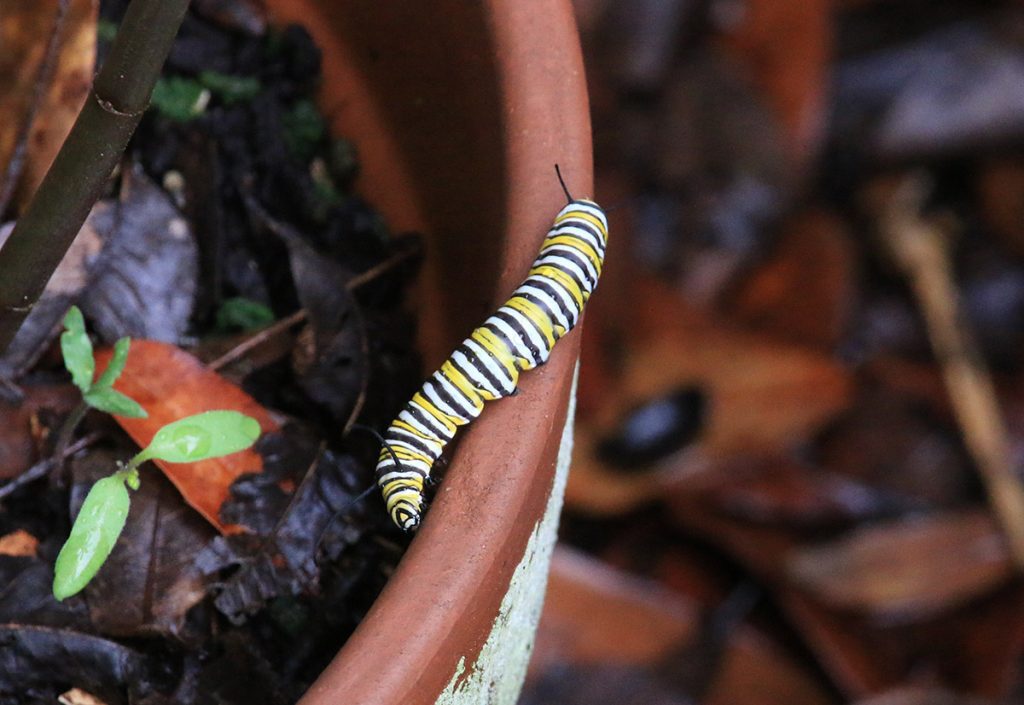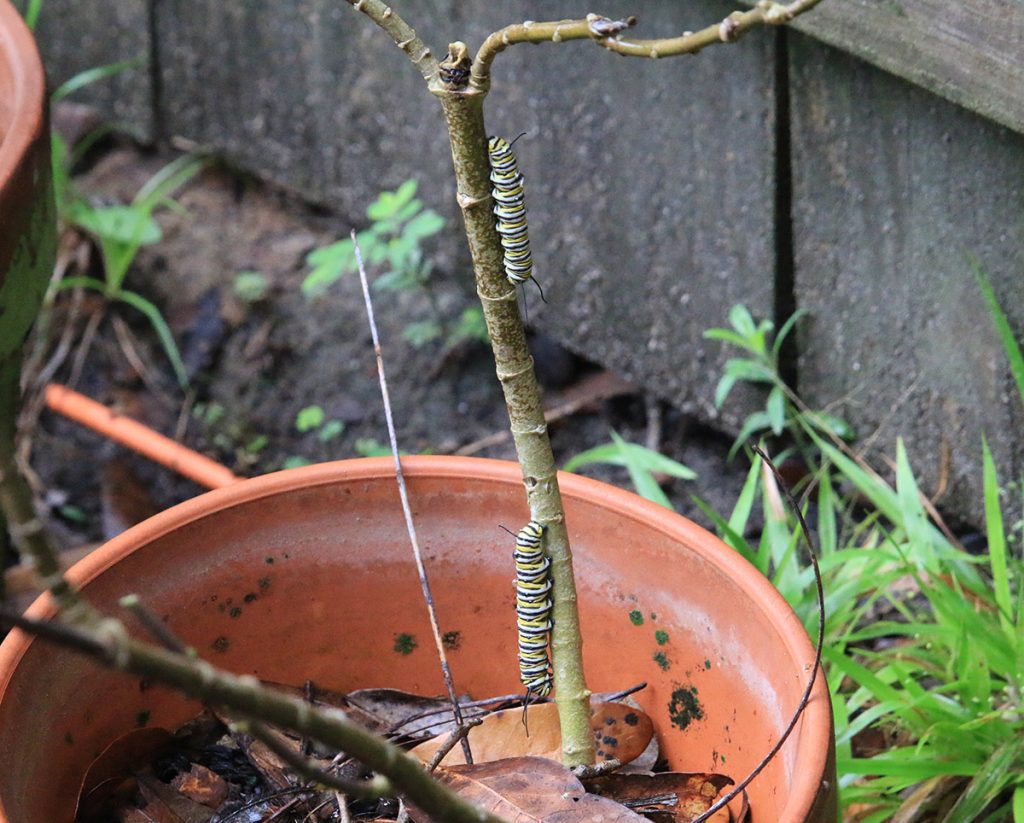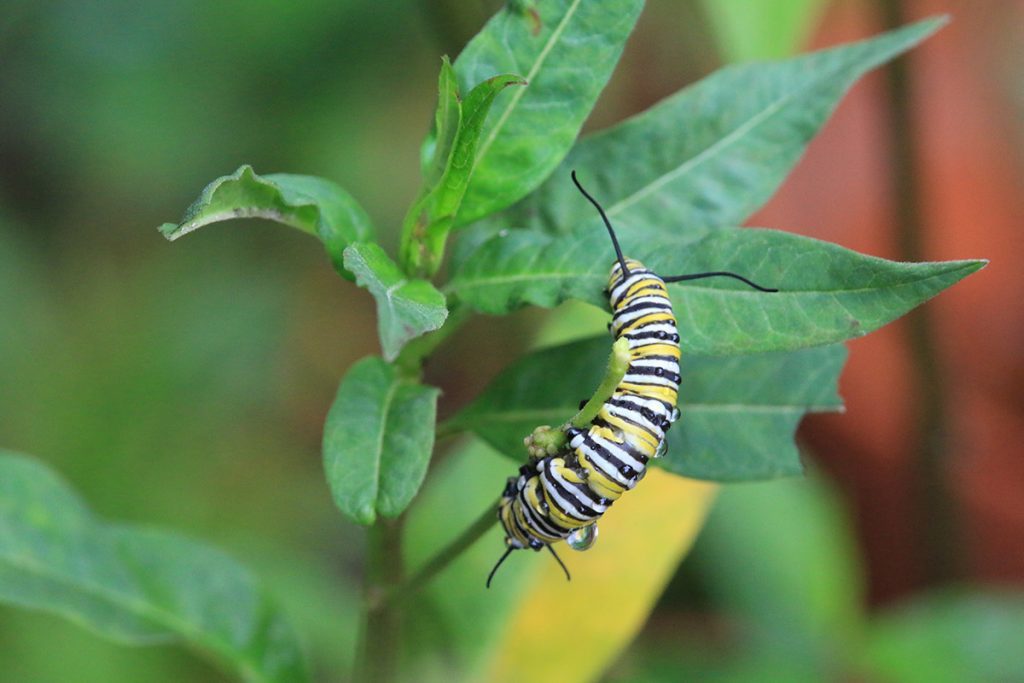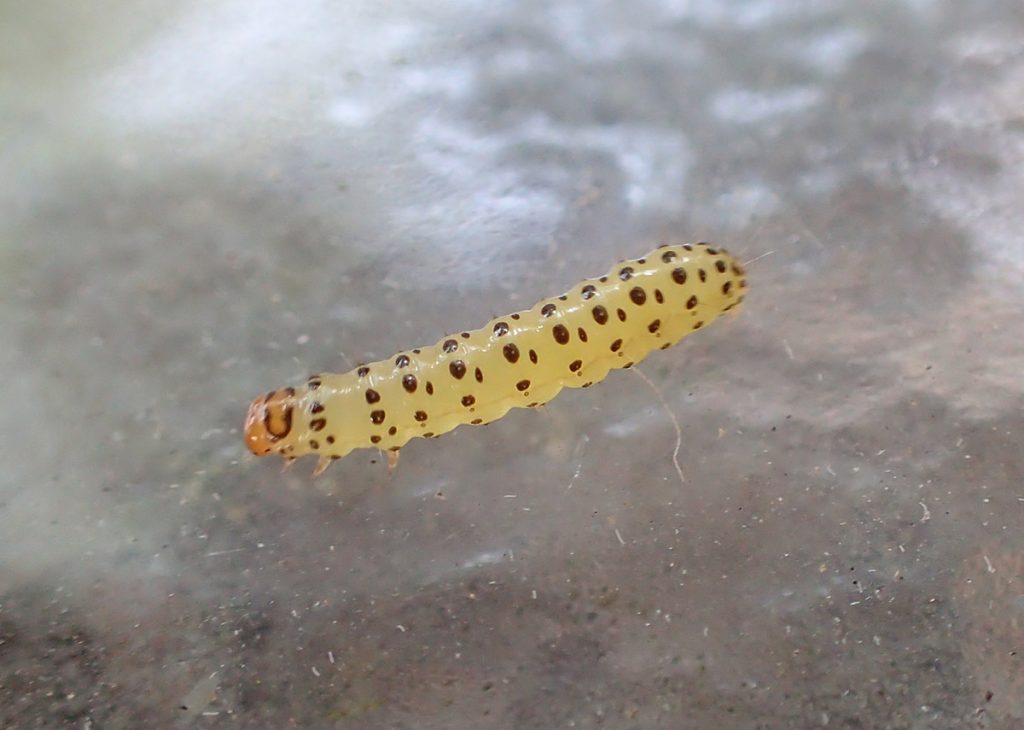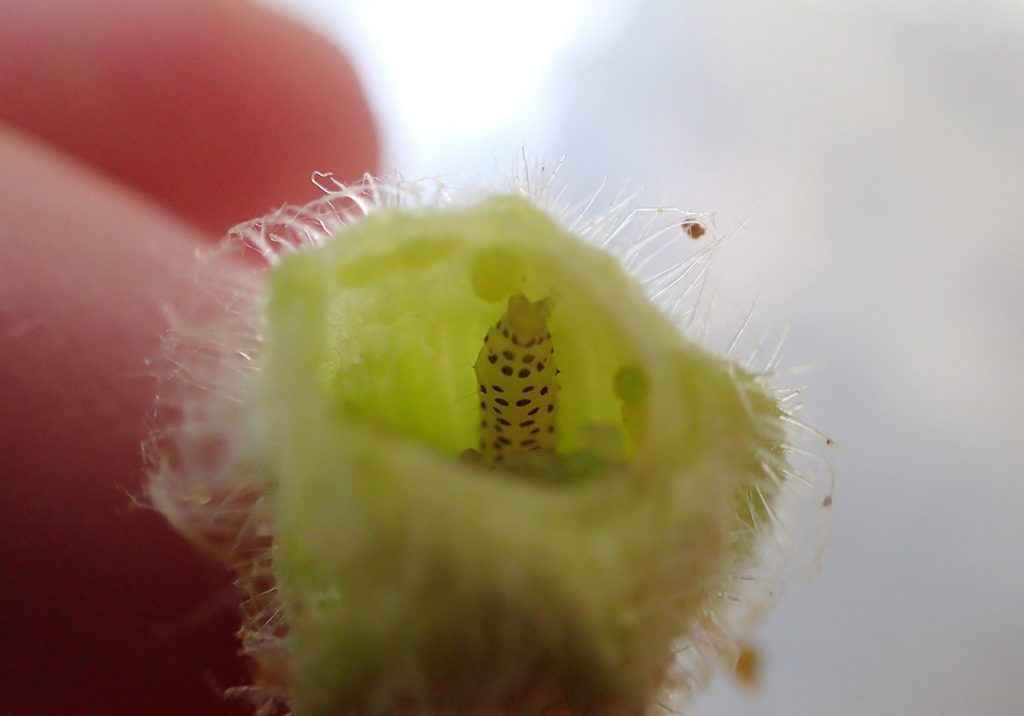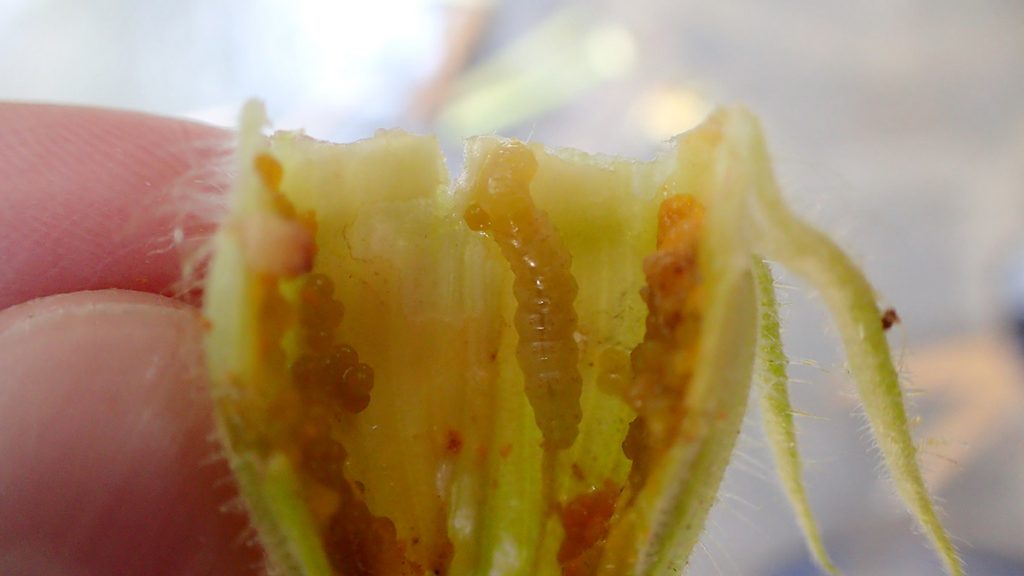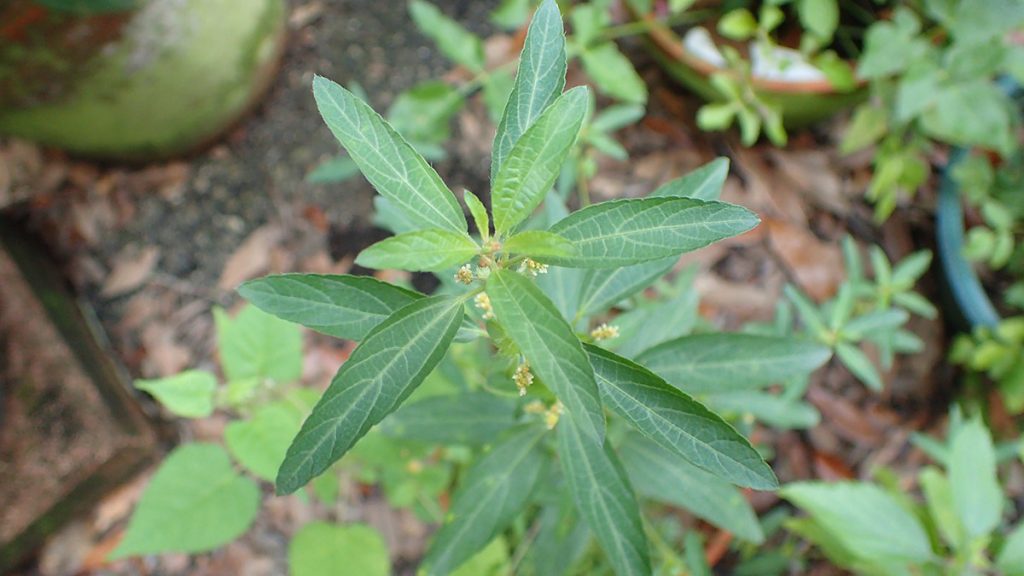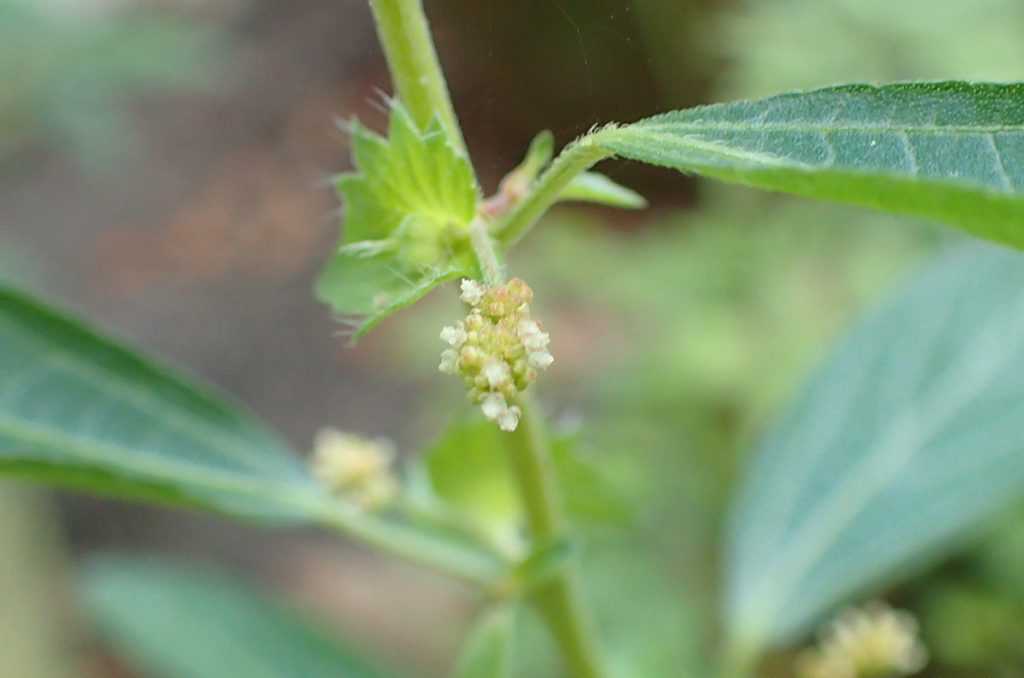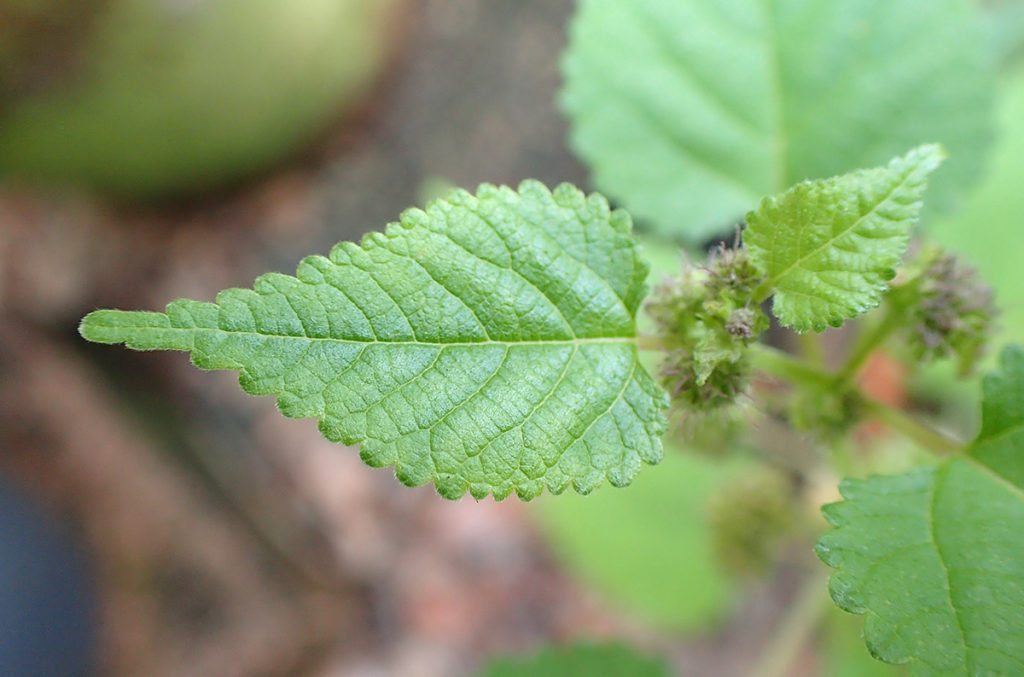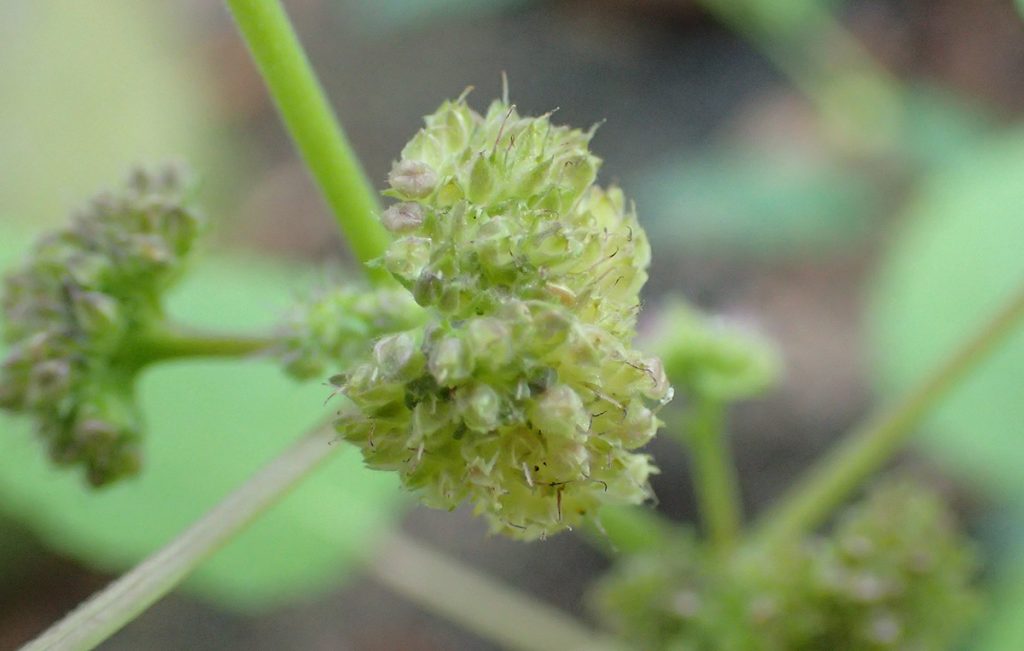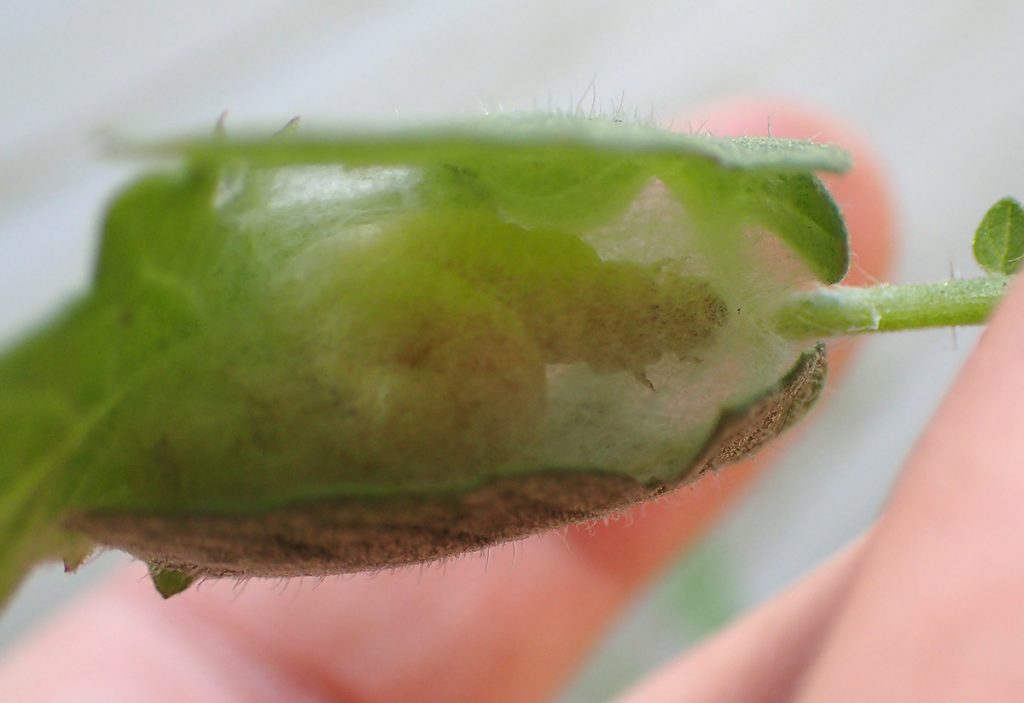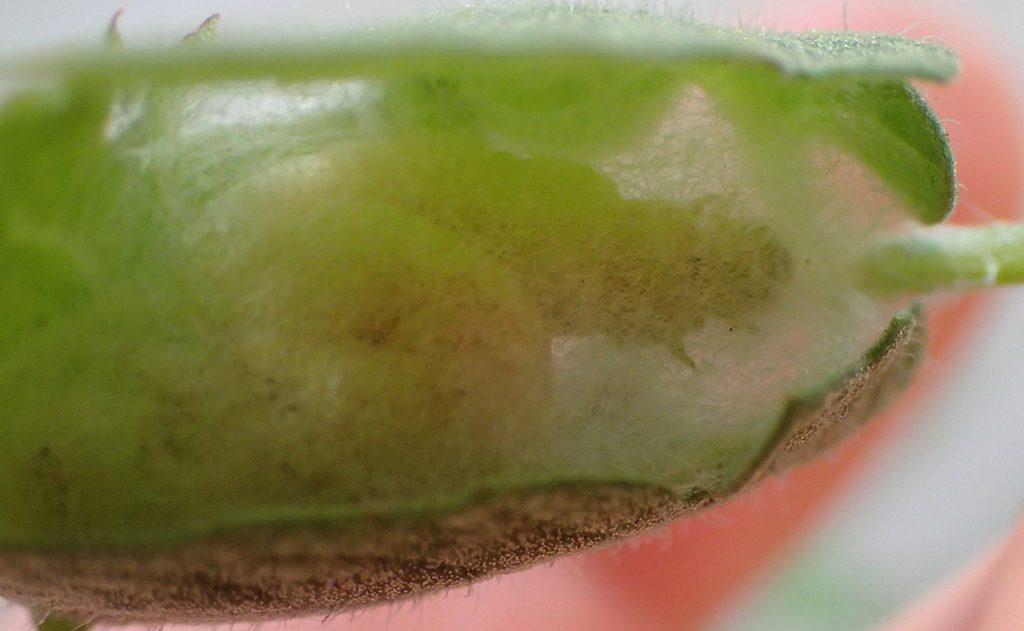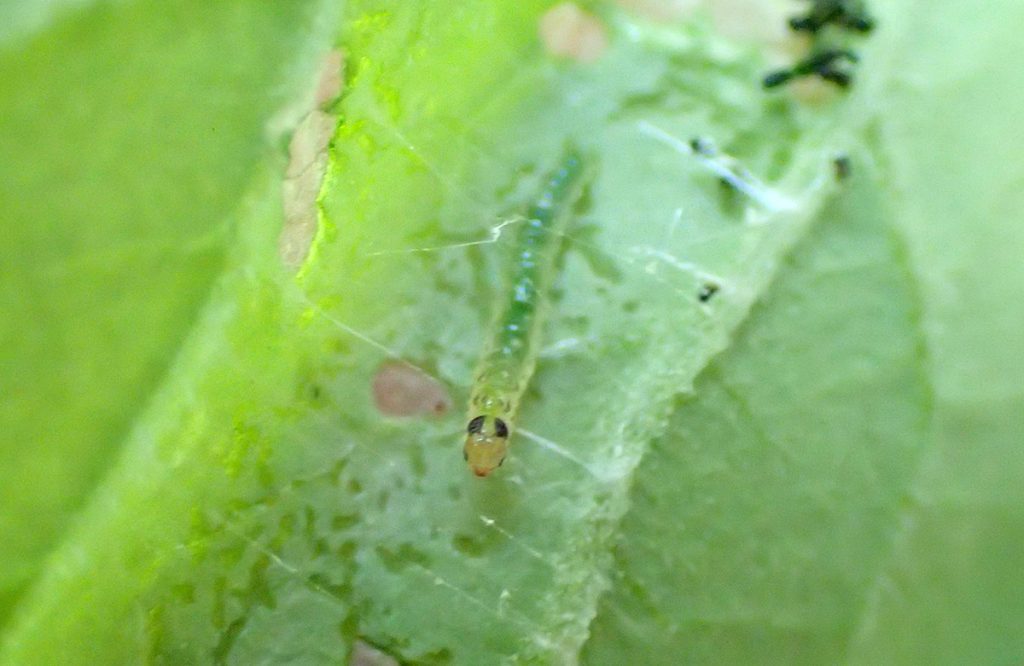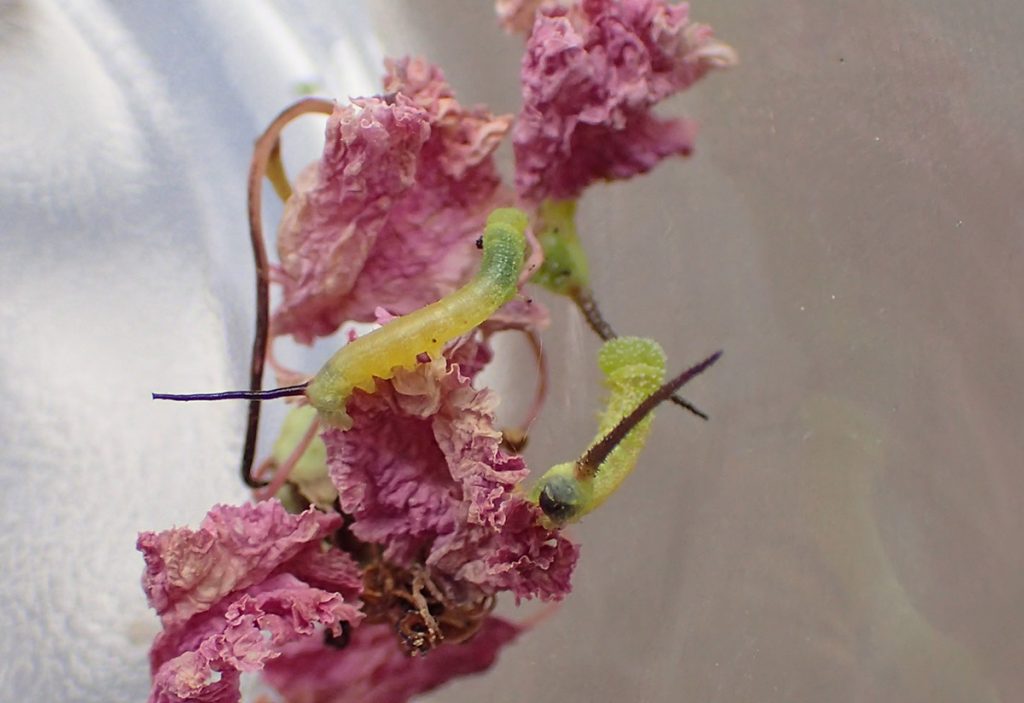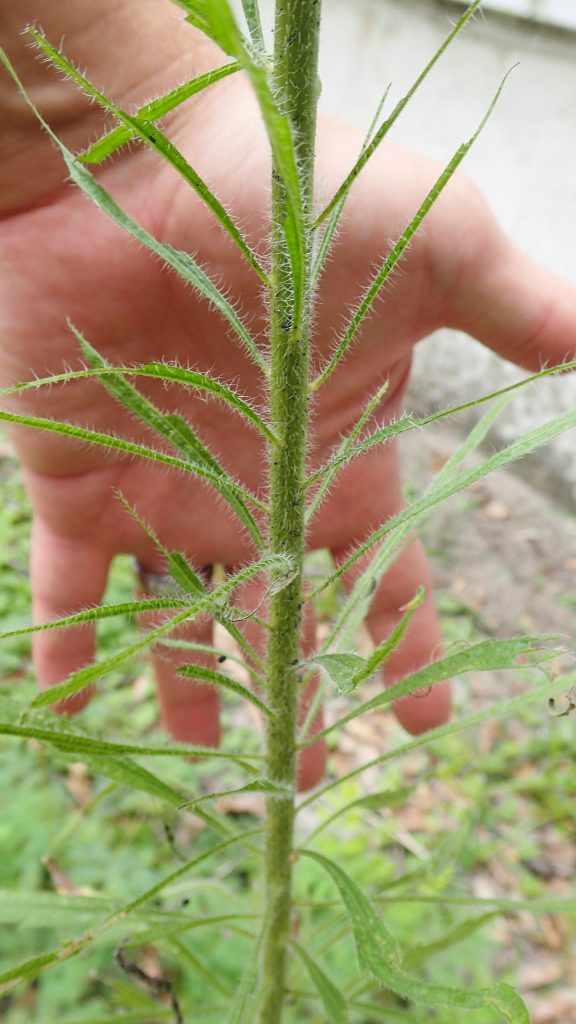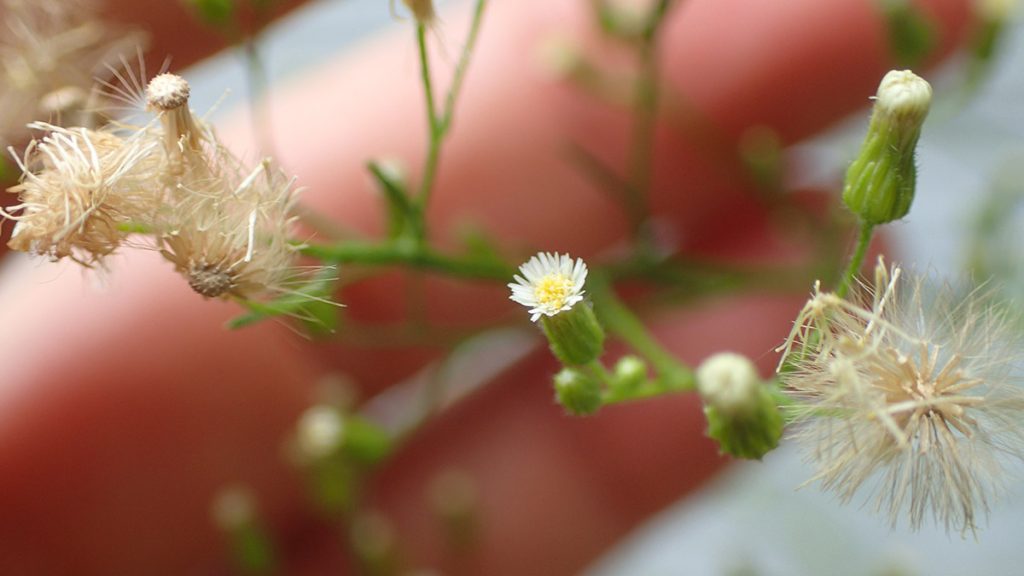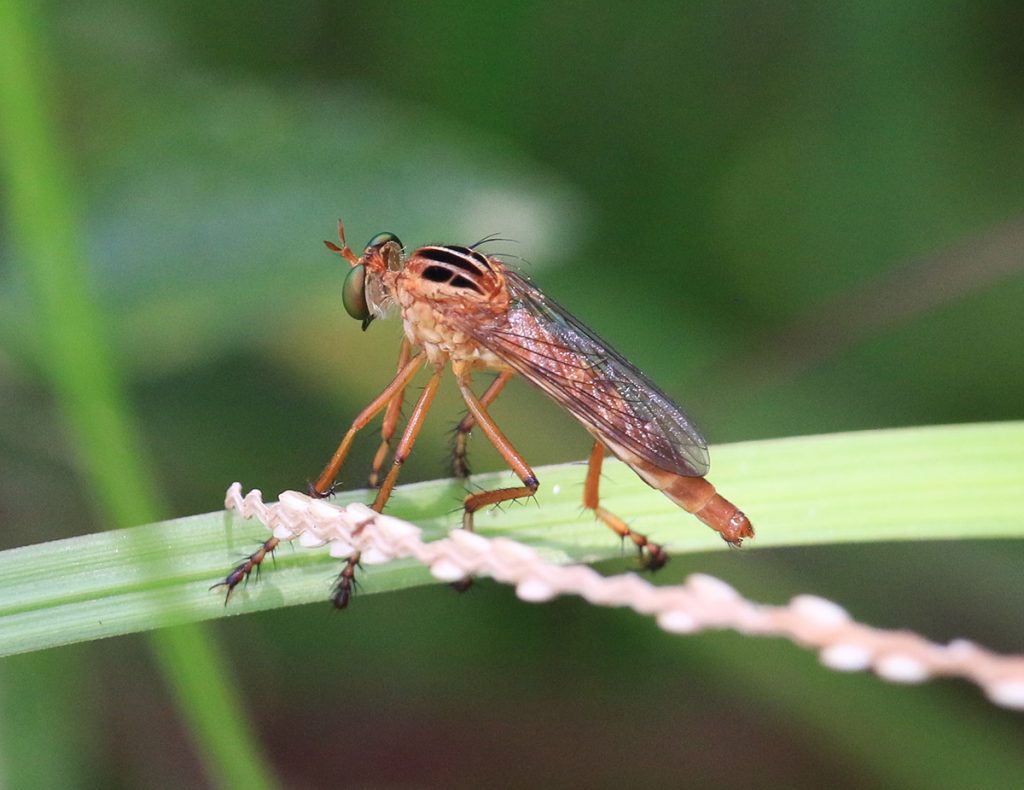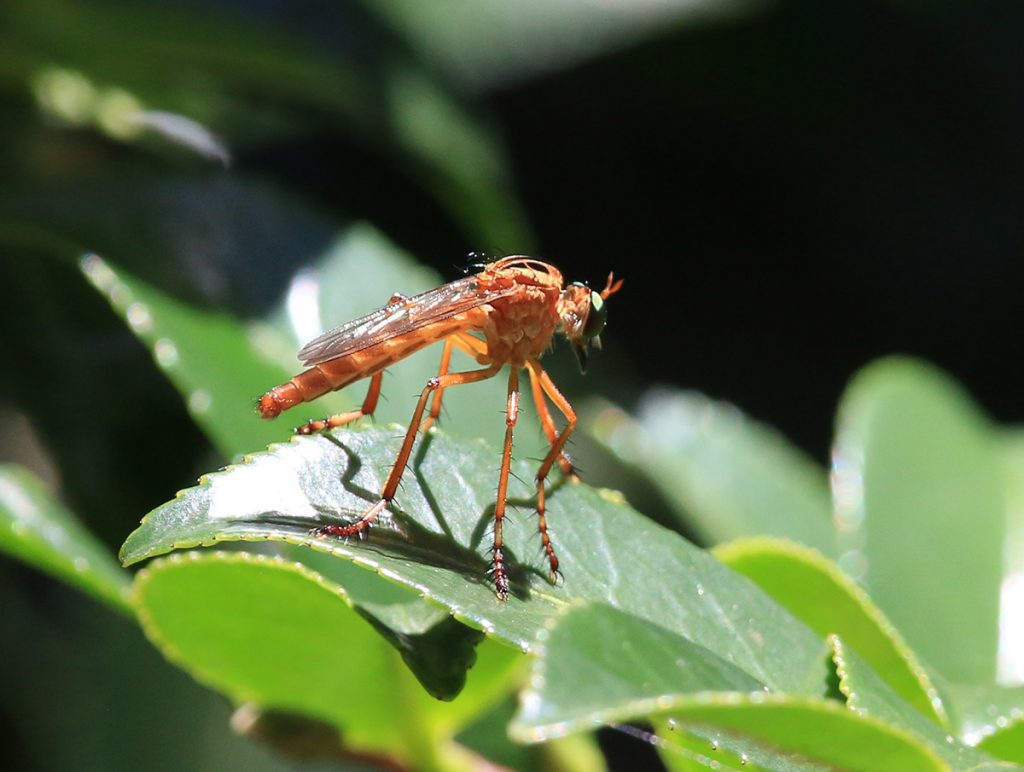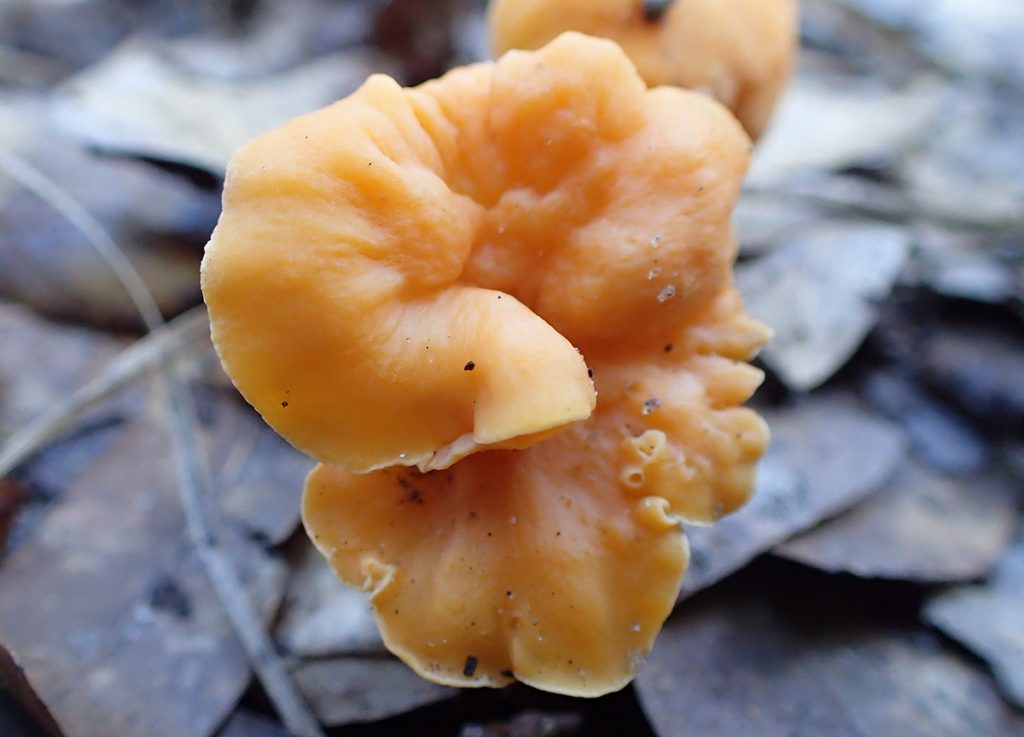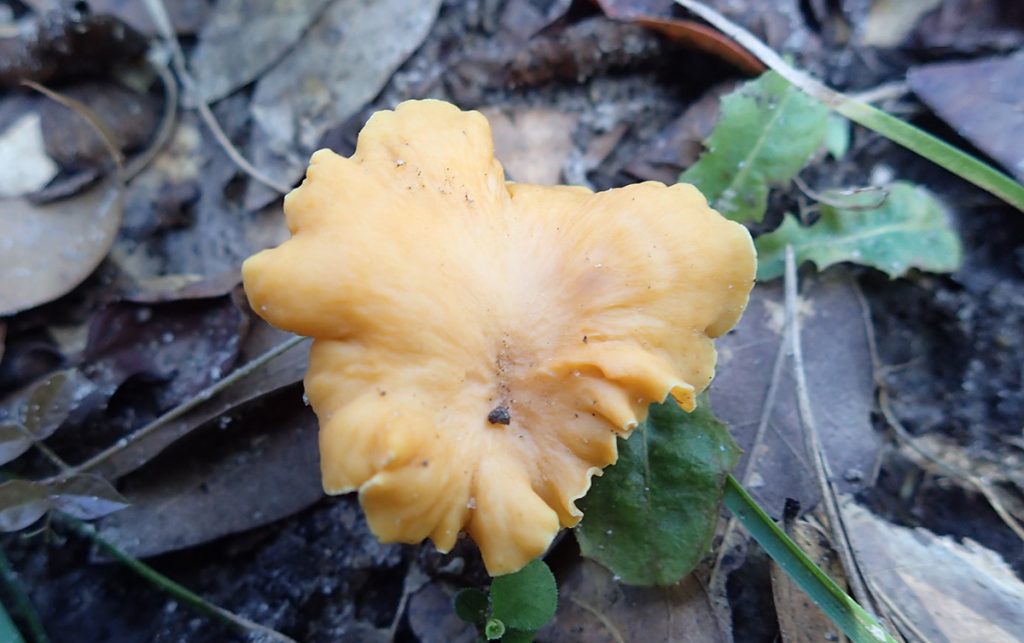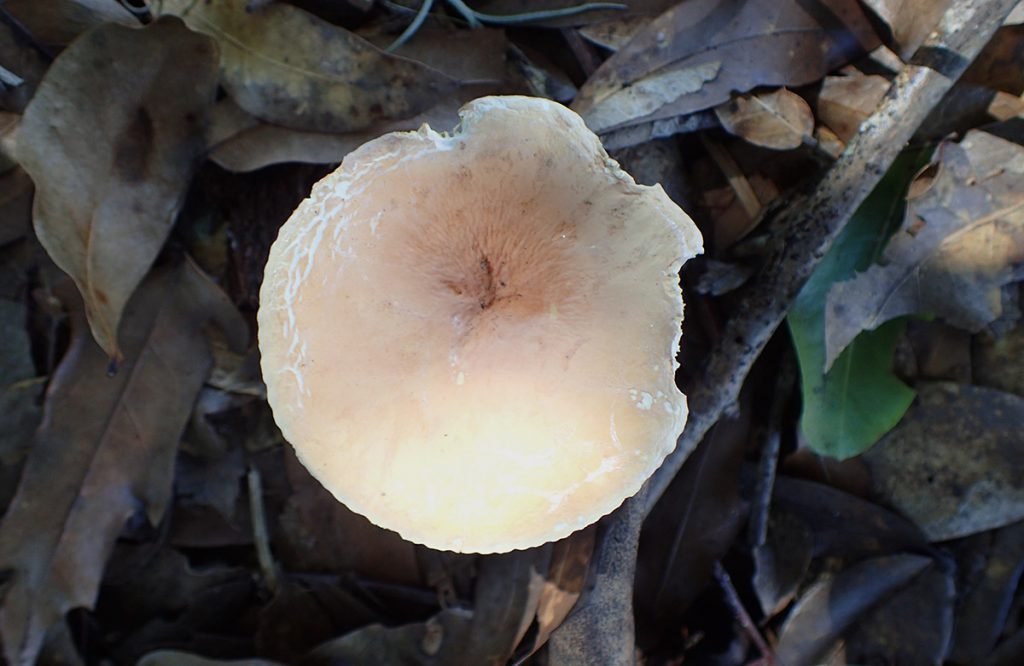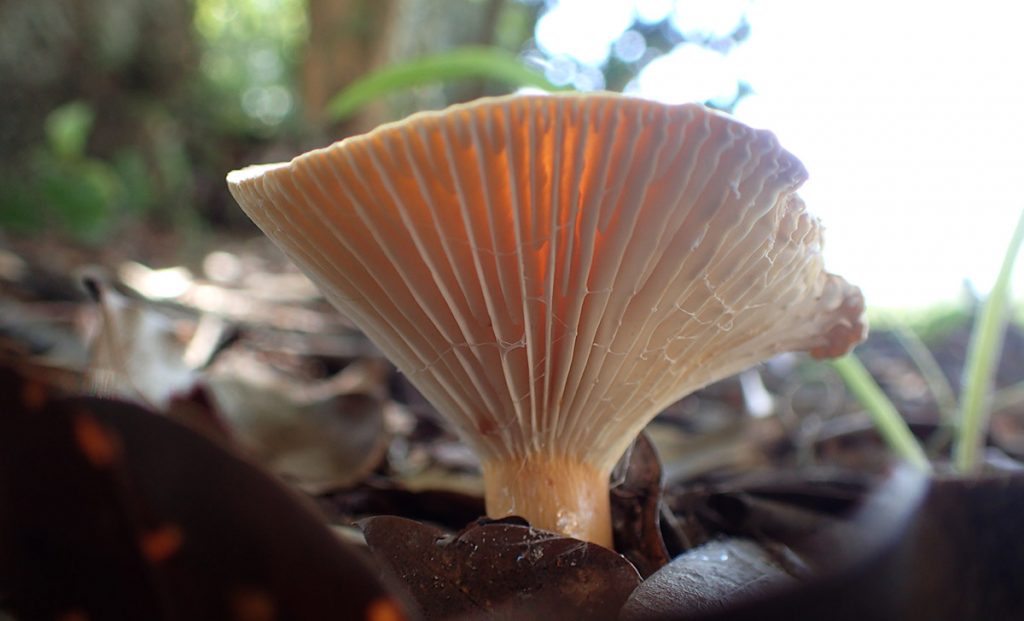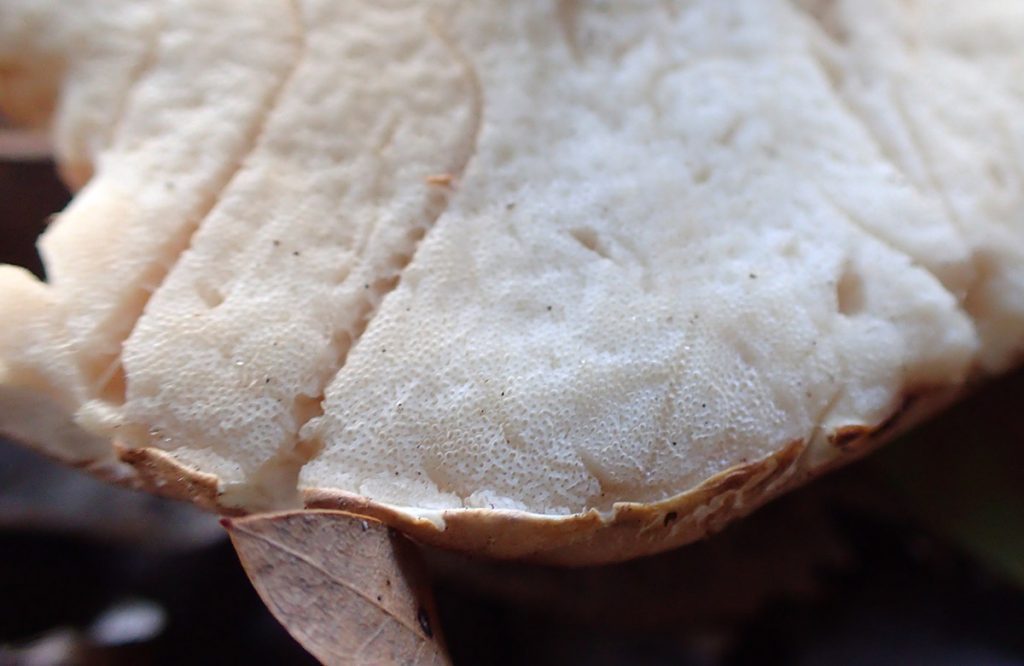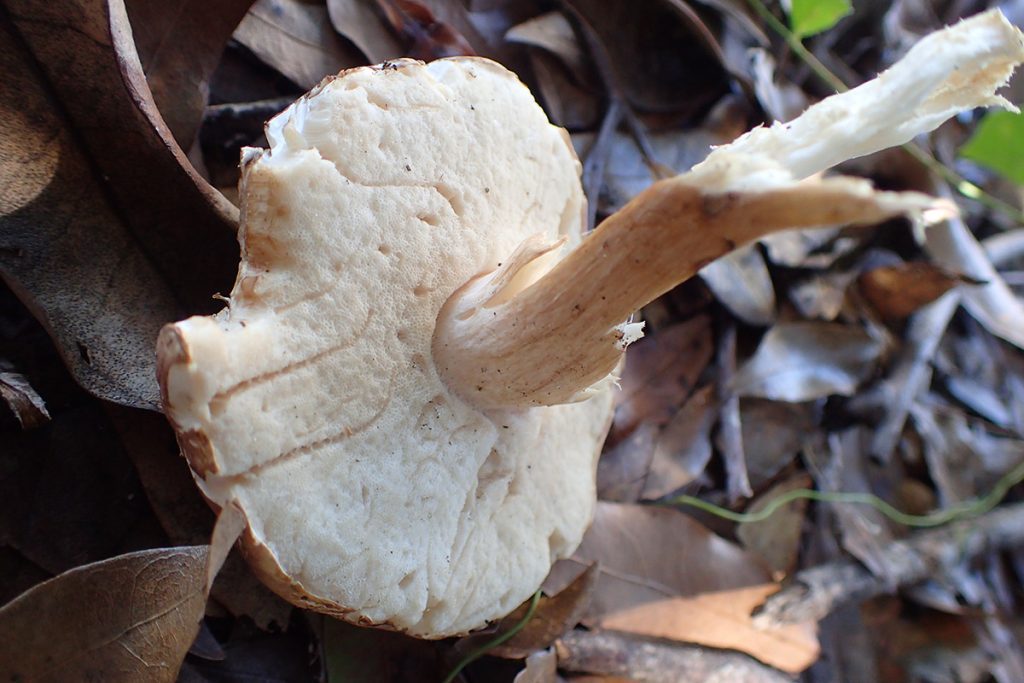August got a little busy, and I didn’t put together the July 2020 Backyard Blog. So, I’m combining it with August, and also, I’m changing up the format a little bit. Instead of breaking down plants and animals into categories (like pollinators) and sub-categories (like bees), I’m returning to the daily log format of the 2018 Backyard Blog. I like following the change in seasons, and new blooms, and breeding and everything else in this way.
As with the rest of my work-at-home 2020, the backyard continues to be lively, inhabited by an ever changing cast of critters. More than I’ve ever seen. On the one hand, we see recurring seasonality, like how brown-winged striped sweat bees became so numerous during this August as they had last August. And then there’s our dotted horsemint patch, which attracts so many wasp species in the late summer every year.
But we always have new visitors, or plants and animals I’m only noticing for the first time. We start with four monarch caterpillars in a down year for monarchs in our yard.
July 6, 2020 | Monarch caterpillars
I was writing up the June 2020 Backyard Blog, and about the paper wasps that kept patrolling our milkweed plants. In May and June, I’d see small monarch caterpillars one day, and then no caterpillars the next. I think part of our problem is that we’ve had so few caterpillars overall in 2020; in previous years, even if a few were picked off, enough made it to their second or third instar to make it to adulthood. By this time, they’ve eaten enough toxic milkweed to become toxic to most predators. And toxicity is their primary defense.
Anyhow, I hadn’t checked in a few days, but remembered seeing a couple of caterpillars. When I went out that morning, I saw that there were four of them, and they were good and large. They disappeared within a couple of days, but they looked just about ready to make chrysalides. Scroll down to see whether or not they did.
Still, we’ve had way, way fewer monarchs than in previous years. Is that true for the rest of you in north Florida and south Georgia?
July 7, 2020 | Dung beetle surprise
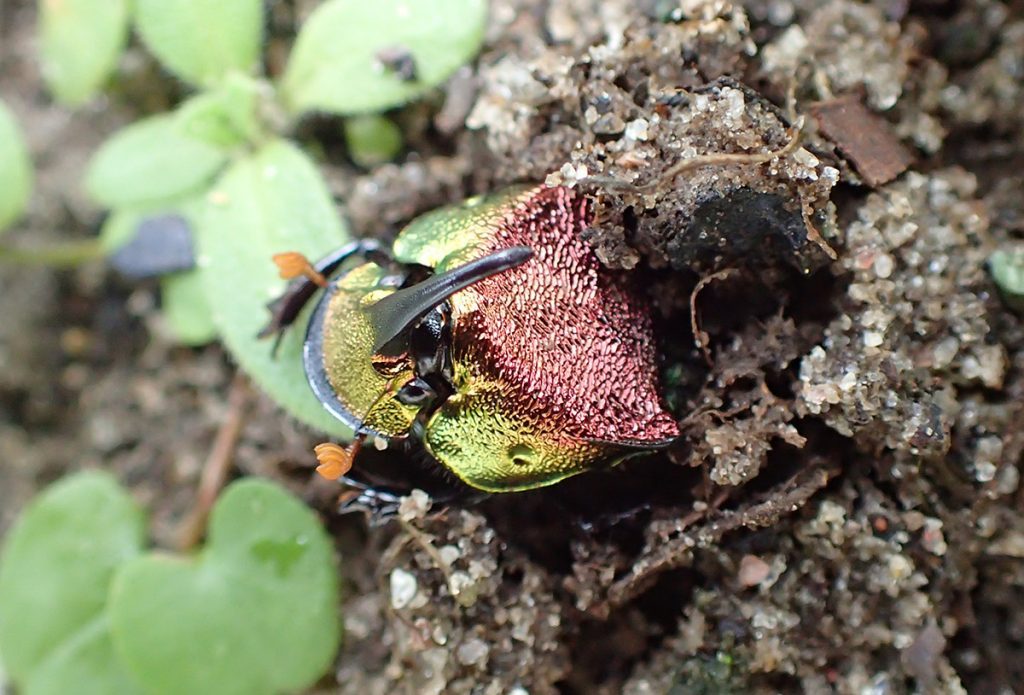
Right around the time I took this photo, my son, Xavi, told me that he missed seeing dung beetles in the yard. Yes, he said that. Last year, we had multiple rainbow scarabs breaking down dog poop in the yard, and we all got a kick out of these shiny little guys pushing around giant (to them) boulders of waste. Sadly, our dog passed away earlier this year.
Imagine my surprise, then, when I saw a dung beetle emerge from a bare patch in the yard. Likely, it had spent the winter in the ground as a larva, and broke out not far from what once had been one of the poopiest places in our yard. This is the last I saw of it.
July 8, 2020 | Another kind of bee mimic
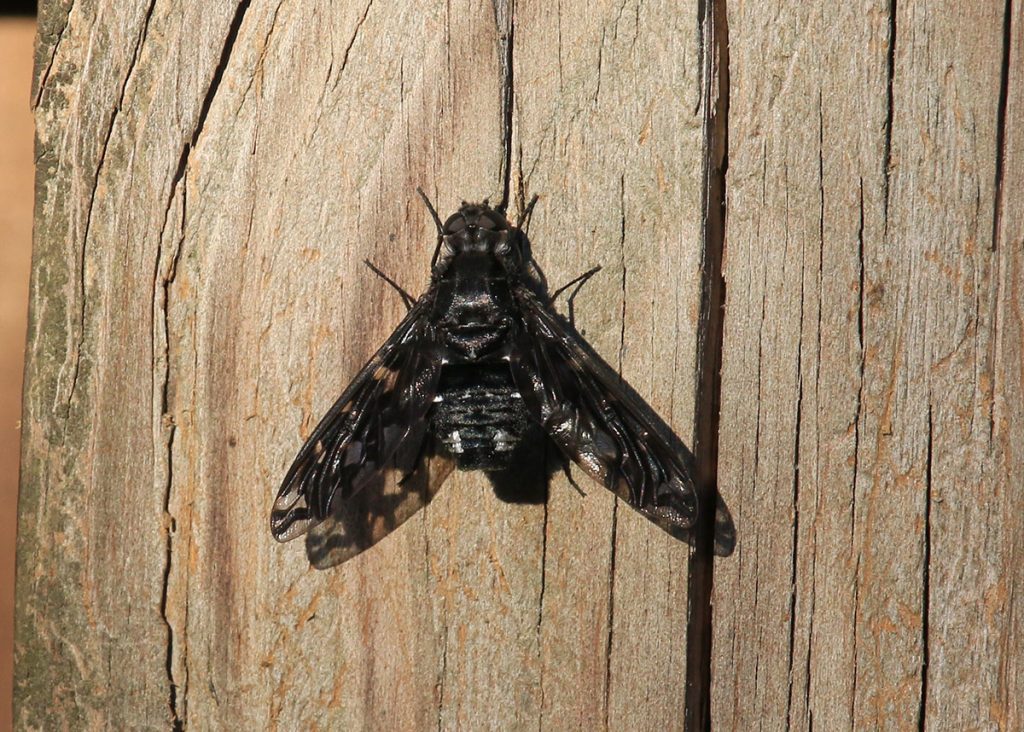
I saw what looked like a large bee out our back window, and went out with a camera. This is actually a bee mimic, a tiger bee fly (Xenox tigrinus). I hadn’t known about bee flies until I spent a few days photographing pollinators at Elinor Klapp-Phipps Park right around when I photographed this. That one was in the genus Villa.
July 10, 2020
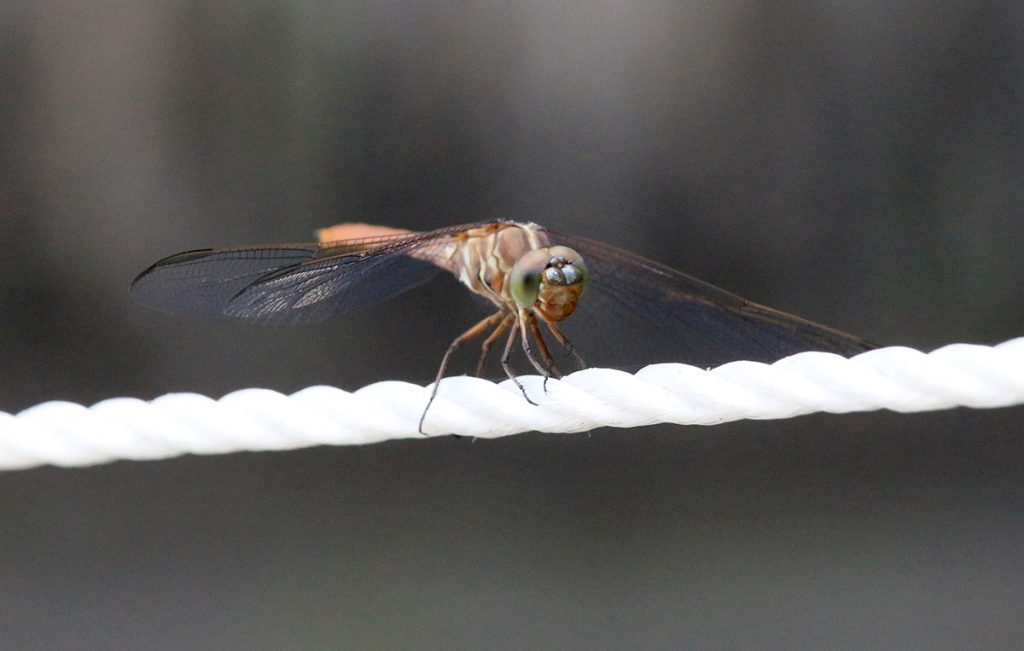
I saw this brownish dragonfly on a line in our yard. Roseatte skimmers can get a nice shade of purple.
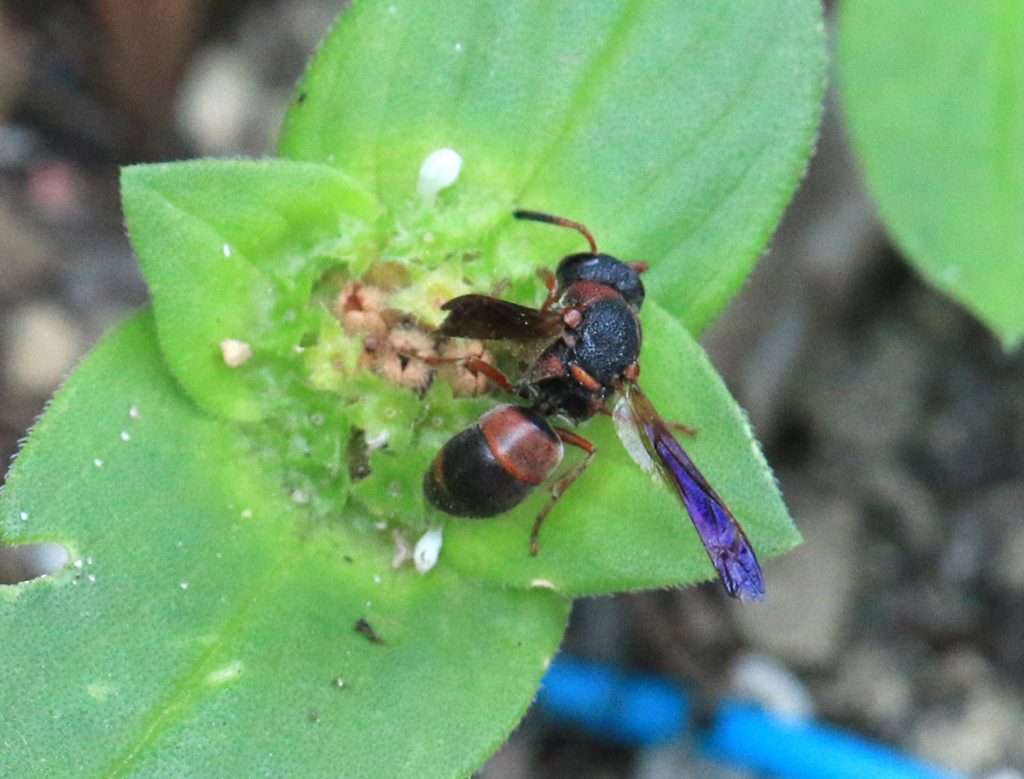
Red-marked pachodynerus wasps (Pachodynerus erynnis) have become common in our yard. They’re the only insect that makes use of the bee house my wife Amy bought, and they seem to have increased their numbers considerably over the last couple of years. The nest boxes are favored by mason bees, and these are mason wasps. You can see one of their earth-sealed nest cells further below.
July 11, 2020
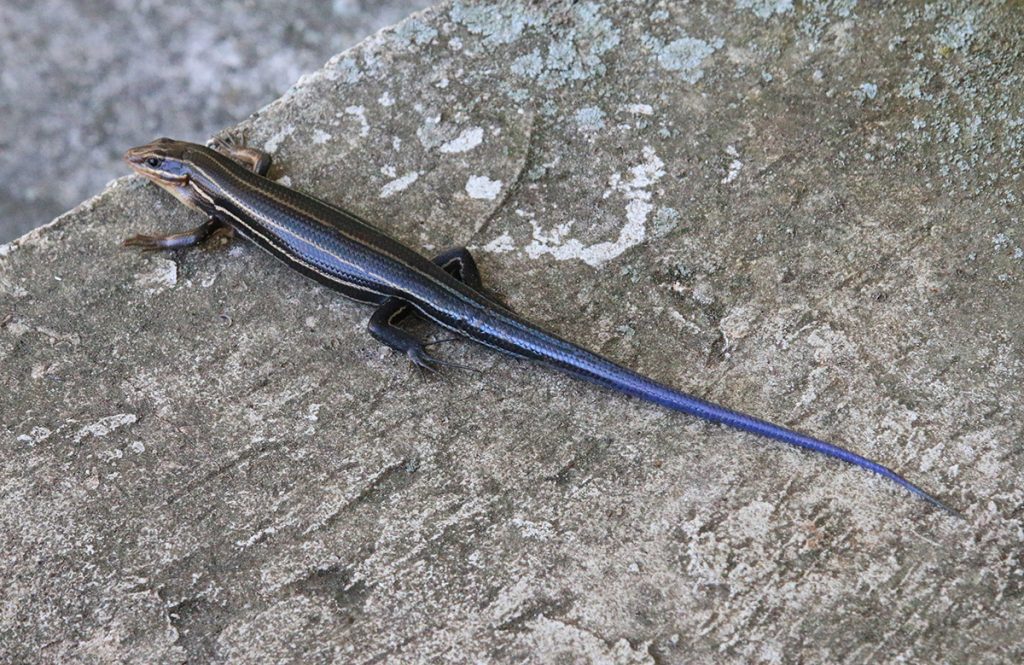
For years, skinks have always raced away from us in the yard. What a treat, then, to have one basking on the step, and sit still for a few photos.
I photographed this same skink, peeping out from under the step, in June. I first thought it was a five lined skink, but learned through iNaturalist that this was a female broadhead skink. The males lose their stripes, turning olive grey with a reddish head. Females more commonly retain their stripes, even if they’re not as vibrant as when they’re young.
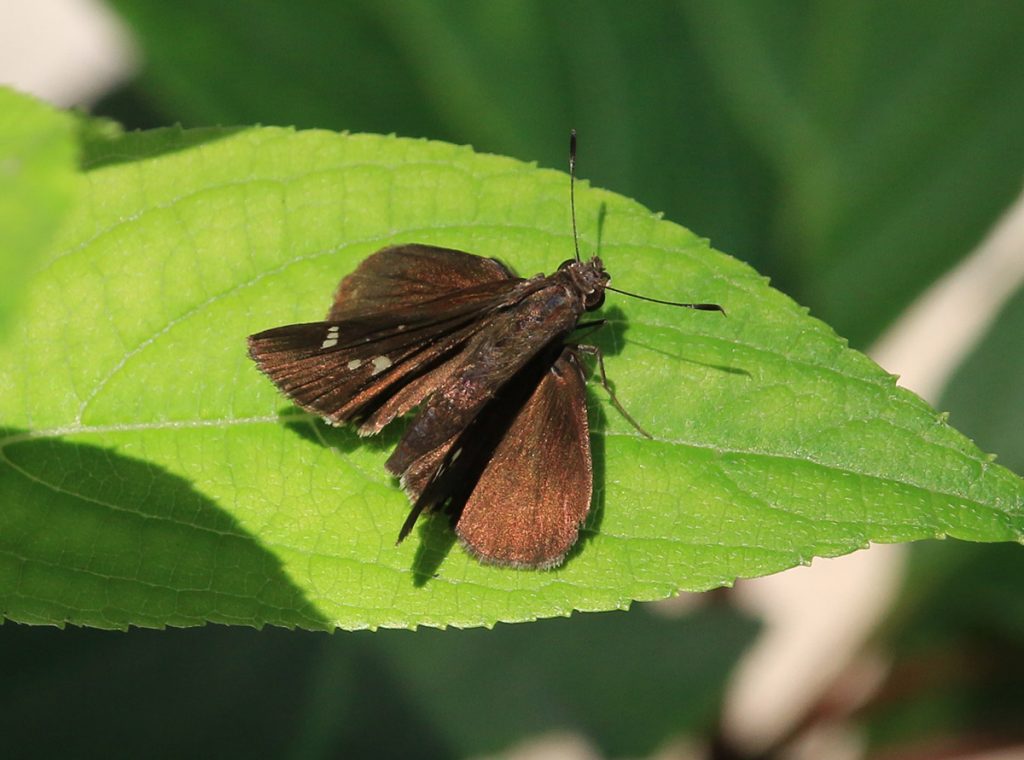
Clouded skippers are one of the small skipper butterfly species that we’ve seen in our flower patch this year. Within a couple of weeks, larger butterflies are going to become more common in the yard.
A familiar pest returns…
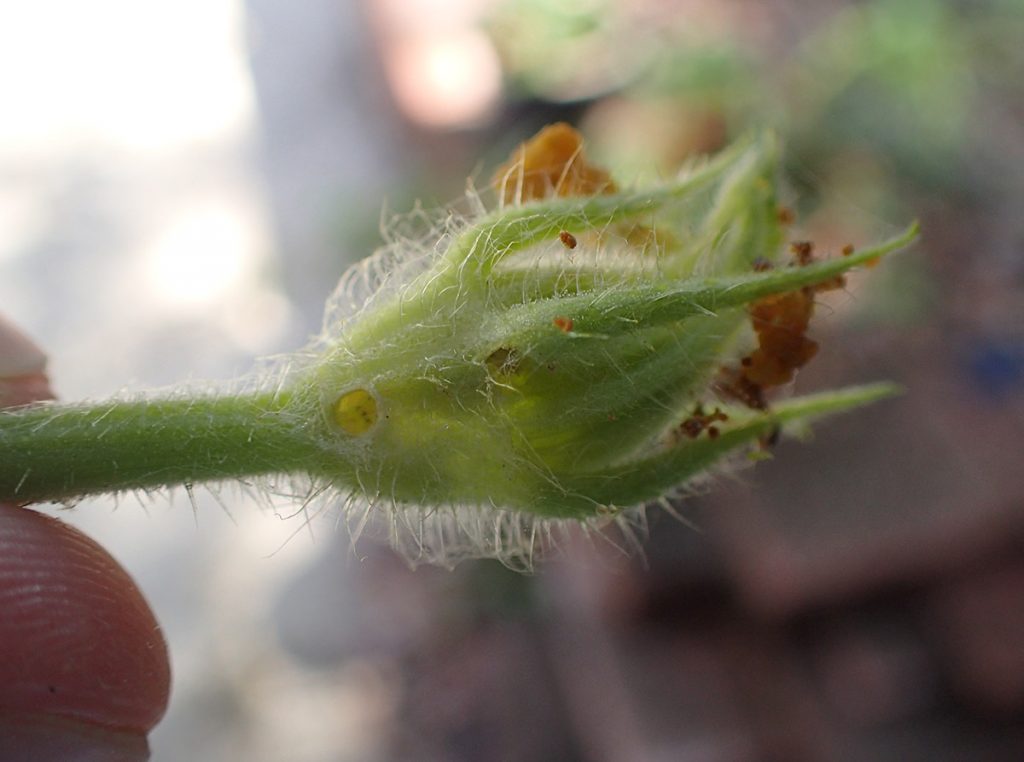
Remember those old Peanuts comics where Lucy keeps tricking Charlie Brown into planting squash in his yard, and then she pulls the football away and he falls on his rear? This year, I told myself, the squash vine borer wouldn’t pull that football away, and we’d get a nice looking pumpkin. Nope.
Xavi brought home some pumpkin seeds from his kindergarten teacher, and despite our long history of failure with gourds, we planted them. They grew into nice large vines with many nice looking yellow flowers (all male, seemingly). That’s how this insect toys with you; as the plant grows big and healthy looking, its larvae grow along with it. And then you see that yellow junk like you see on the flower above, the frass. The vine hadn’t produced any fruit, at least. We’ve had nice looking zucchini in the past that all of a sudden started seeping frass, and we’d know the whole plant was ruined.
I cut open some sections of vine and found these:
I smushed every caterpillar I could find. Later on, I looked through the soil for their chrysalides, and found none. They’ll overwinter in the soil, so it’s good to check, and plant your squash somewhere else the next year. We’ve done that, and even taken years off from growing them. Nothing has defeated them in our yard.
Using iNaturalist to identify “weeds”
This was also the day I finally photographed a couple of plants that have become common in the yard, to identify them in iNaturalist. I’ve gotten more users to to identify these nondescript types of plants than when I started on the app. This is because I’ve been consistent in getting multiple photos: flower closeups, leaf closeups, and the plant as a whole. If the leaves or flowers are especially small or large, I’ll put my hand in the shot for scale.
So, what did we have?
This one is a native of the southeastern US. Oddly enough, it is described as common in frequently burned sandhills and upland pine forests. It’s also found in wetter places, like floodplain forests, so it can grow in a variety of habitats.
This is an exotic invasive native to Asia. I’ve got to pull them and bag them.
July 12, 2020
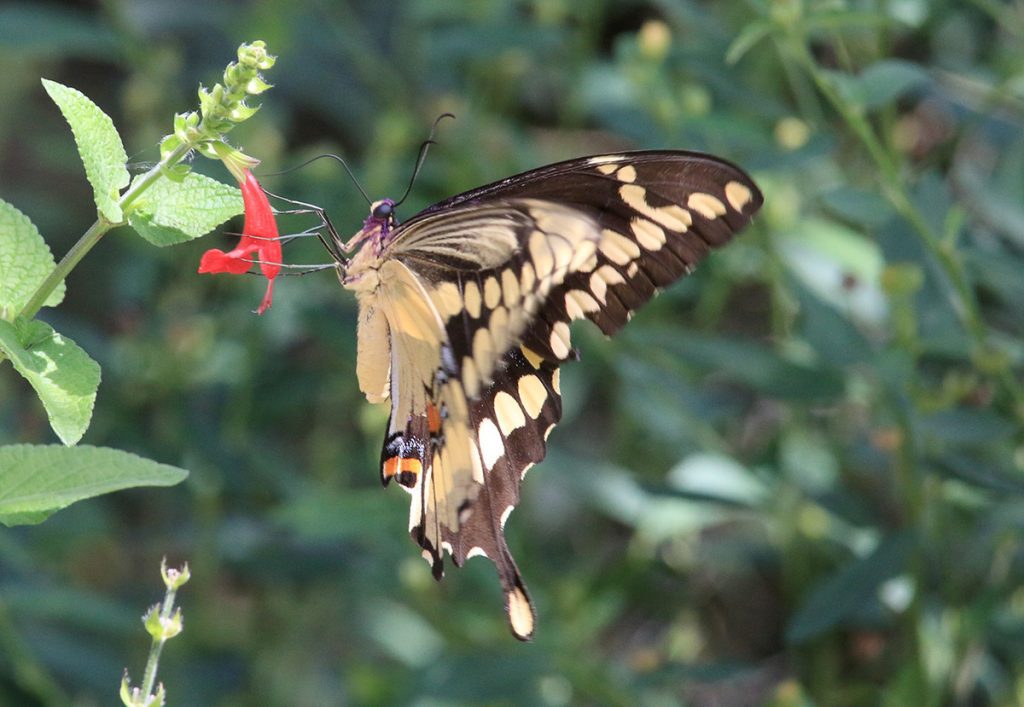
I don’t see giant swallowtail adults in our yard unless they’re laying eggs, or hatching from chrysalides. Their business in our yard revolves around the Meyer lemon tree, where their caterpillars grow.
But this one here was in our flower patch for a little while. It had been about a month since I last saw a giant swallowtail caterpillar on our Meyer lemon tree. This feels slightly long for a caterpillar to find a place, make a chrysalis, and hatch (I read 20 days at the most to hatch).
I also read that they can take ten days to hatch from eggs, and spend three to four weeks as caterpillars. And- spoiler- I may find a largish caterpillar in about a month. So maybe this one did lay eggs at some point in the morning.
Speaking of caterpillars…
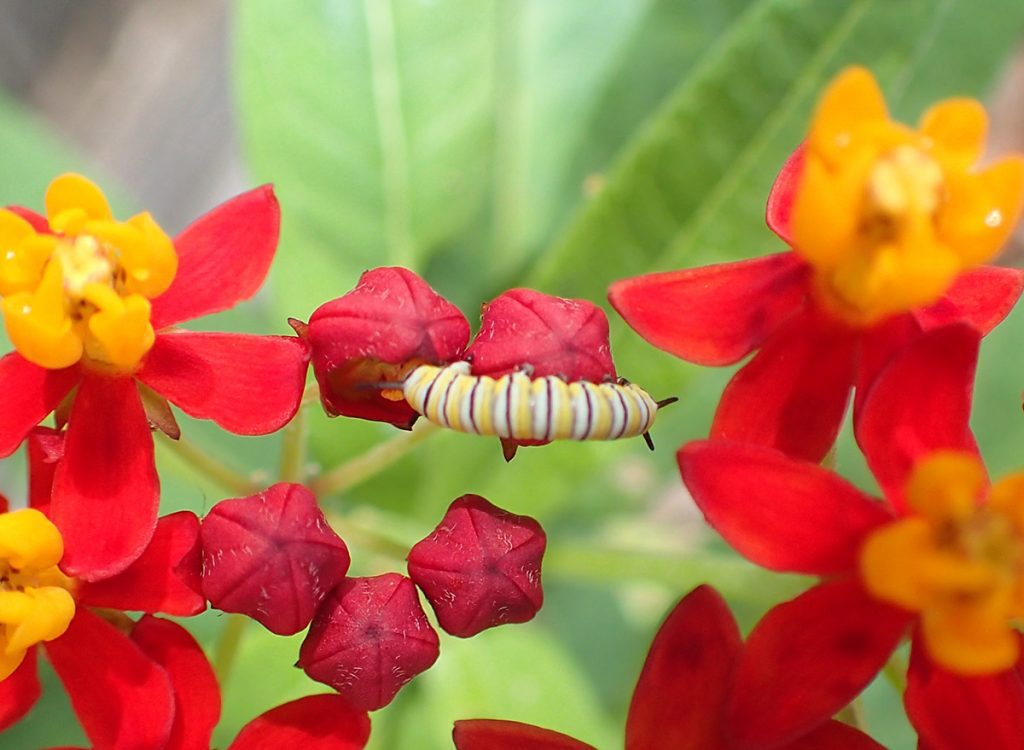
I only saw this monarch caterpillar once. I’m not looking as regularly as I have in past years, though. I missed its earlier stages, but as they get larger, they’re harder to miss. Anyhow, this is the last time I saw a monarch caterpillar in the yard.
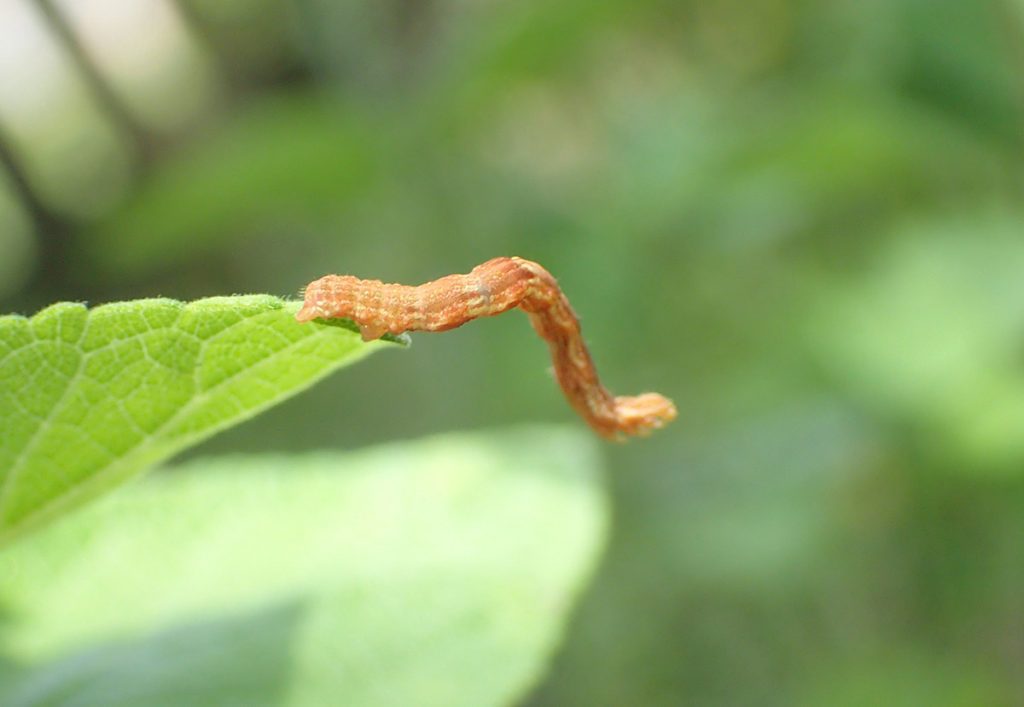
This is an inchworm, or geometer moth. My first iNaturalist guess is subfamily Ennominae, but I have not gotten any confirmation.
July 13, 2020
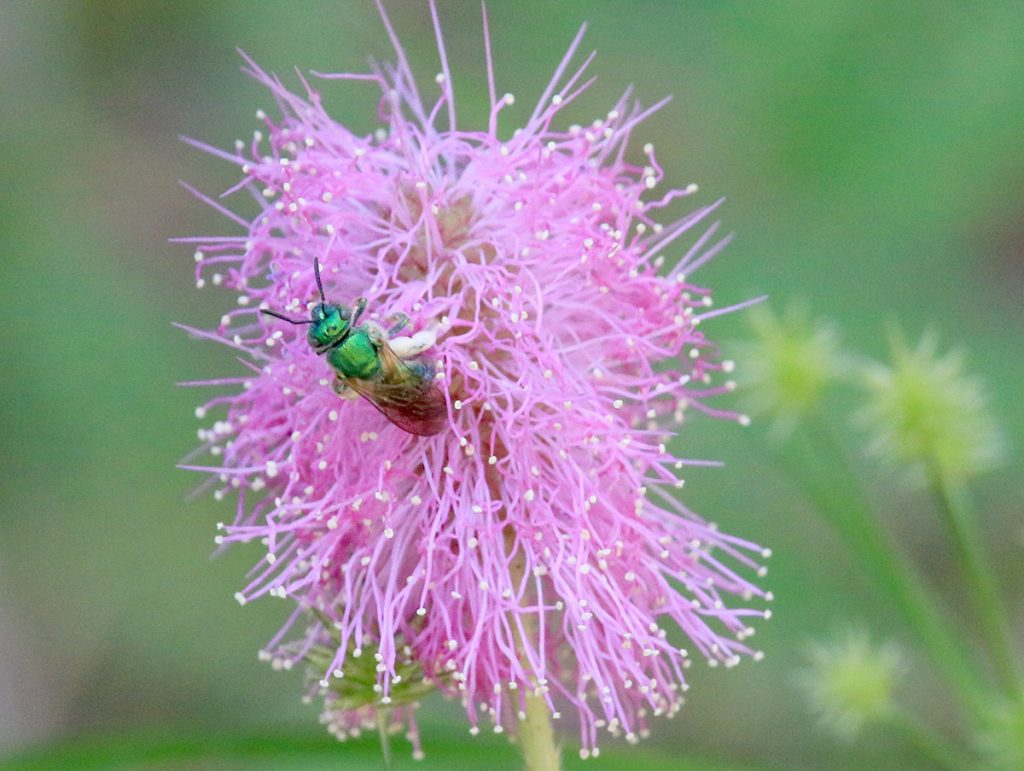
In all of my trips for the Klapp-Phipps pollinator video, I saw a ton of bees on sensitive plant flowers. I’d never seen them on ours, which aren’t as numerous and only last a day before withering. We also have so many other flowers around, and active pollination, that maybe I don’t look down often enough. But here we have one.
July 14, 2020
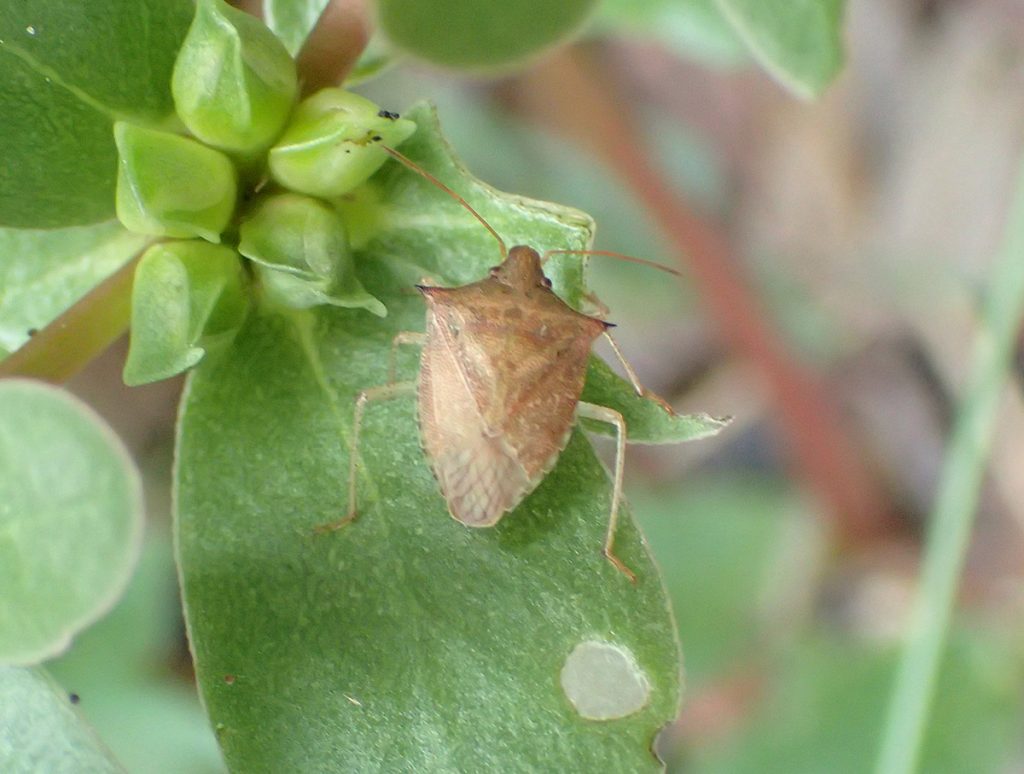
I was hoping this was a spined soldier bug- a predator and beneficial insect. We saw an insect like this one in June, which had the same general shape but a little bit of a different coloration. I read about it, and found that spined soldier bugs are very similar to dusky stink bugs, which are plant eaters and pests. The best way to differentiate is to flip them over and look at their proboscis. I didn’t do that with the first one, but here’s a look at today’s:
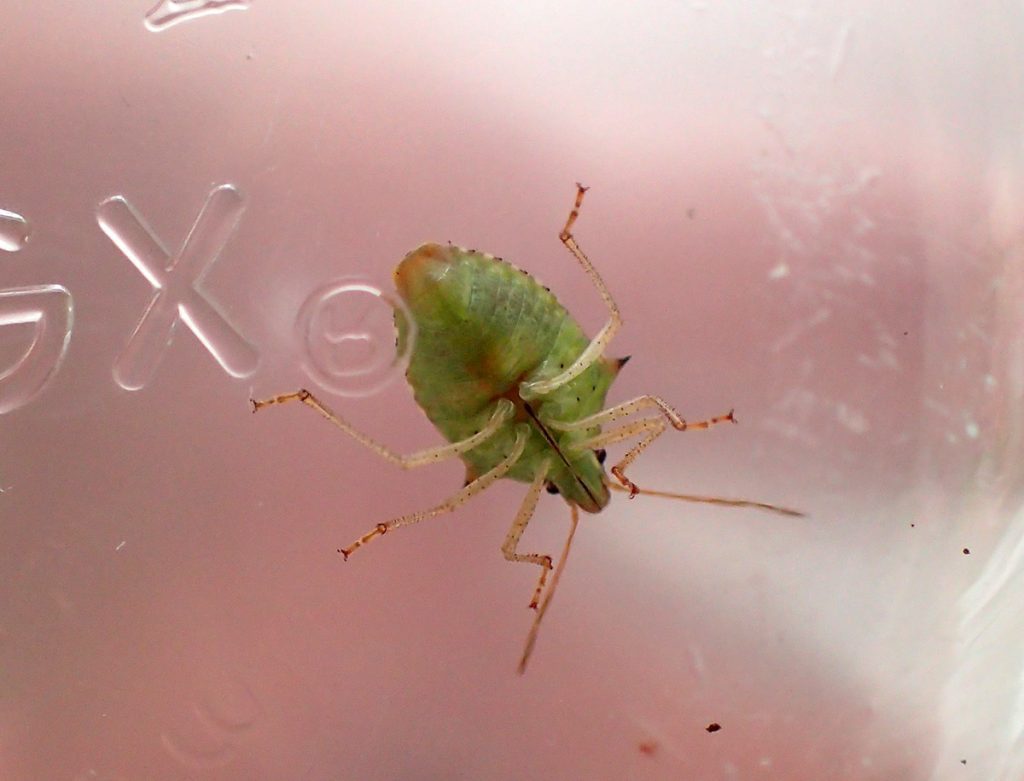
A soldier bug will have a thicker, shorter proboscis than a plant eating stink bug. This is longer and skinnier than the photos I’m seeing of soldier bugs- it’s a dusky stink bug. Its proboscis is used for sucking leaves. A pest, but I’ll leave it. It was on a purslane plant that volunteered in my yard, and it might be food for a bird or predatory insect. It’s not like I have a lot of these.
July 18, 2020 | Baby skinks!
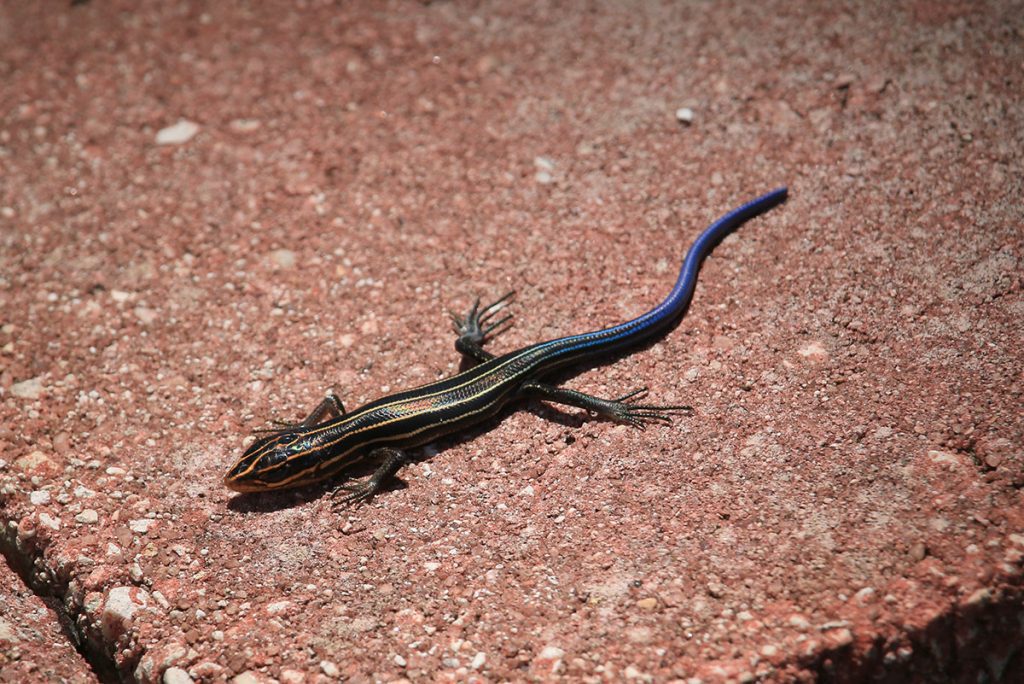
My wife Amy came to get me and the camera one day. Aren’t these cute? I figure I saw its mom on the step just seven days ago. Skinks are always retreating under the steps- I think her nest was under there. You can see how much more pronounced the stripes are on the baby than on the adult. And look at the deep blue tail.
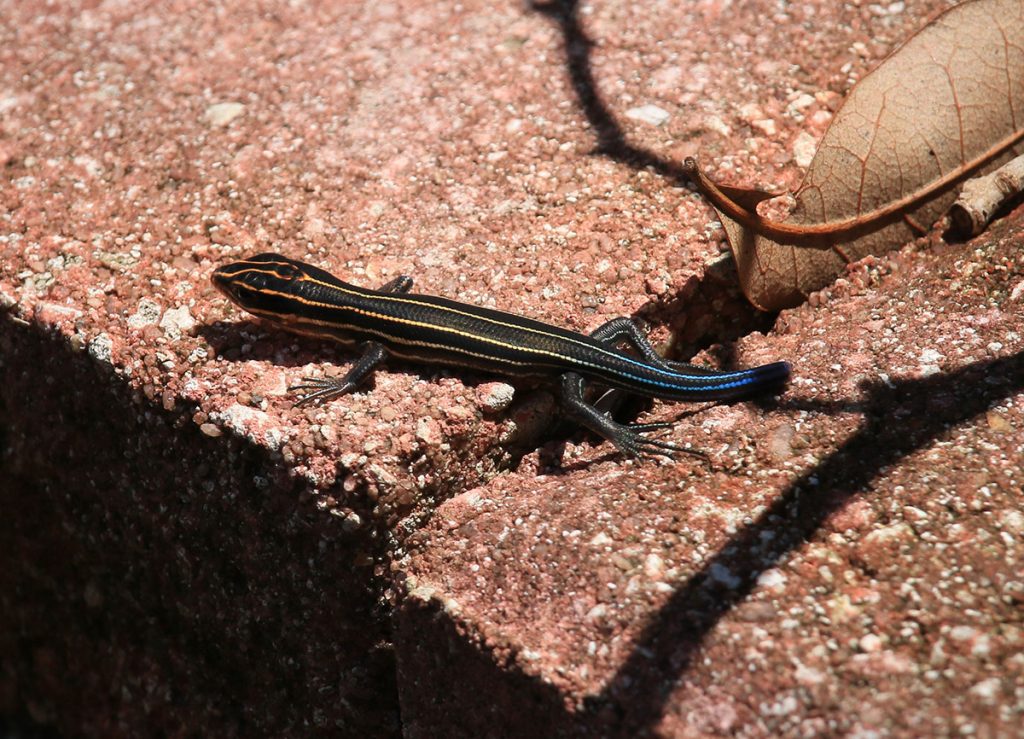
This one seems to have already gotten in a scrap and lost part of its tail. We stood back and I zoomed in with the camera, and they weren’t too shy at first.
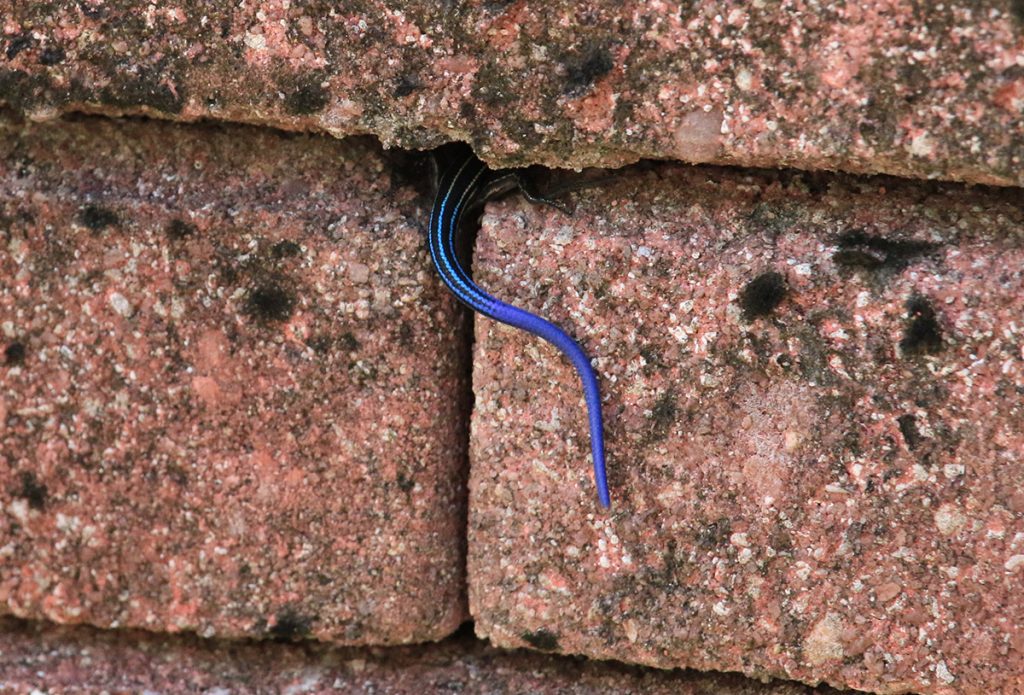
At this size, they have more options for places to hide. What a gorgeous tail.
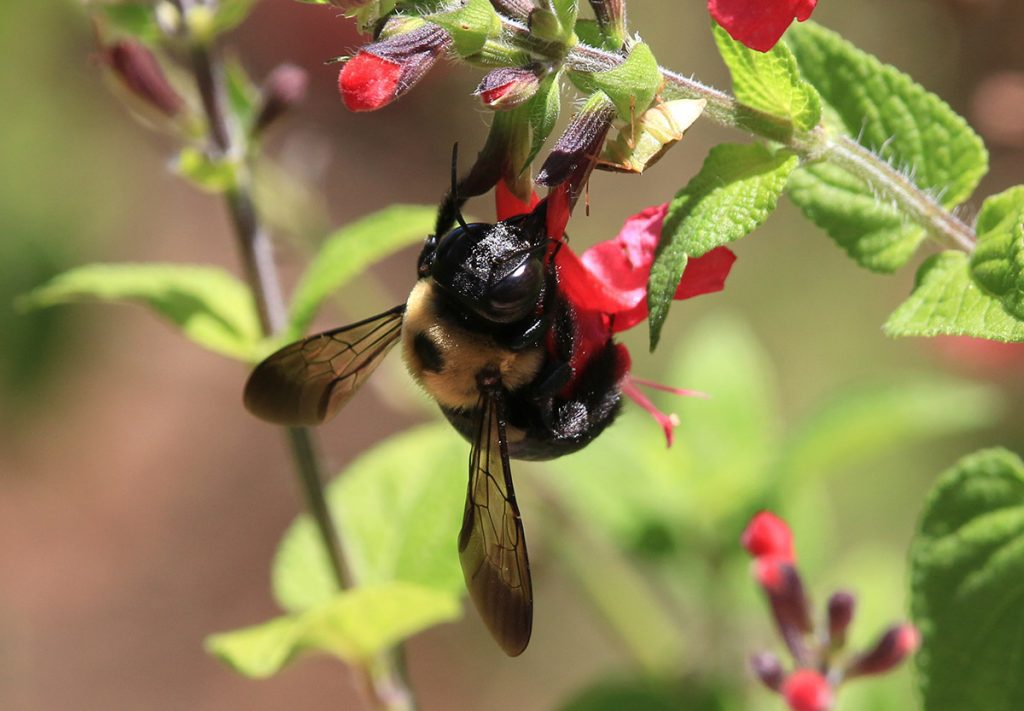
Male eastern carpenter bees have a white/ yellow patch between their eyes. The head of this bee looks like that of the female southern carpenter bee, which has an all black body. We’ll see one of those in a little bit.
July 19, 2020 | Tomato leaf coccoon
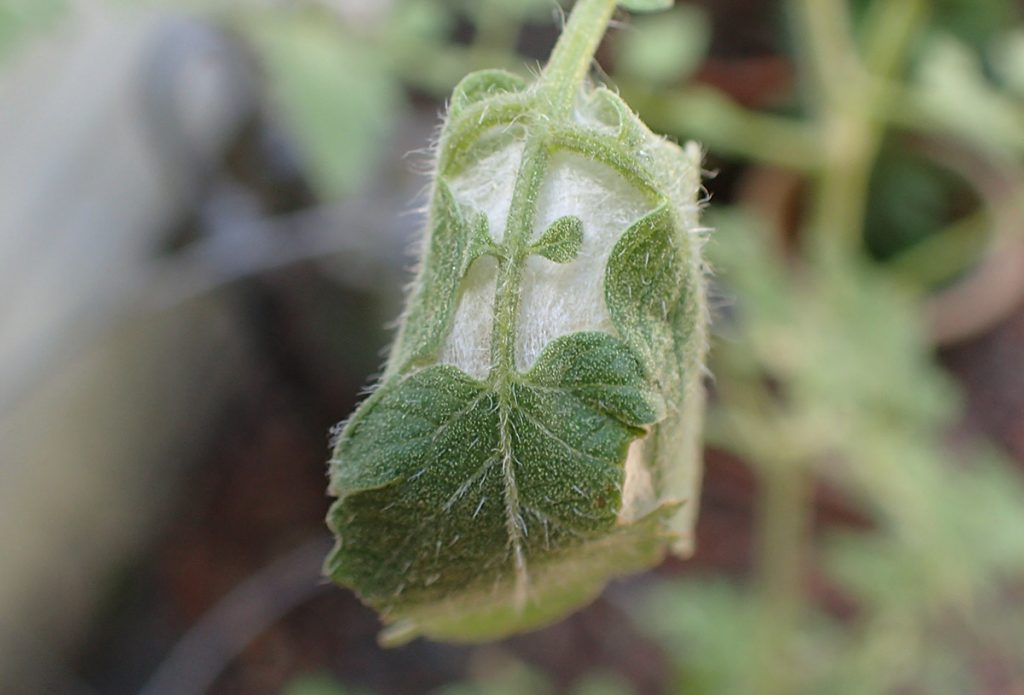
I don’t know what this is. Nothing had been eating the leaves on this tomato plant. It’s not a hornworm. While Google image searching, I did see a couple of images of cabbage looper cocoons that looked like this, and maybe one hosted on another plant and then came to this one?
Here’s a look inside, as best I could see it through its silk.
July 20, 2020 | Hornworms!
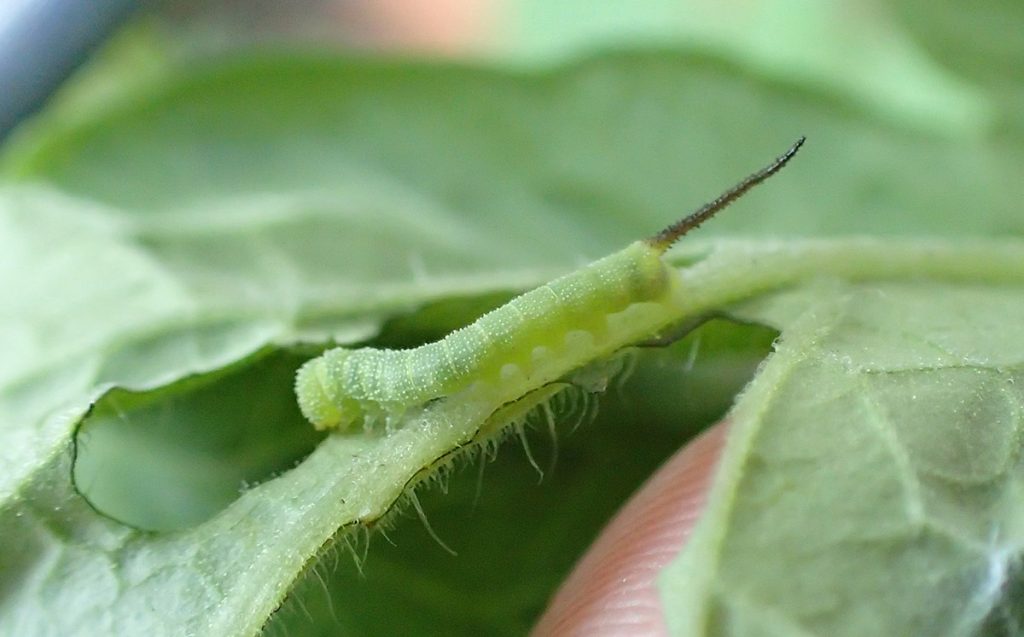
Of course, the very next day I did notice small holes on some tomato leaves. I turned them over and was not surprised to find tobacco hornworms. Working from home allows me to inspect my plants more often on little breaks, and so here I’ve finally caught these before they get huge and decimate my plants. A couple of years ago I looked out the back window and saw three leafless tomato plants, and all that was left was one huge hornworm. So, today, I feel like a more attentive gardener.

Another pest caterpillar? 
Tobacco hornworms in a pyrex dish
I found a few- second or third instar from what I could tell. I think I also found a small cabbage looper. Hornworms become sphinx moths, which are actually really cool. This is, however, one of the few caterpillars I get rid of.
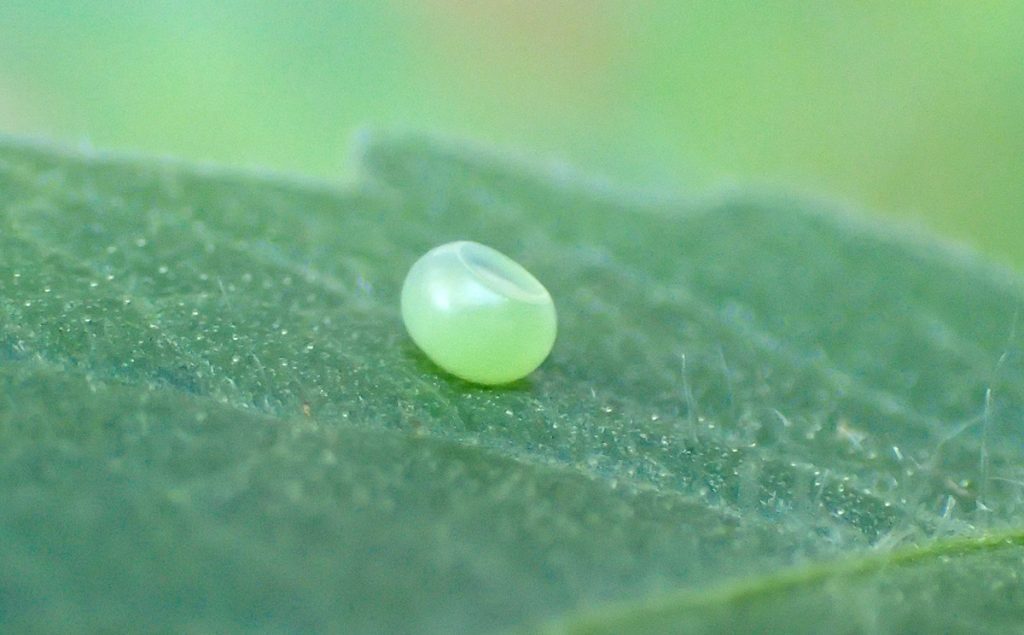
July 21, 2020
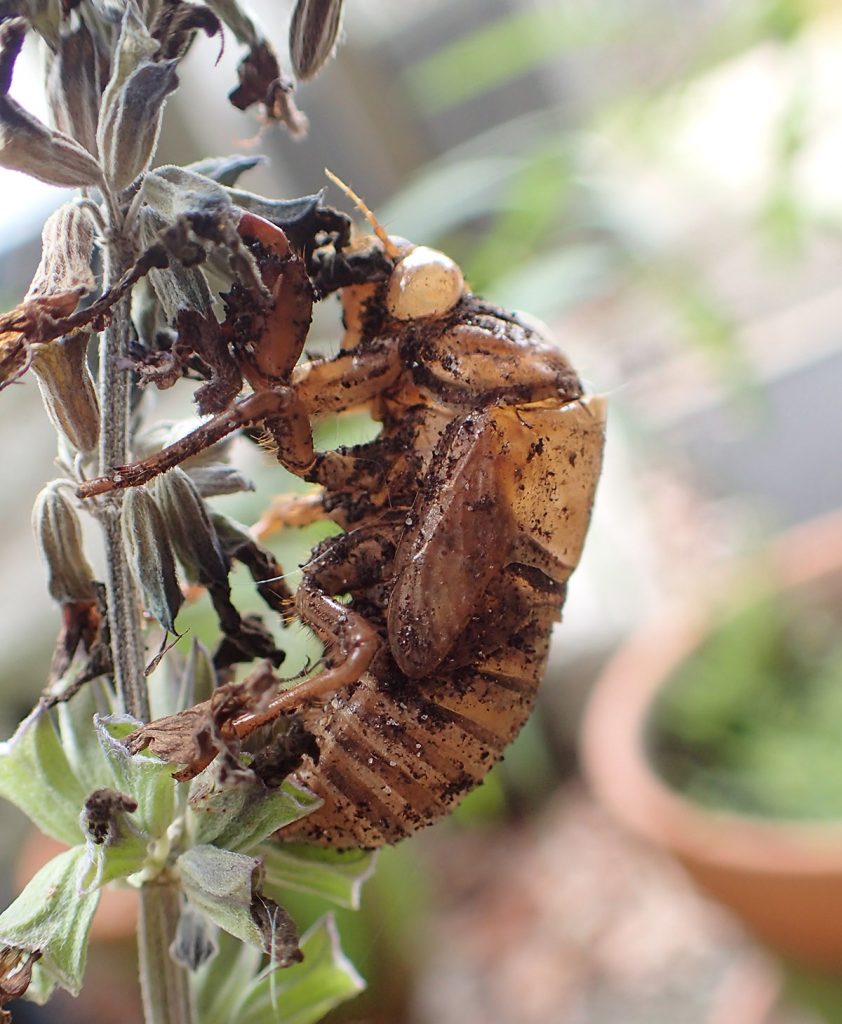
Max’s second grade teacher collected cicada shells. From her, we learned that those shed exoskeletons are called exuviae (plural of exuvia). I ended up finding three of these in our yard, which now grace the workspace Amy and I share.

Horseweed leaves 
Horseweed flowers
Here’s a plant I let get tall and flower. It’s a type of horseweed, which is in the aster family. The flowers are tiny, and the plant is taller than I am. I think this is Erigeron canadensis, but there is also the nonnative Erigeron sumatrensis. I’ve seen bees and wasps visit the flowers, and something ate some leaves. So, it has value to our home ecosystem.
July 26, 2020
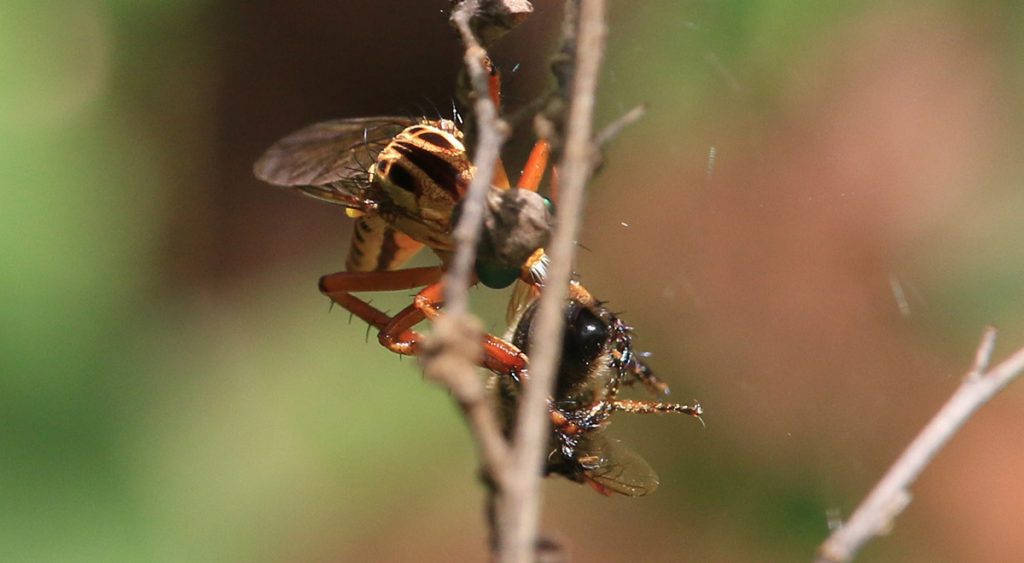
Yard work day started out with this attack- a robber fly grabbing a bee. I last saw a robber fly last July in our yard, so here’s another insect seemingly keeping a seasonal schedule.
As I cut the grass and pulled weeds, the robber fly seemed to follow me around the yard. I think the bee got way. The robber fly was nice enough to pose for me, though.
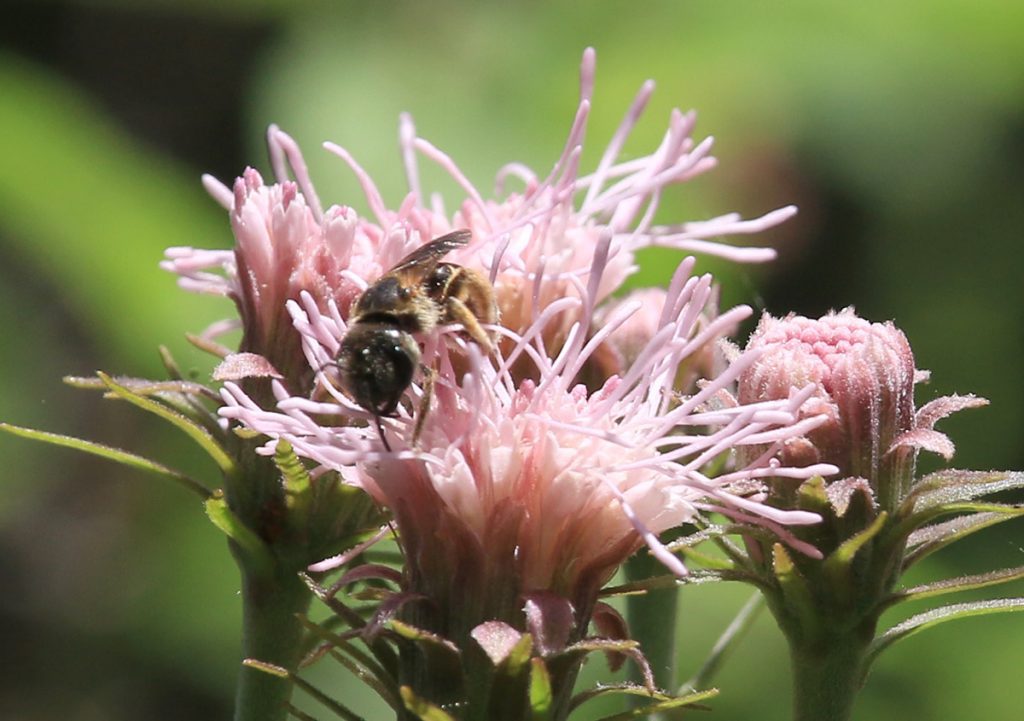
I wish I would have gotten a cleaner look at the bee while the robber fly had it. It may have been this furrow bee, which is taking nectar from the newly bloomed Brickellia. These, the dotted horsemint, and the blue lobelia give us a little extra nectar in mid to late summer.
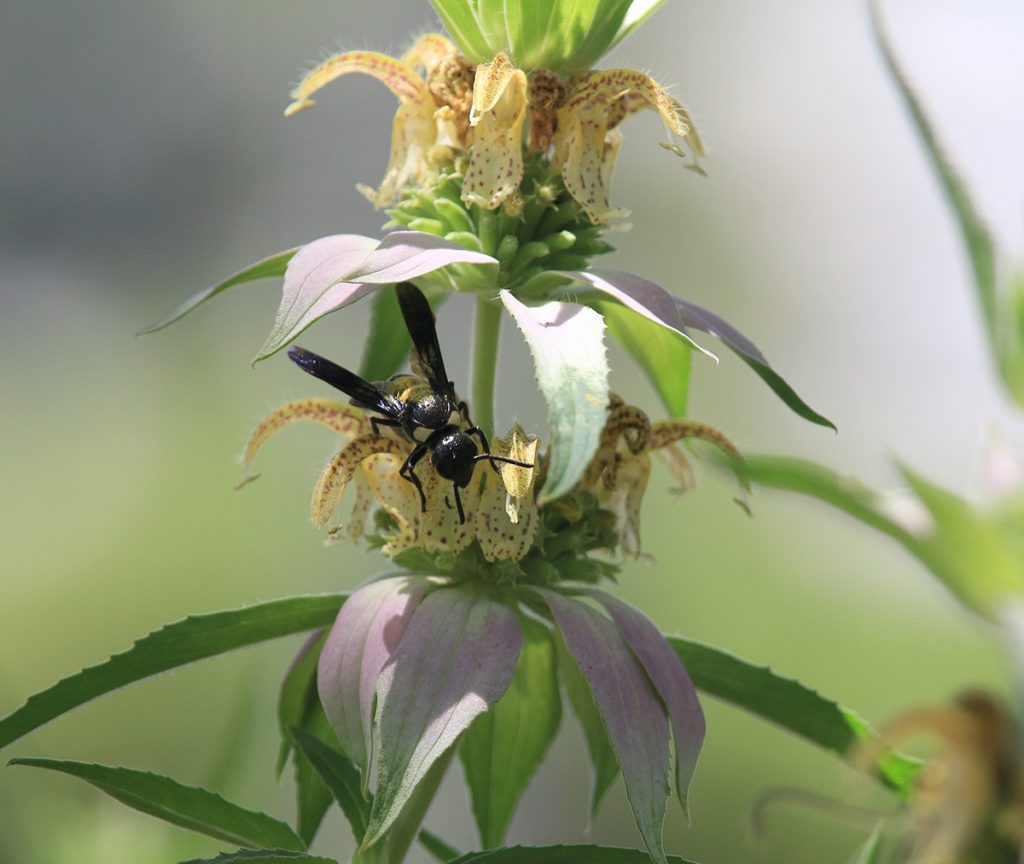
I see four-toothed mason wasps all spring and summer in our yard, usually flying back into their abandoned carpenter bee nests in fence posts and wooden railings. This is the only flower I see them visit during those weeks in the summer when they bloom.
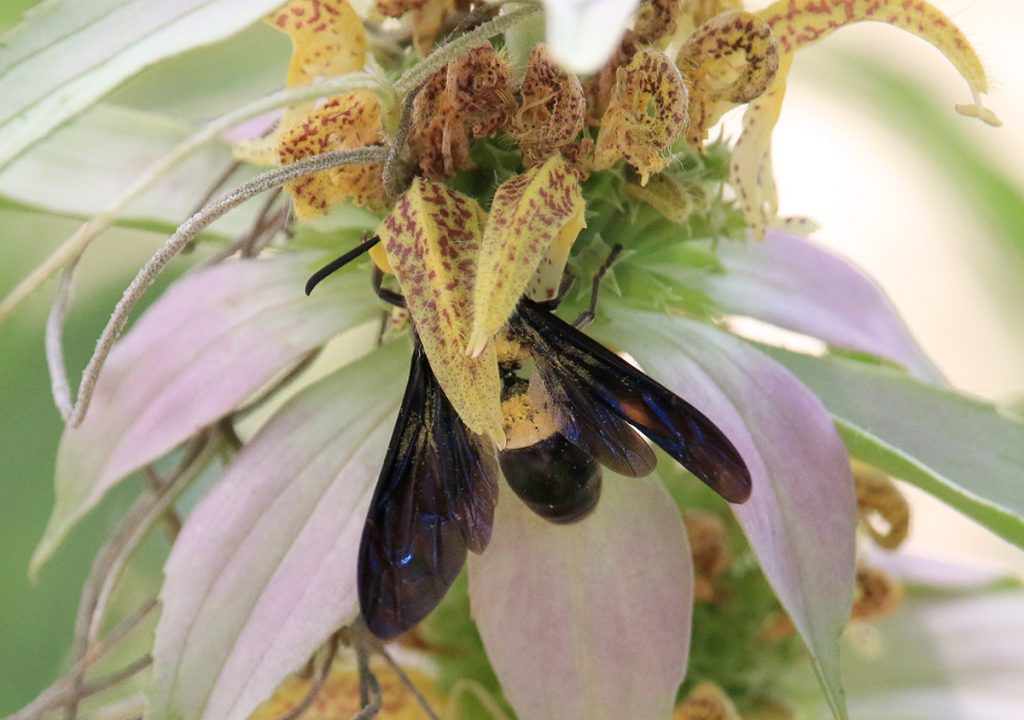
You can see the yellow dust on this one. Last year was our first year with beebalm, as the plant is also known. These wasps look so different when they’re plastered in yellow that I thought I had identified a new wasp species for the yard.
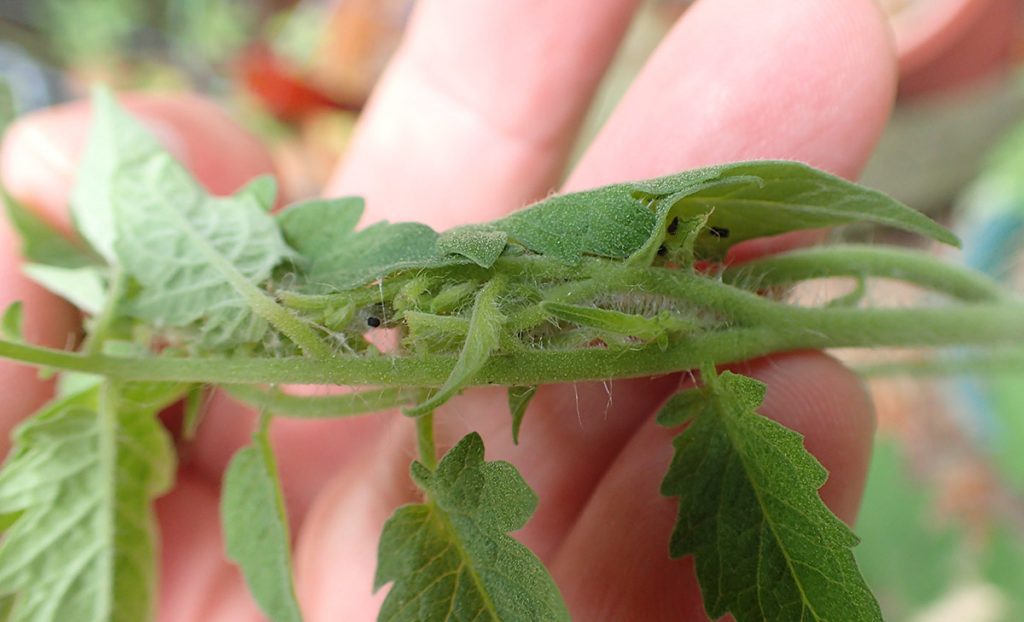
Here’s another insect gluing tomato leaves together for some sort of a structure. I never saw what emerged from this one, or the one I found a few days earlier.
July 29, 2020
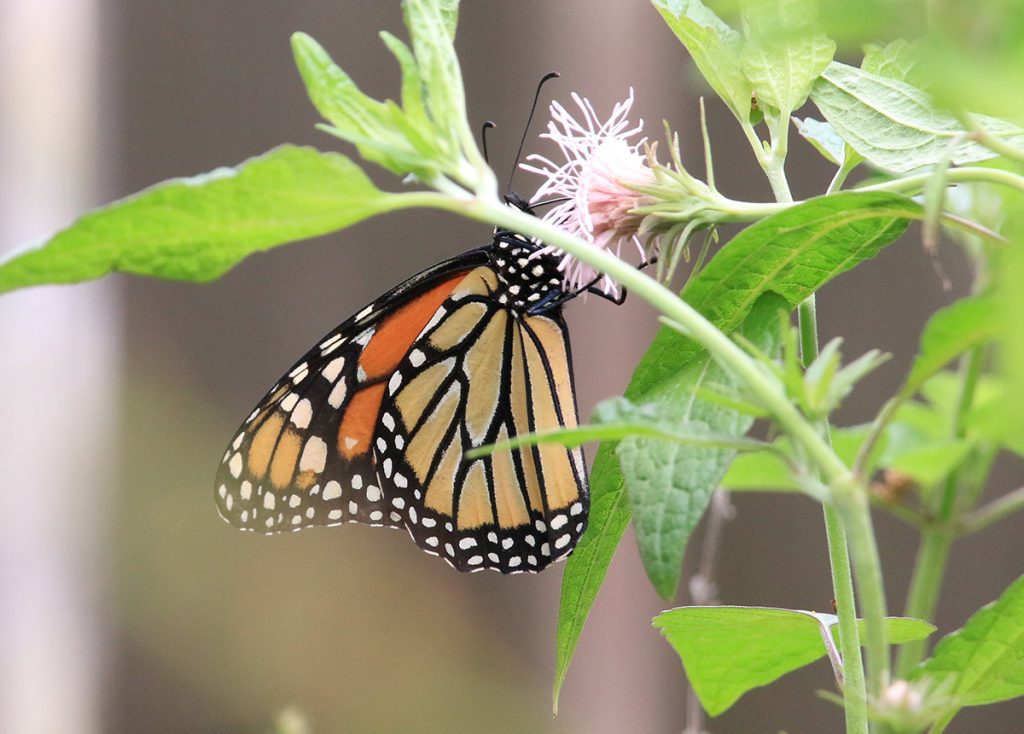
Twenty three days after I last saw caterpillars, could this be a home grown monarch butterfly? I saw one more adult around this time, and neither laid eggs on our untouched, abundantly leafy milkweed.
August 1, 2020
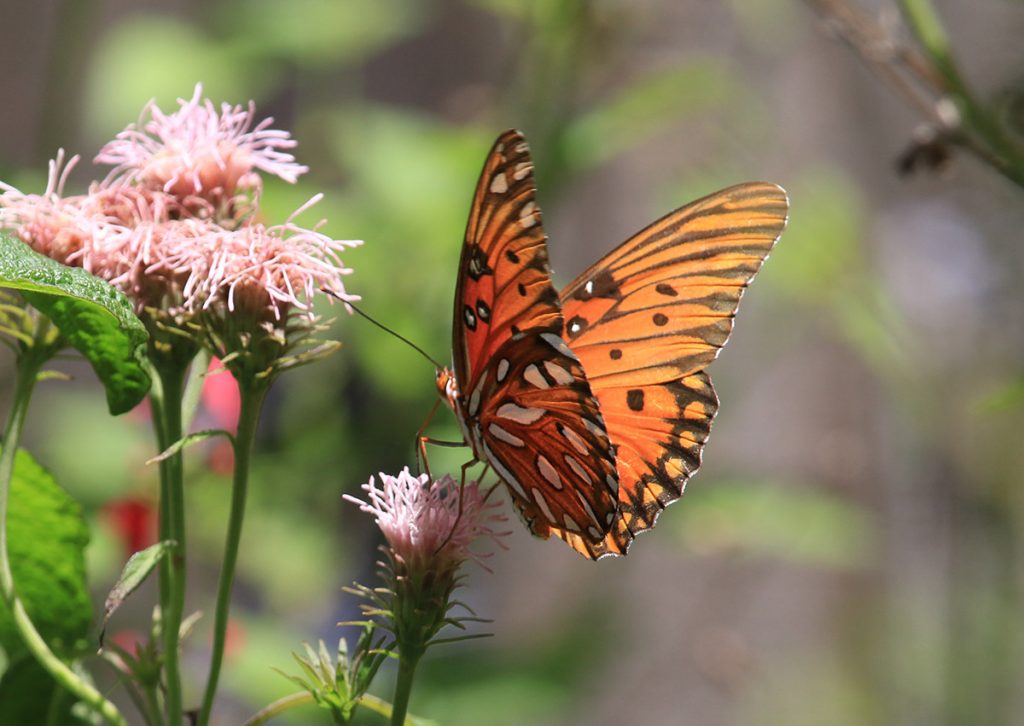
The Brickellia flowers are popular this year. I had been thinking to myself that I hadn’t seen gulf fritillaries all year, but they soon became regular visitors.
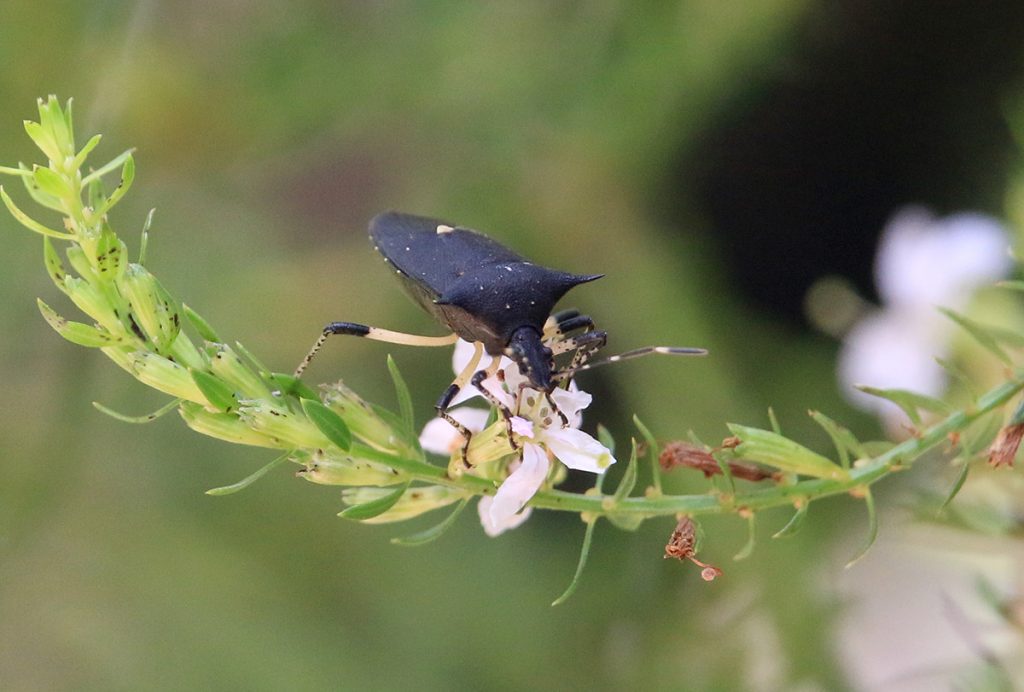
Nearby I saw this black stinkbug crawling across flowers.
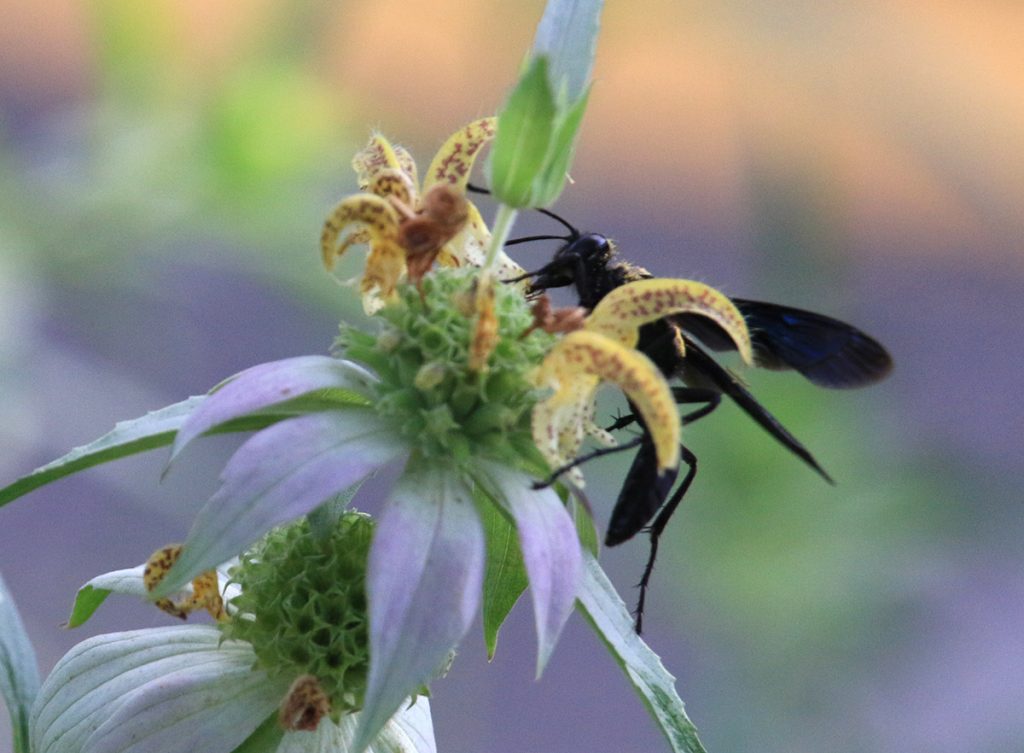
This flower patch is apart from the loosestryfe/ red sage/ coneflower/ Brickellia/ fanpetal patch in the backyard. I planted this patch from seed packets given out by the Florida Native Plant Society at Tallahassee Science Festival one year. Plenty of lance-leaved coreopsis grow here as well, but haven’t bloomed. The bee balm grew big and leafy throughout the year, and bloomed more profusely than last year.
After a bee-heavy May and June, we hit a small lull in July. When the bee balm bloomed, we started seeing a lot of different wasps, more species than we’d seen last year. The great black digger wasp is a cool one, and one I now see around the other flower patch, walking on the ground. Do we have a nest in the yard?
August 2, 2020
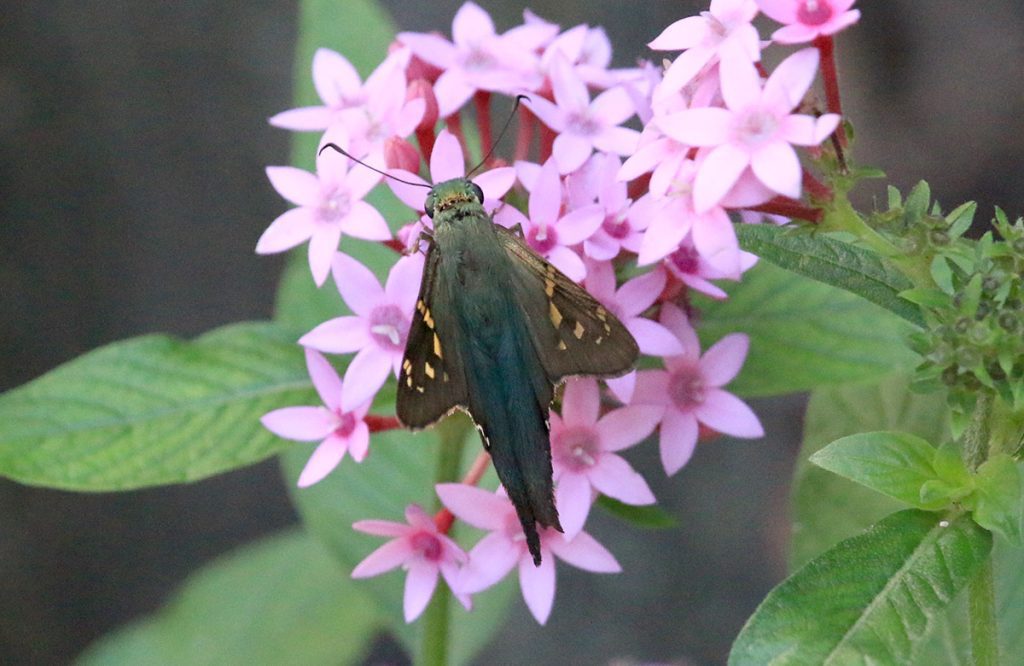
I hadn’t seen a long-tailed skipper in a few weeks. But it again became a regular in the yard.
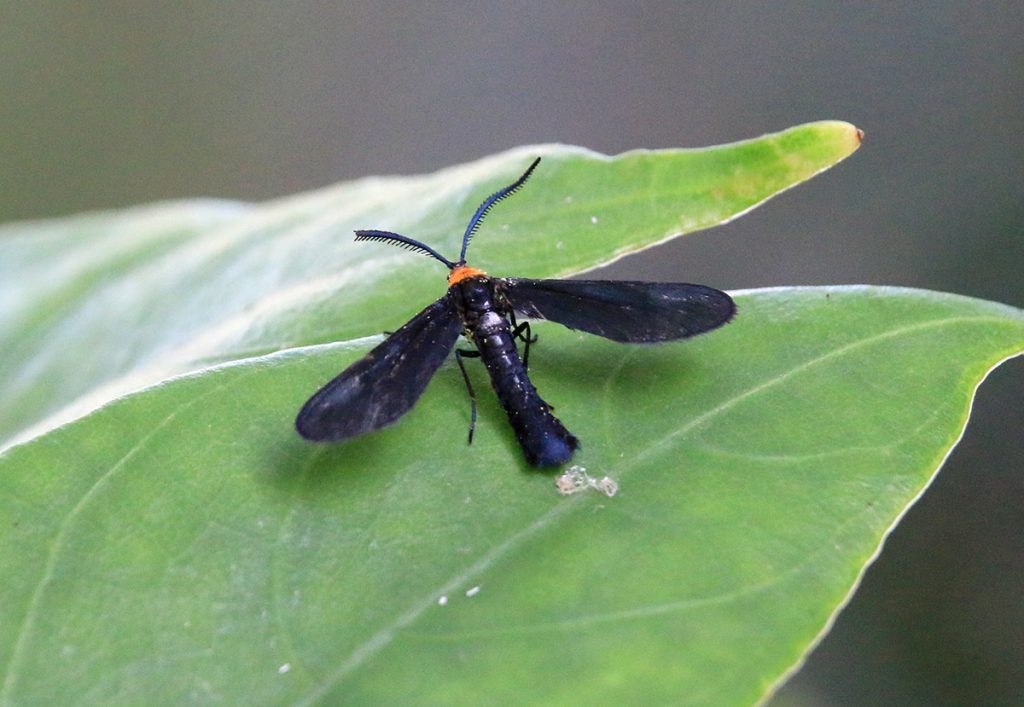
This moth hosts on grape leaves and the leaves of grape family vines, especially Virginia creeper. By the way, the Leon County IFAS Extension helped us put together this guide to woody vines in our area, so many of which have ecological value.
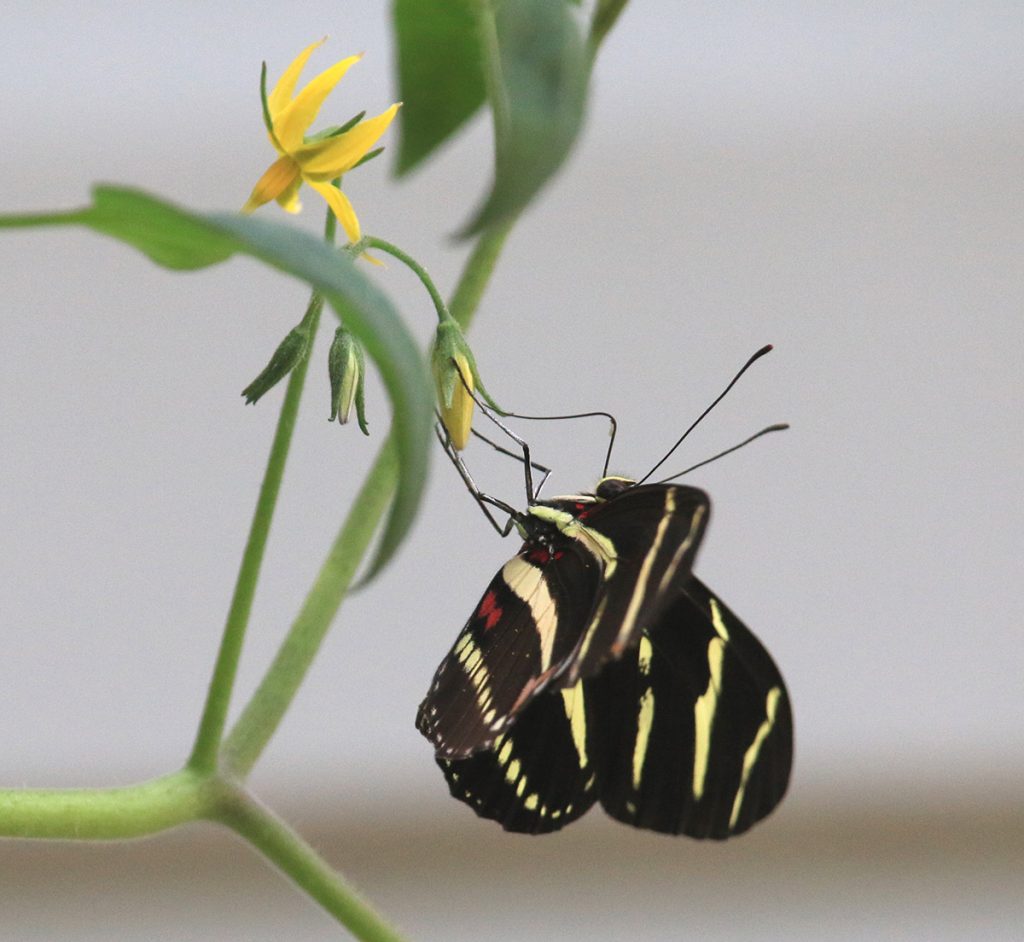
I’ve been so rabid about native plants and insects for so long, I had forgotten where that interest originated. Once, all I wanted to do was attract pollinators to my tomatoes, peppers, squash, eggplants, etc. I wanted to know what was eating their leaves. This search for knowledge was a gateway into a whole world of its own. The zebra longwing on this tomato flower reminded me of the selfish origins of my pollinator obsession.
I think it’s okay to have selfish reasons for attracting bees, butterflies, wasps, moths, and pollinating flies and beetles. That doesn’t change their requirements- nectar, larval food, spaces to make nests.
Speaking of nests, here’s another red-marked Pachodynerus wasp visiting nest cells
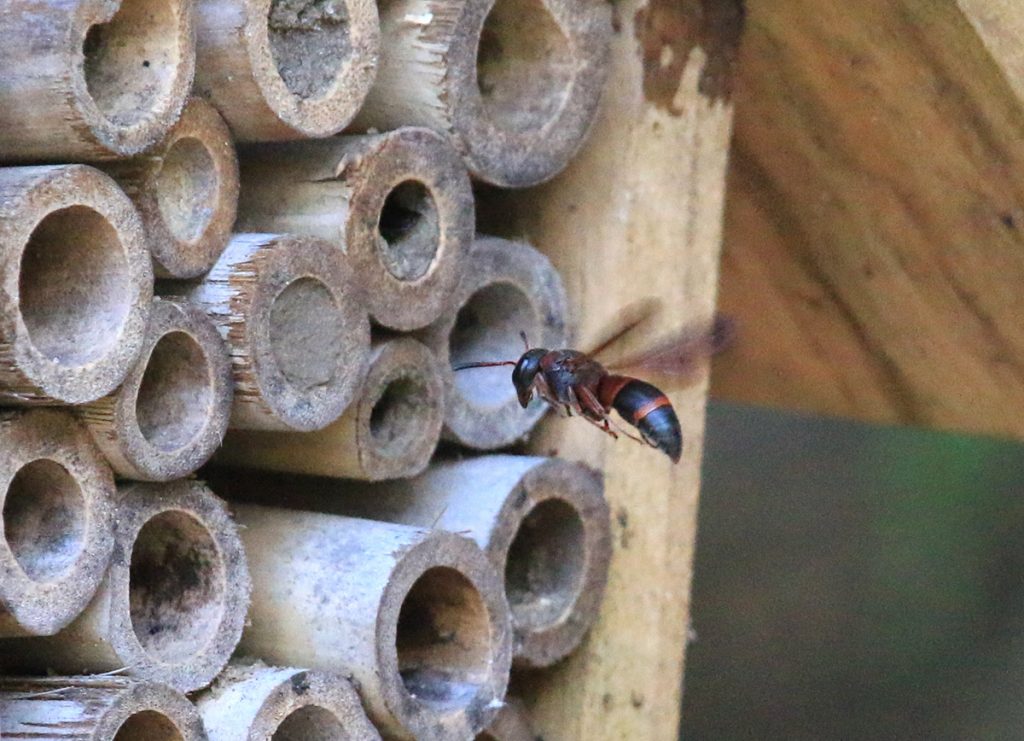
We’ve had so many of these wasps, I was starting to wonder if they weren’t in some way responsible for the lull in bees that we’d been experiencing. Last year, August was the big bee month. June was a crazy month this year, but we’d taken a long vacation last June, so I couldn’t say whether we had a busy bee June 2019. It could be that we have two peaks every year, with a lull in July. We’ll soon see whether we’ll hit another August peak.
August 4, 2020
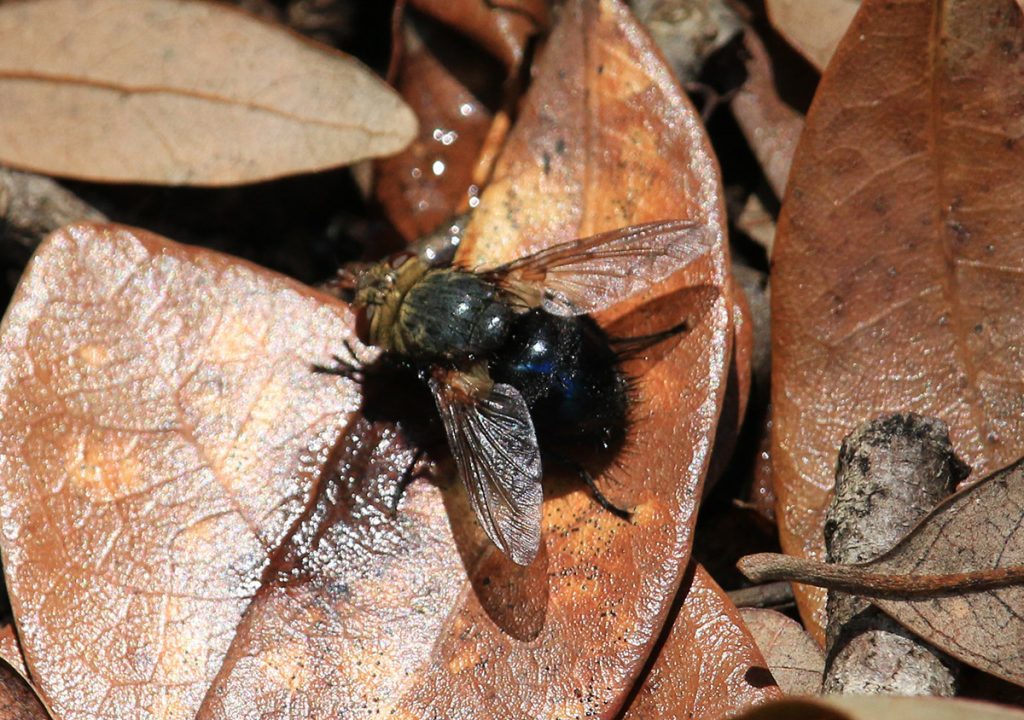
This is a large tachinid fly. These are parasitoid breeders.
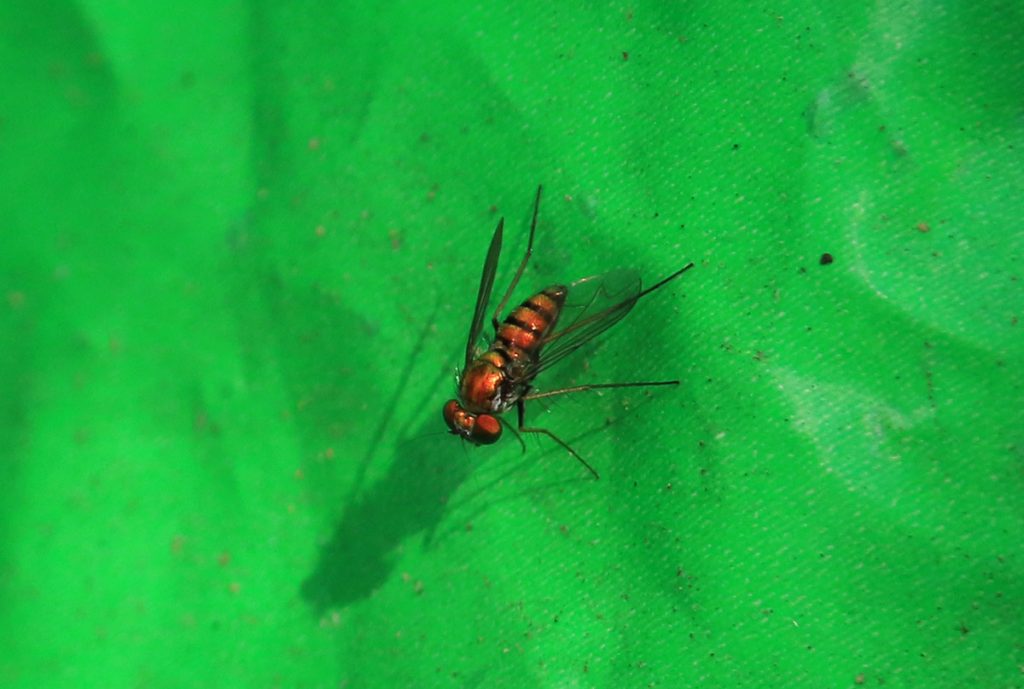
I see long-legged flies of many colors in the yard. I ID’d one like this in iNaturalist and come up with the genus Condylostylus, though no one confirmed it. These are aphid hunters.
August 8, 2020
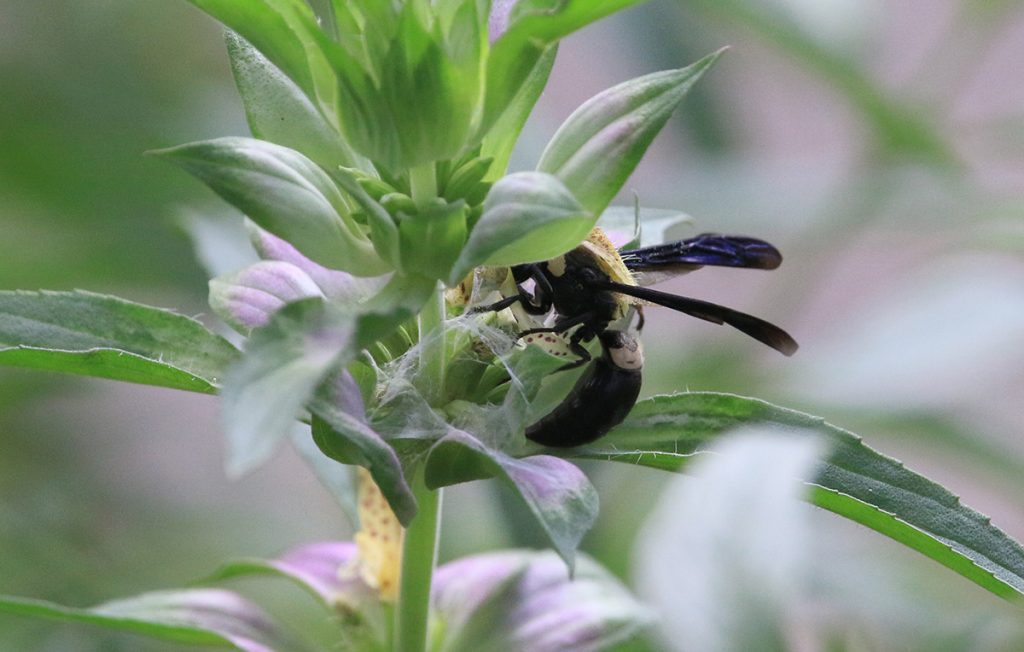
Wasps and bees are moving quickly through the dotted horsemint. It takes some patience to photograph as many species as possible, but I will eventually start getting those pics.
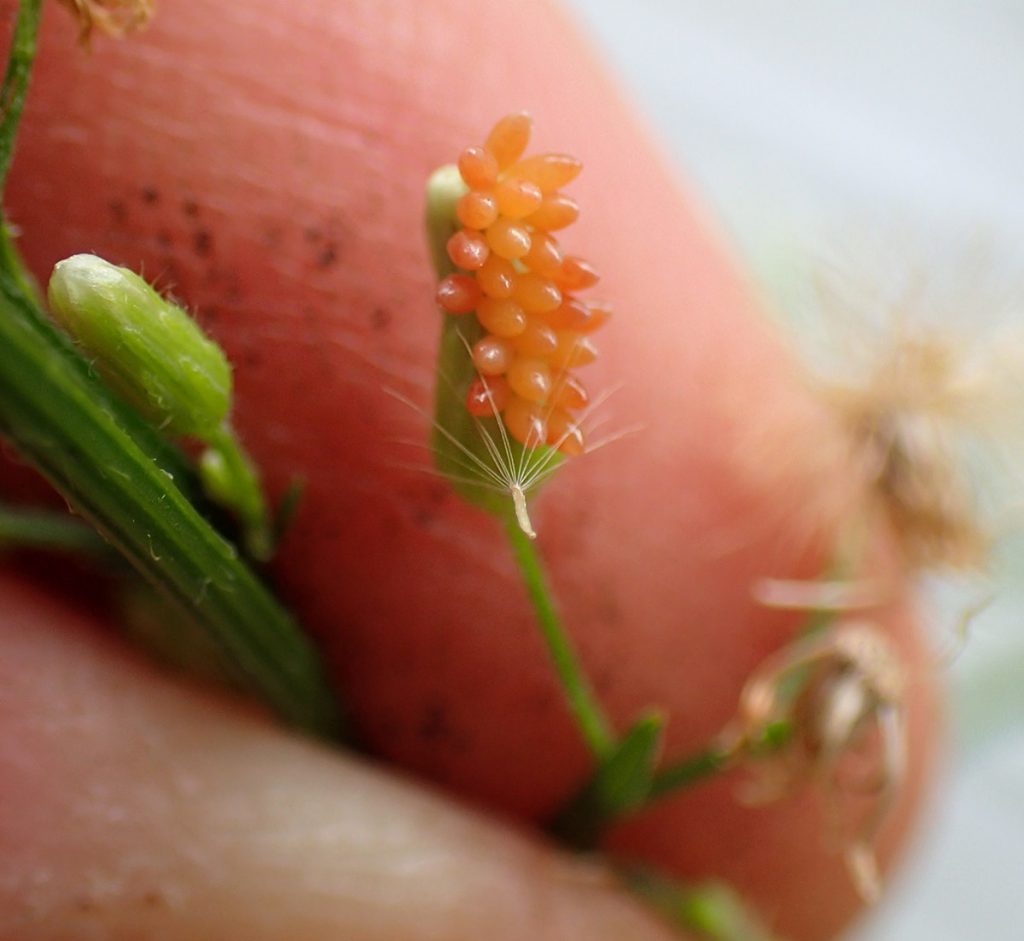
I’m fairly certain these are ladybug eggs. Another beneficial predator.
August 9, 2020
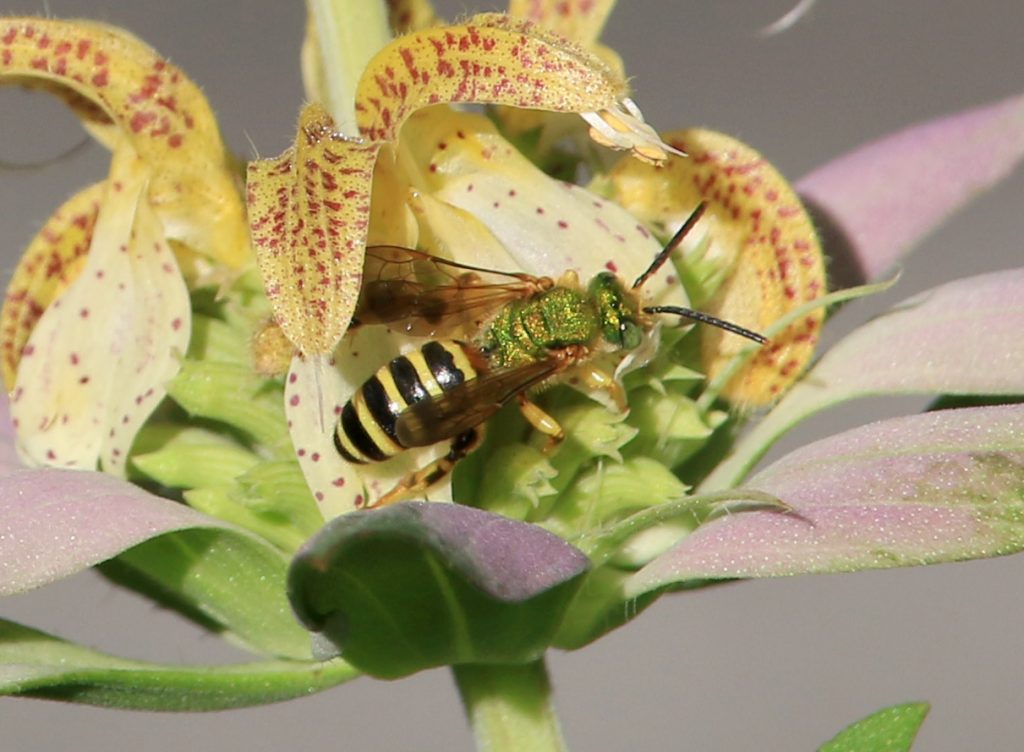
Just like last August, I’m starting to see more and more of the males of this species every day. So far, they’re sticking to the bee balm. A couple of months ago, I learned that their females closely resembled green Augochlorine bees, which are also in our yard. Before that, I hadn’t known that I’d been seeing brown-winged striped sweat bees as early as June.
I guess I’ve been seeing their mothers on our flowers, and now these grown boys are out and feeding themselves on our flowers?
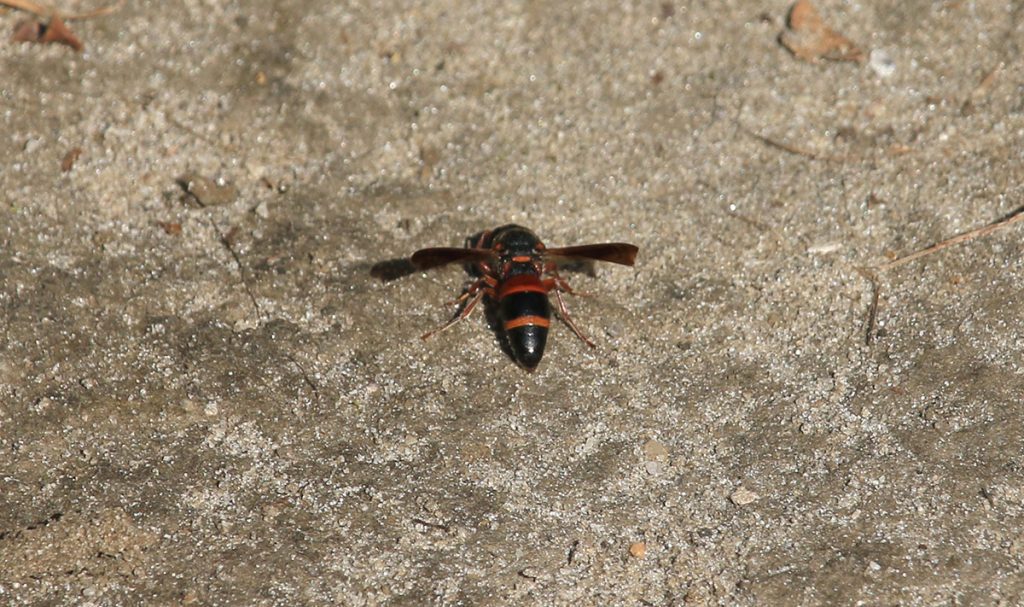
Here’s the red-marked Pachodynerus wasp gathering dirt to cap its nest.
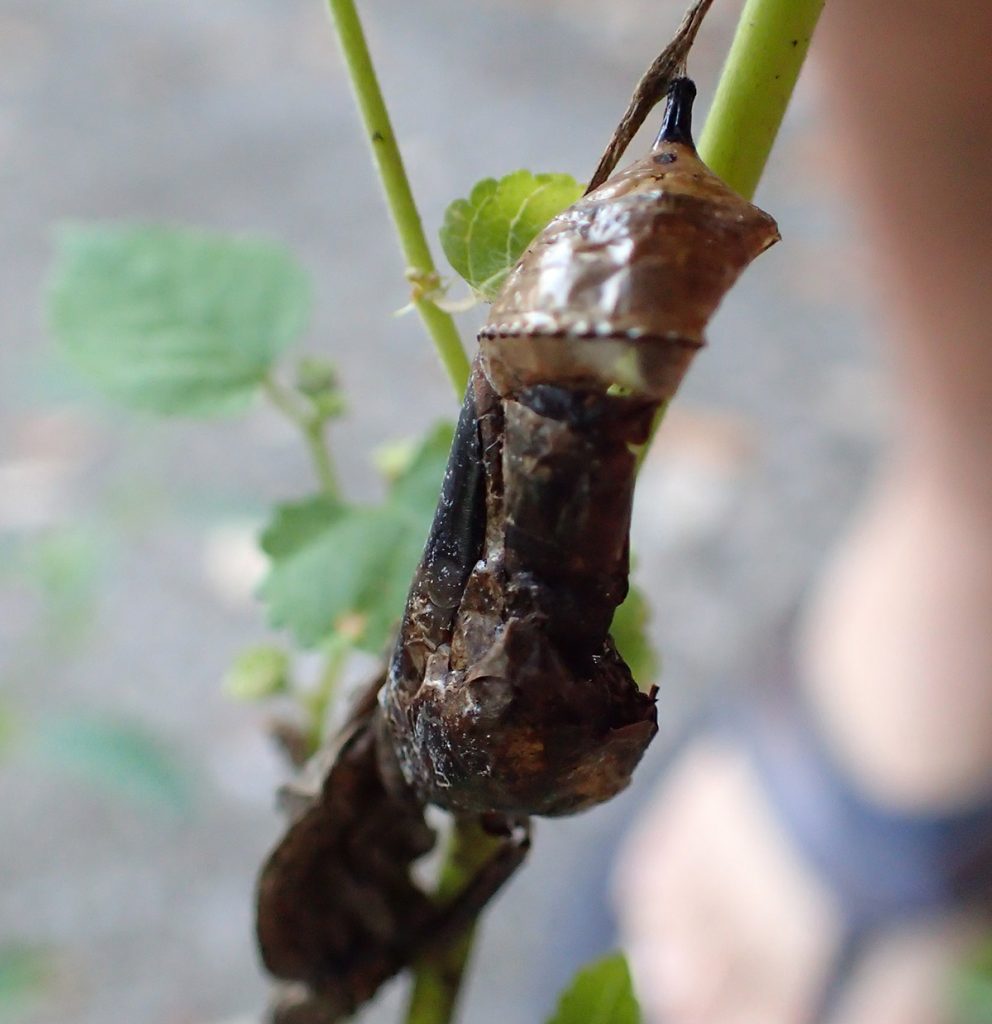
I saw a couple adult monarchs that could have come from our early July caterpillars. This one had a less successful fate. I spotted it while watering the plants.
August 10, 2020 | Carolina mantis
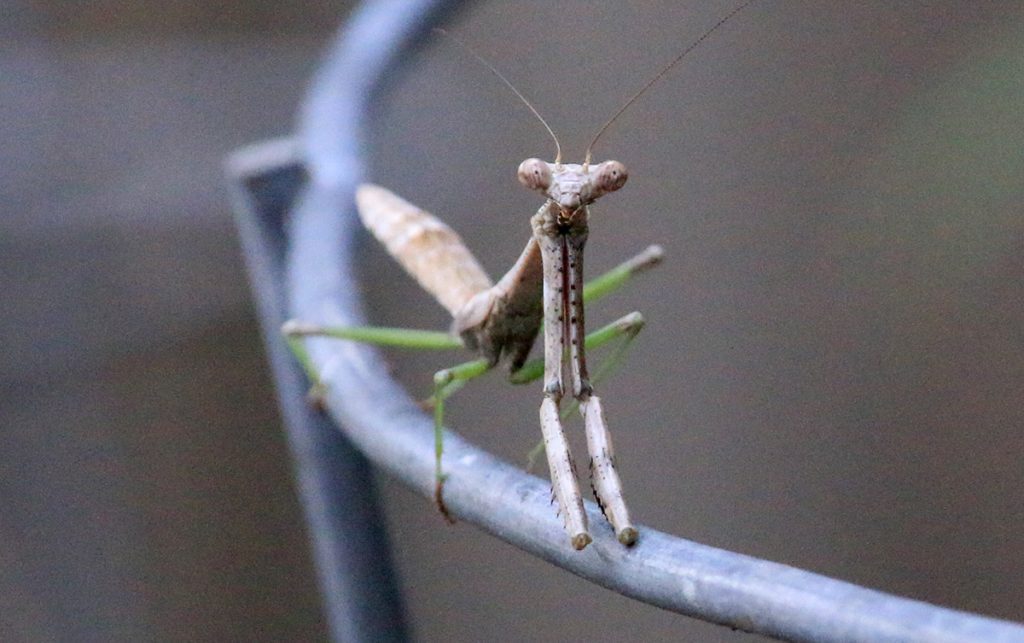
I’d never seen a mantis in our yard before. I kept taking breaks in the yard, hoping I’d see it with an insect meal. No luck, though.
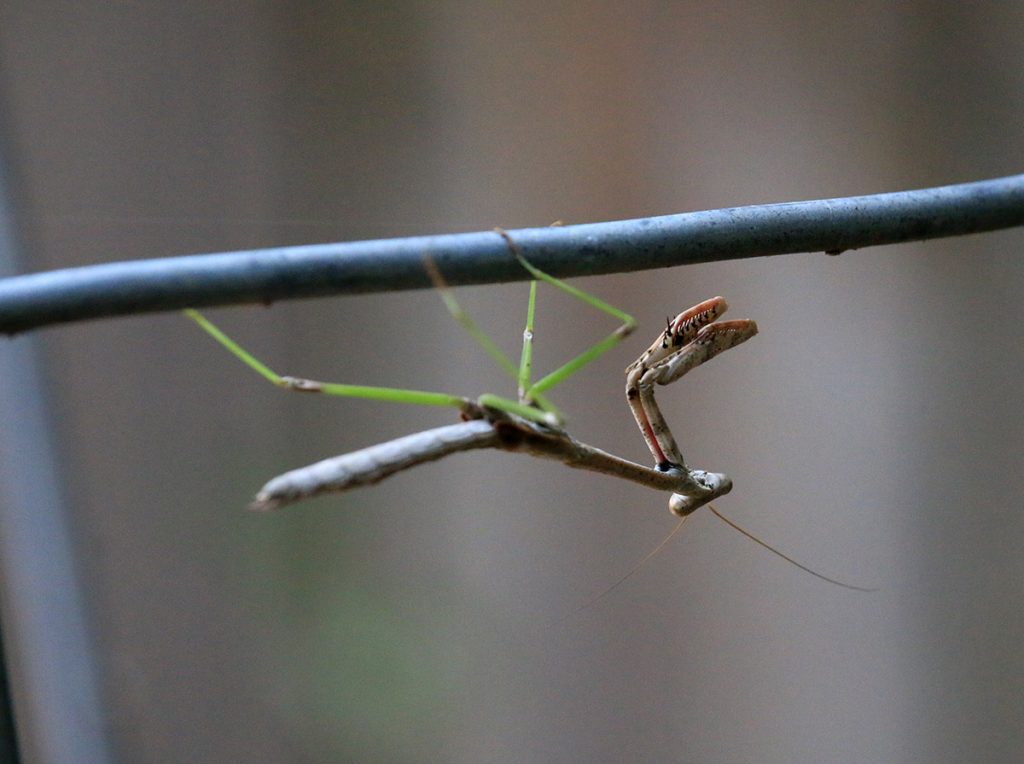
We’re a PBS family, so after I brought the kids out to see it, they watched an episode of Wild Kratts about mantids.
August 12, 2020
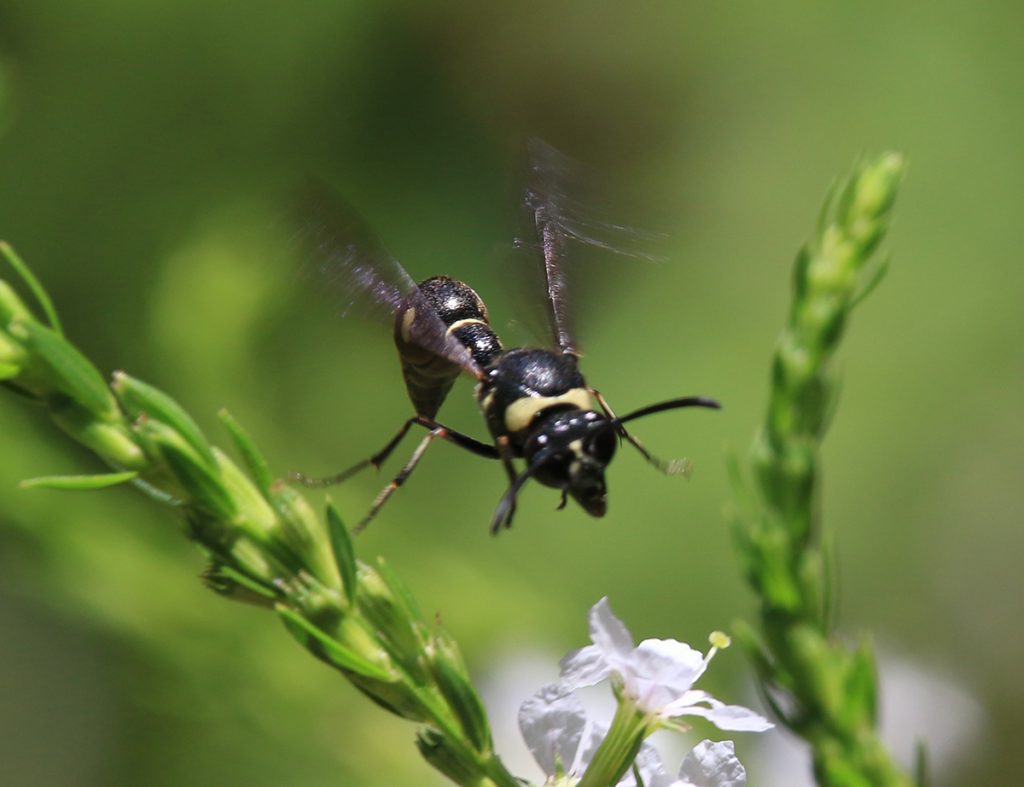
As wasp diversity increases on the dotted horsemint, we’re seeing different species of wasps in the other flower patch as well.
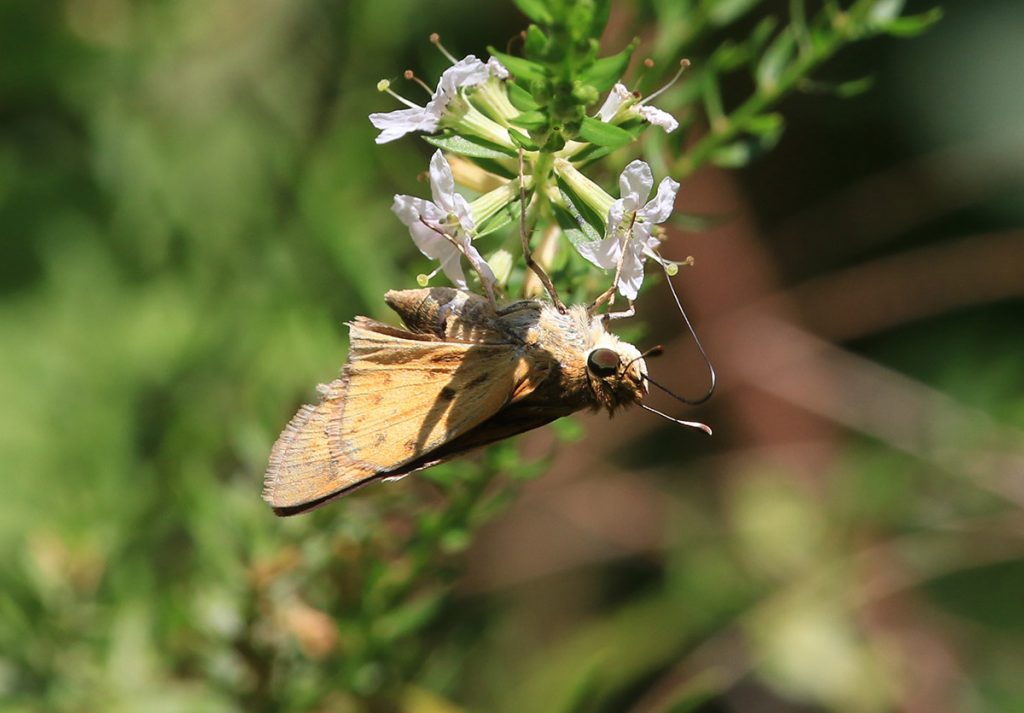
Fiery skippers have been a presence in the yard since spring began.
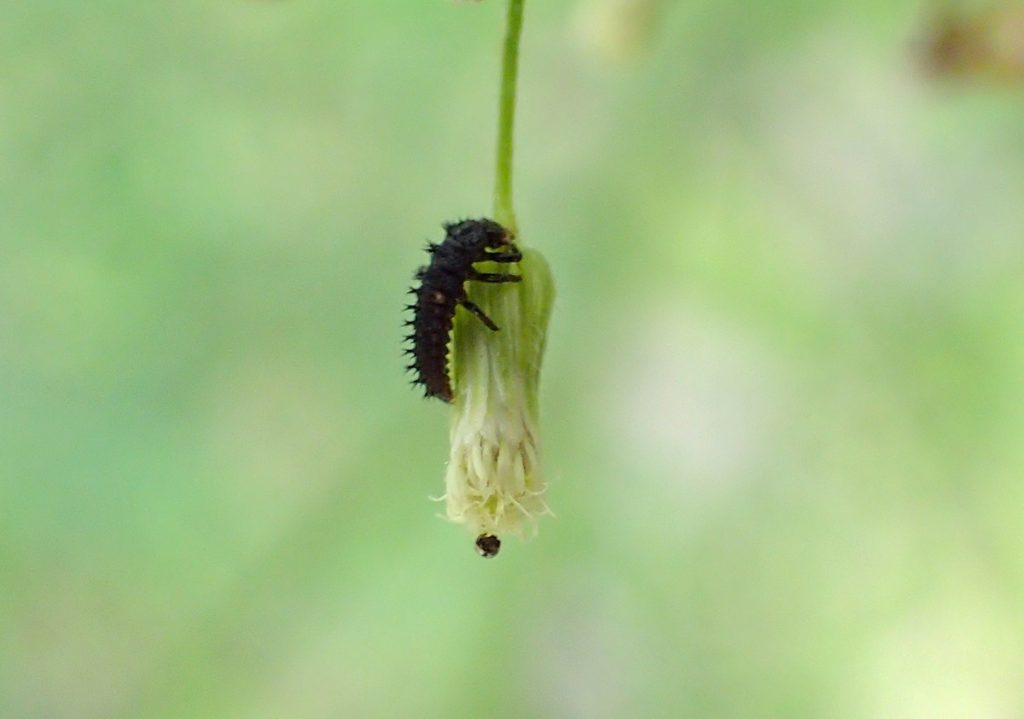
Here is a horseweed flower going to seed, with a small black ladybug larva on it. I didn’t see them again; I think maybe a few shots of them later on would have helped me identify a specific species.
August 14, 2020
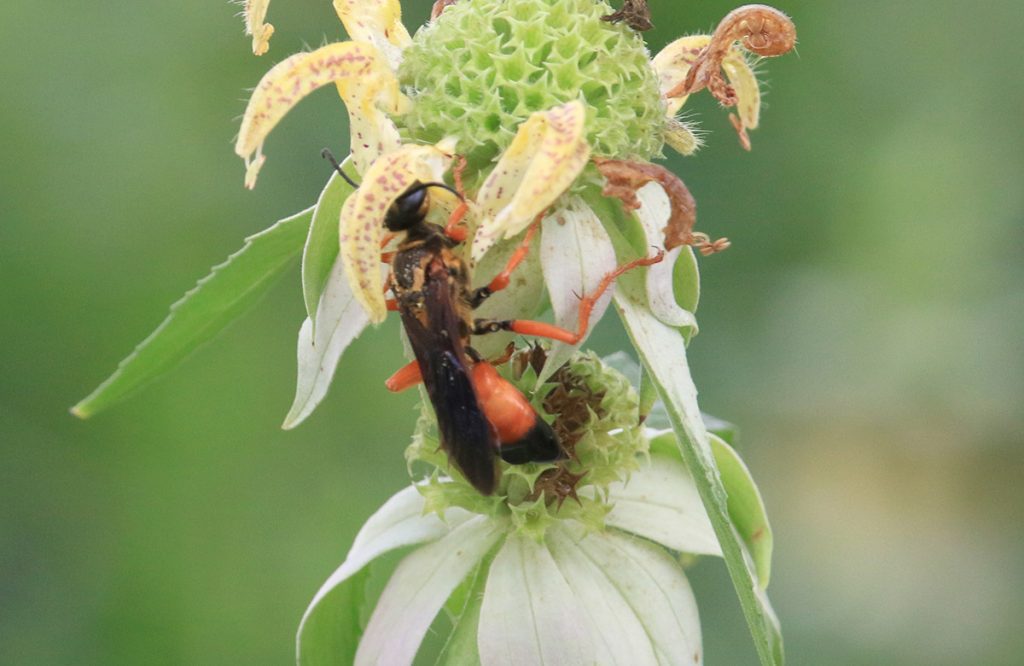
I’ve been seeing a couple of these in the bee balm patch, moving quickly between the flowers. It can be hard to pick an insect to follow here, as several bees and wasps are now zipping between a few dozen plants.
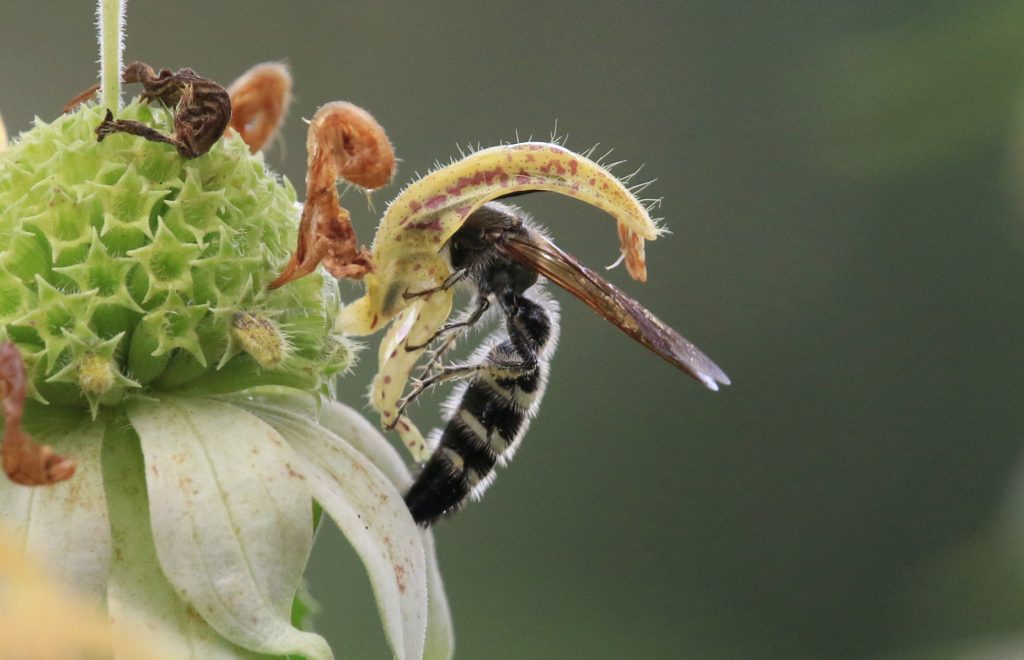
We’ve been seeing a couple of these wasps in our other flower patch, so I’m happy to have new nectar sources become available throughout the summer.
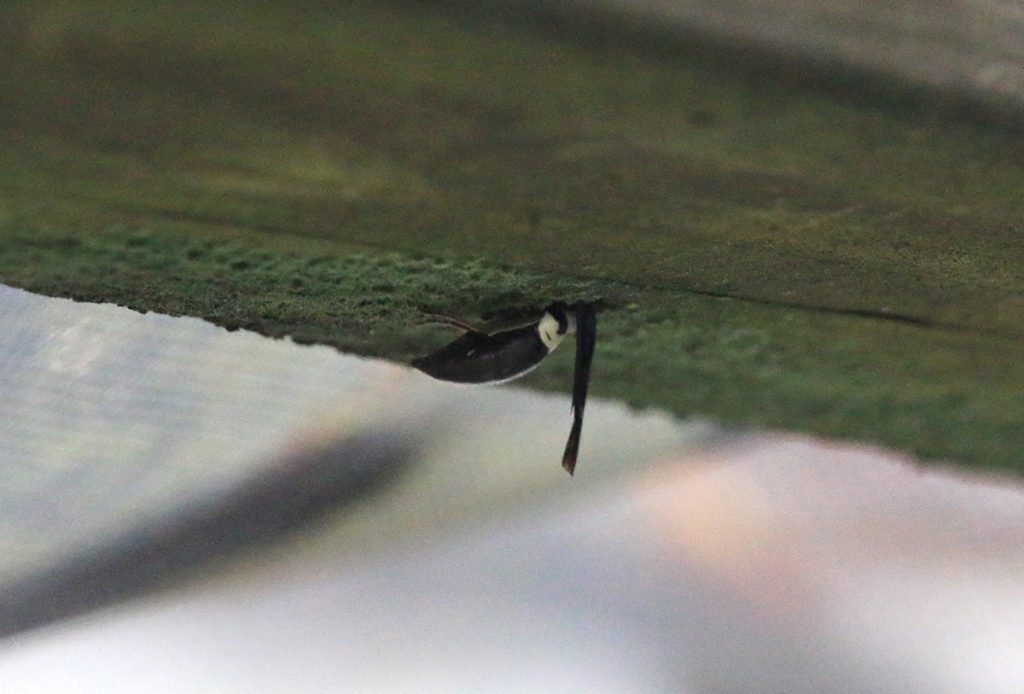
This abandoned carpenter bee cavity has ben used by four-toothed mason wasps for years. When I see one zipping to the nest, I don’t always have a camera. I just barely caught it going in.
August 16, 2020
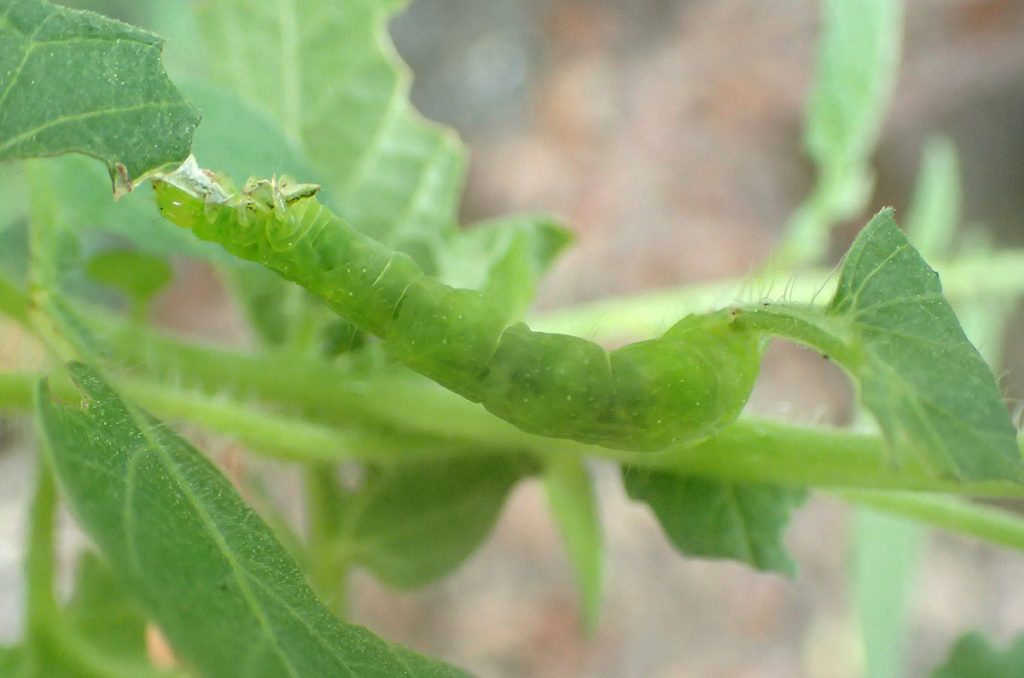
Again, I saw some nibbled tomato leaves and went searching. I think this is a cabbage looper. Would you look at how closely it matches the hue of the tomato leaves?
August 18, 2020
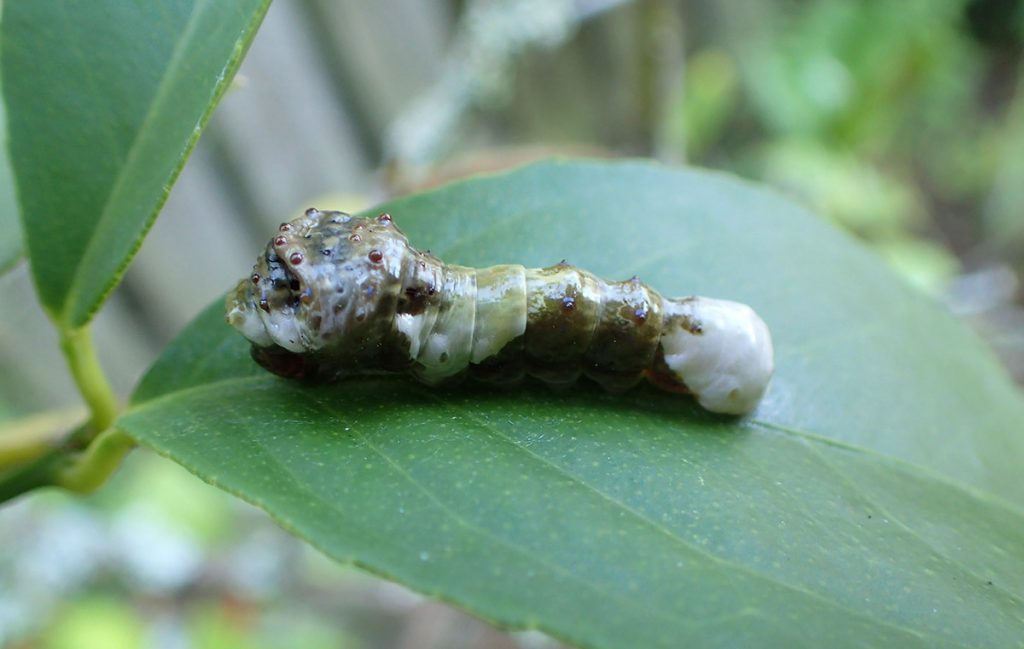
We went to a friend’s house over the weekend for a socially distant backyard get together, and I watched a giant swallowtail linger on a few spots on their Meyer lemon tree, likely to lay eggs on its host plant. It put the thought in my head to take a quick look at ours, and what do you know? It’s been raining a lot, so I haven’t been watering the plants. This is when I notice the most caterpillar activity, unless something is eating our tomatoes. This one had gotten big without my having noticed it.
August 19, 2020
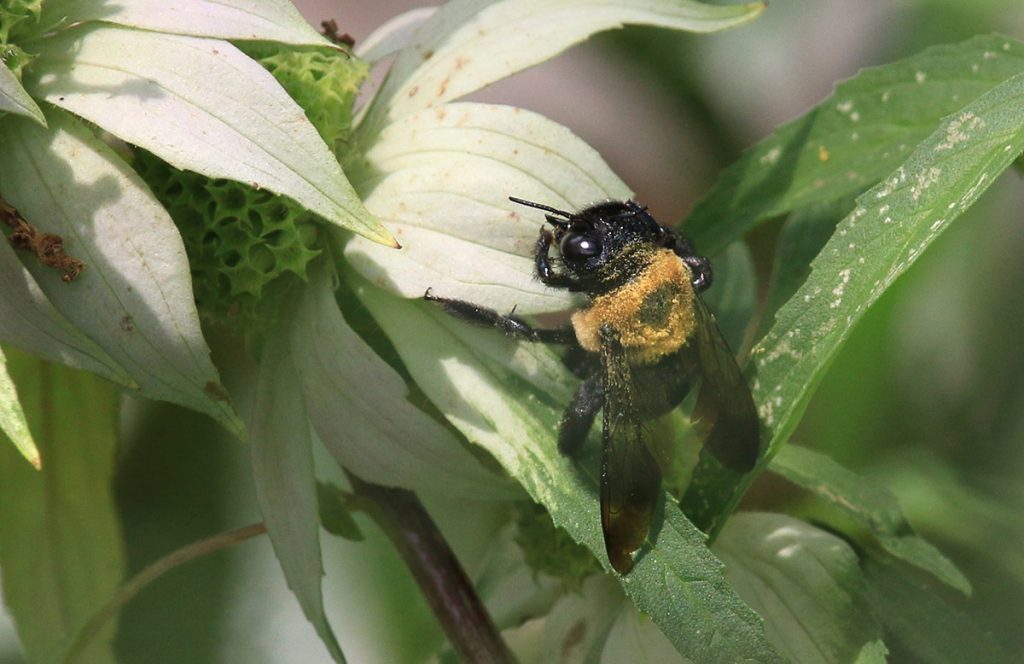
This carpenter bee has been active in the yard lately.
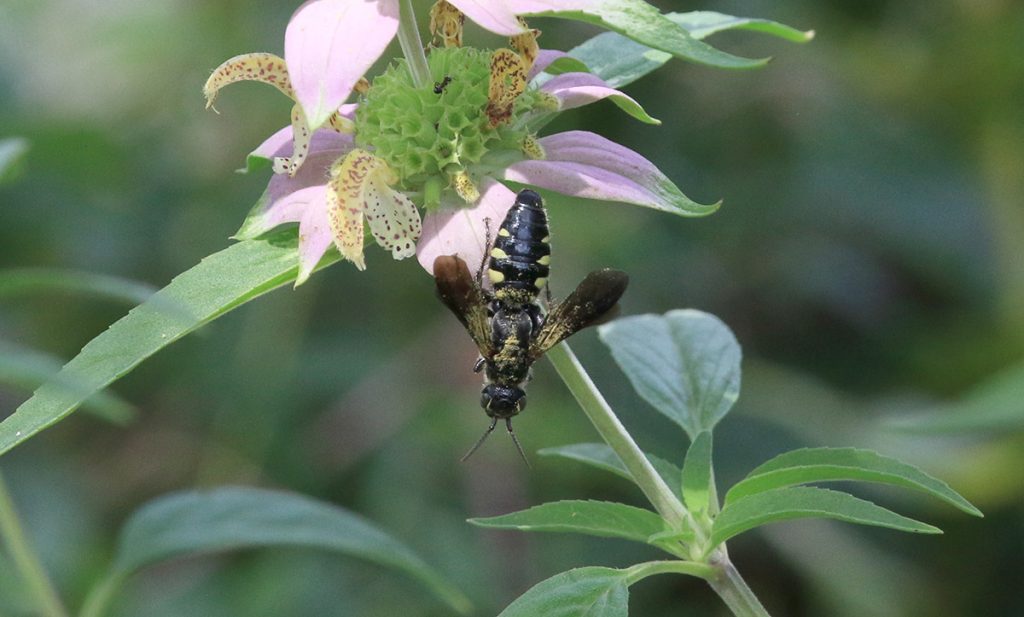
Myzinum obscurum is my iNaturalist guess, but no one has verified it yet.
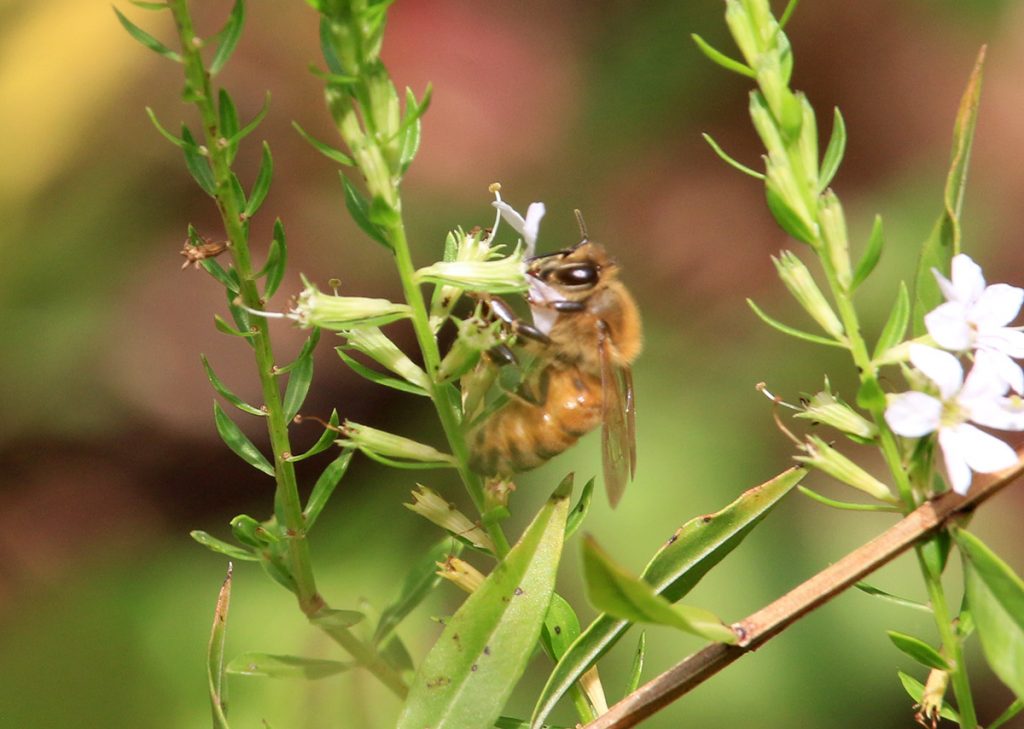
We had honeybees pretty consistently earlier this year, and we’re now seeing one or two in the flower patch these days.
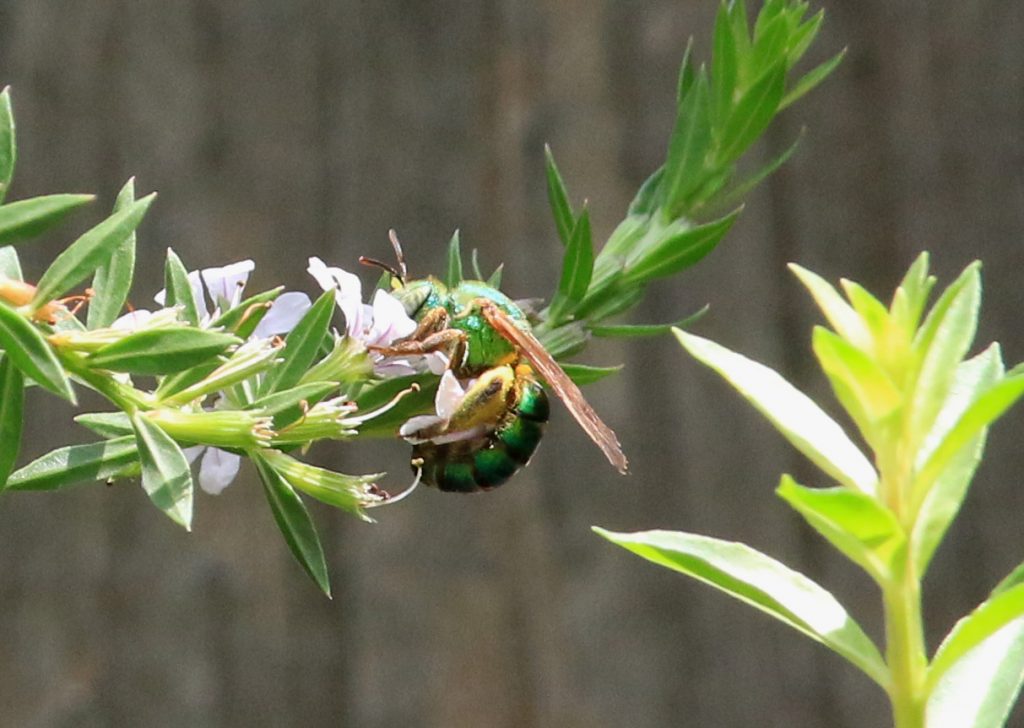
Still seeing plenty of female brown-winged striped sweat bees in the yard along with the males. It does seem like we have way more males, though.
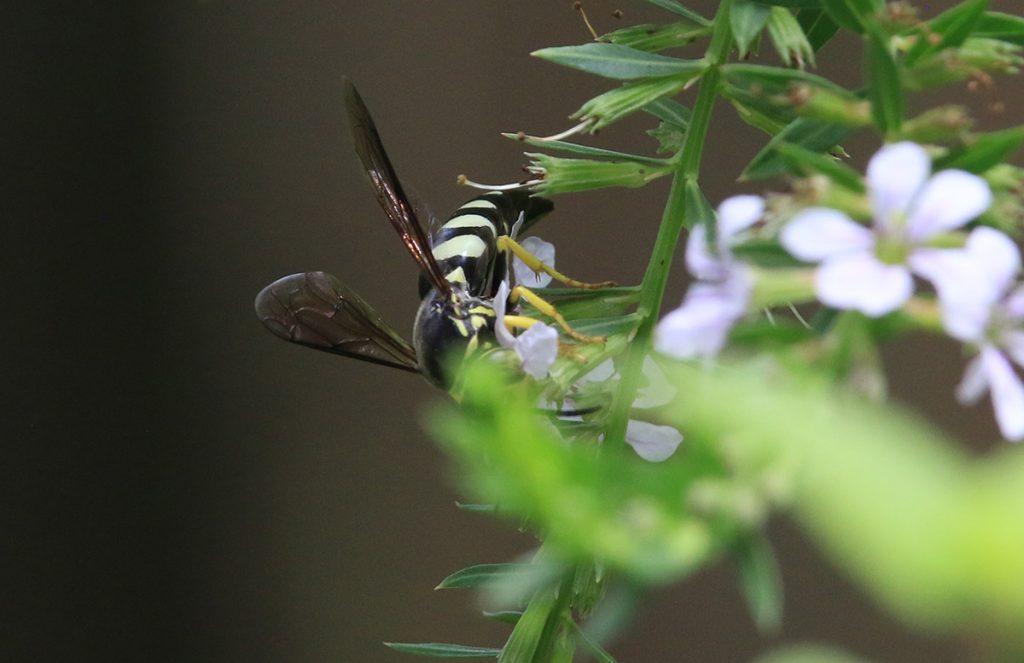
A few weeks after seeing a stink bug crawling on this plant, we see a wasp that hunts stink bugs. This kind of thing is why I like to leave as many insects in the yard as I can, if they aren’t tearing up certain plants. In the last couple of months, we’ve seen robber flies, mantids, ladybug larvae, and other predatory insects. And of course a diversity of wasps.
Like mosts wasps, this is a pollinator, and receives sustenance from nectar. And also like other wasps, it hunts insects to feed its larvae. The insects wasps hunt are usually plant eaters. I say this a lot, but those plant eaters are an important part of the food web. And having a variety of native plants for them to eat helps keep them off of your food plants and ornamentals.
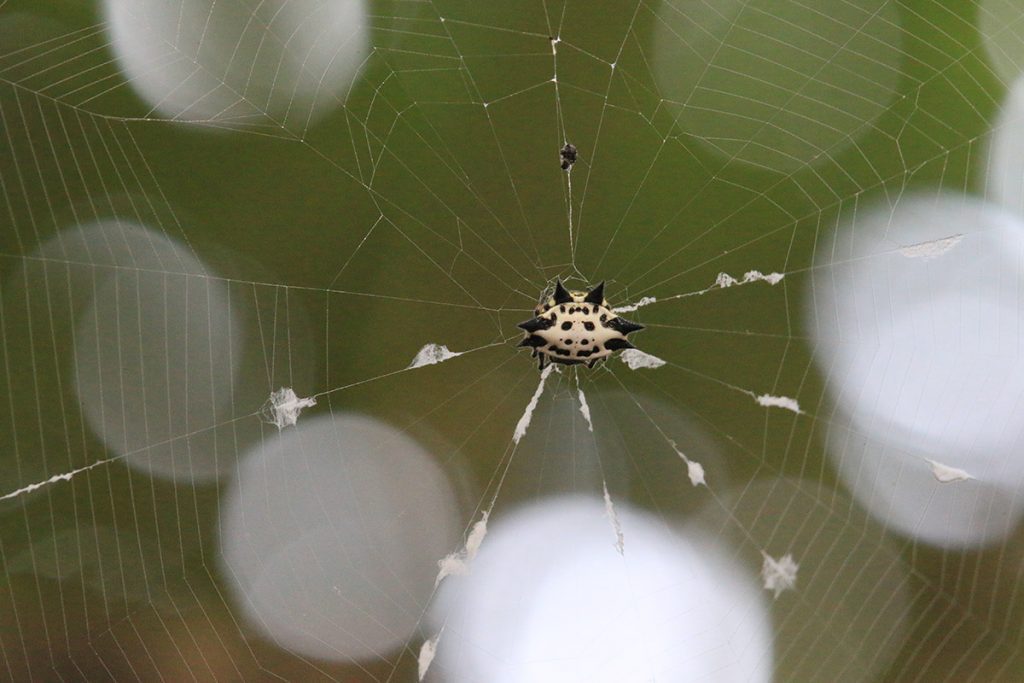
I walked into this spider’s web once or twice before it relocated.
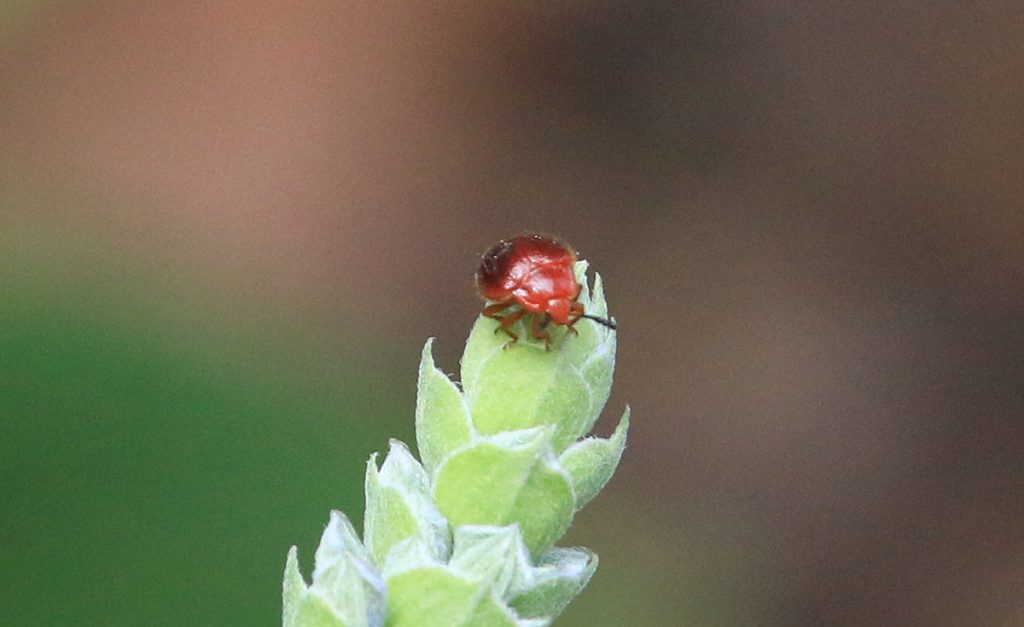
I spotted this little red bug walking around on a blue sage bud. It looks like an immature true bug of some sort, possibly a stink bug.
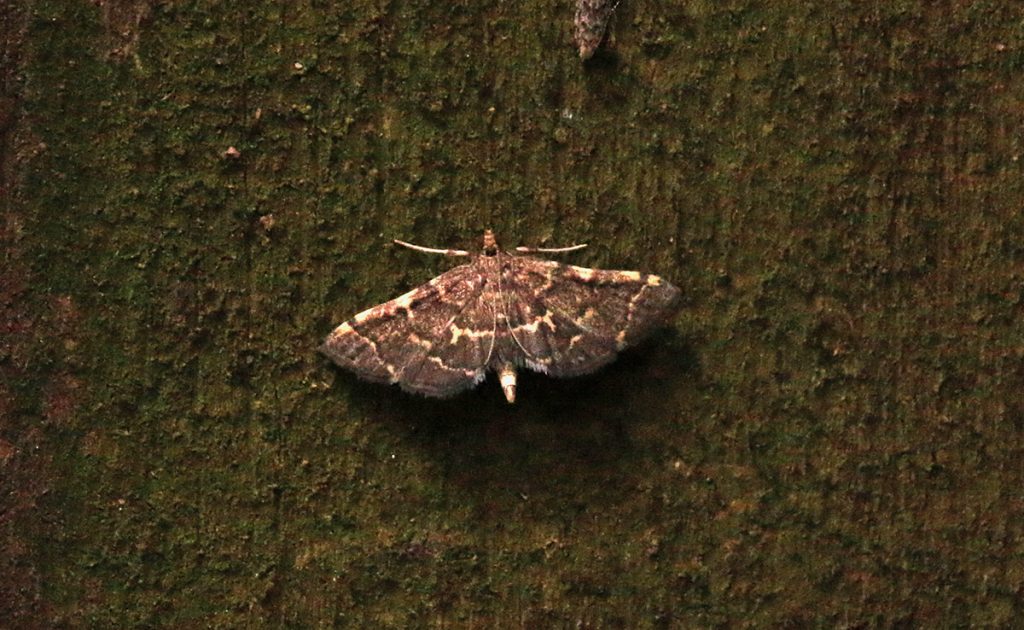
I saw webworm caterpillars in June; here is a webworm moth in August.
August 24, 2020
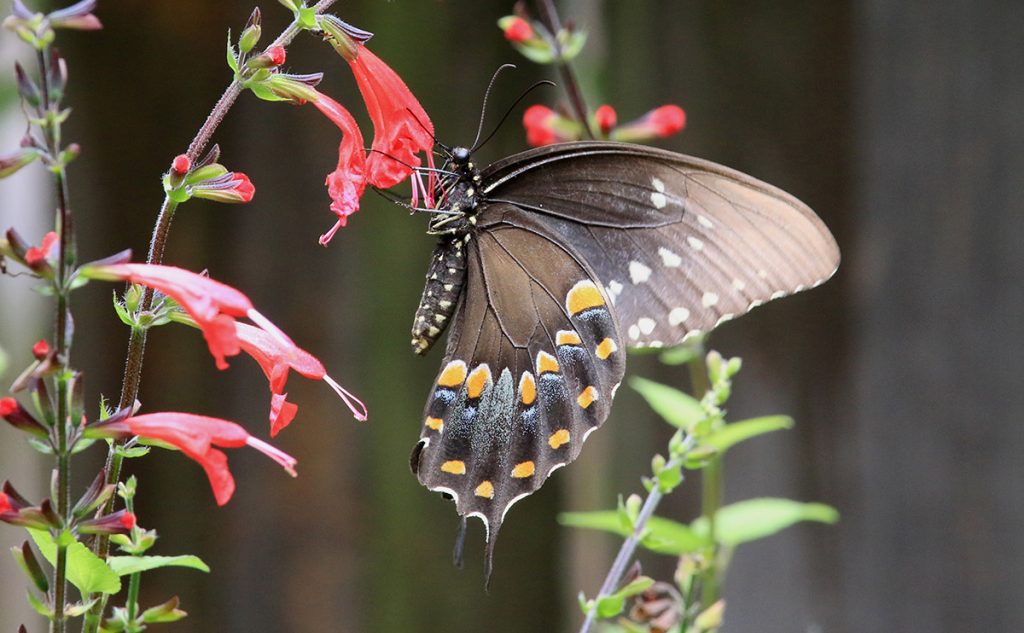
Don’t get me wrong- I like spicebush swallowtails. They are large, ornate butterflies, and are always welcome. But every time I see one, I follow it in the hopes that it’s a black swallowtail. I have plenty of Apiaceae in the yard- fennel and cilantro, as well as natives like meadow parsnip and golden Alexander. And we’ve had black swallowtail caterpillars annually.
Last year, well, we had a tragedy. All of our caterpillars disappeared one July day. I figured one reason we had always seen them, and continue to host giant swallowtails, long-tailed skippers, and checkered skippers, among others, is that at least some butterflies return to the plants where they themselves hosted as caterpillars. Losing a whole generation of black swallowtails may have interrupted a lineage that had been visiting our plants for years.
But then, like the monarchs this year, that was a small batch, and the only batch of the year. The two years previous we’d hosted a dozen or two in multiple waves. Fingers crossed that they return this year.
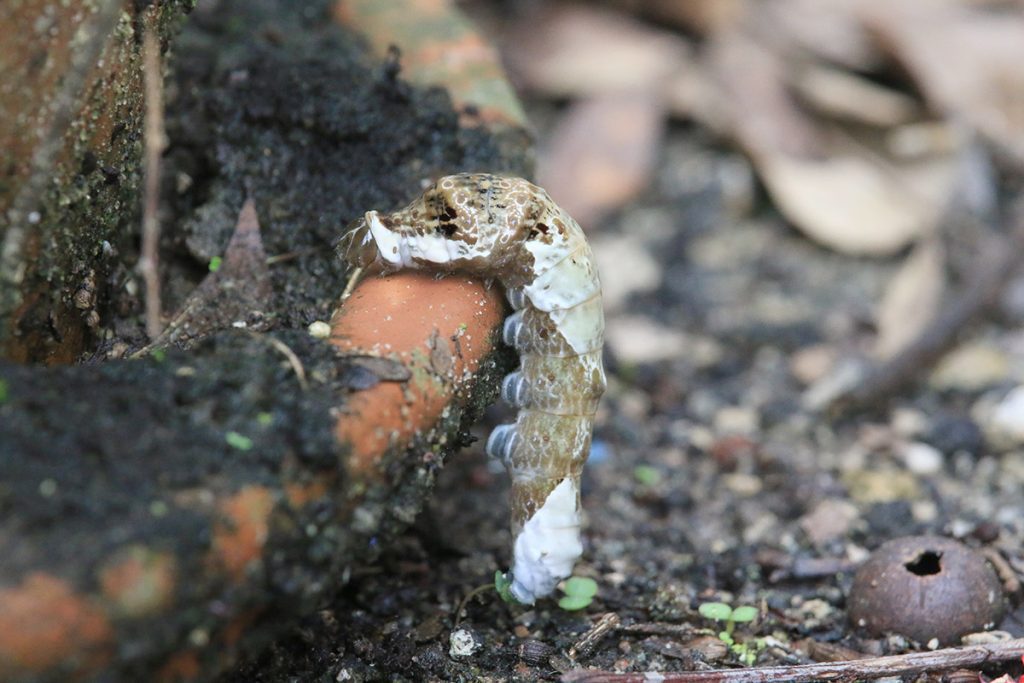
I found this large giant swallowtail caterpillar roaming around the base of its host plant. It made towards the fence, and started back into the Meyer lemon pot. It didn’t seem to make a chrysalis on the plant, though, as they sometimes do. Hopefully it found a secure spot away from potential predators.
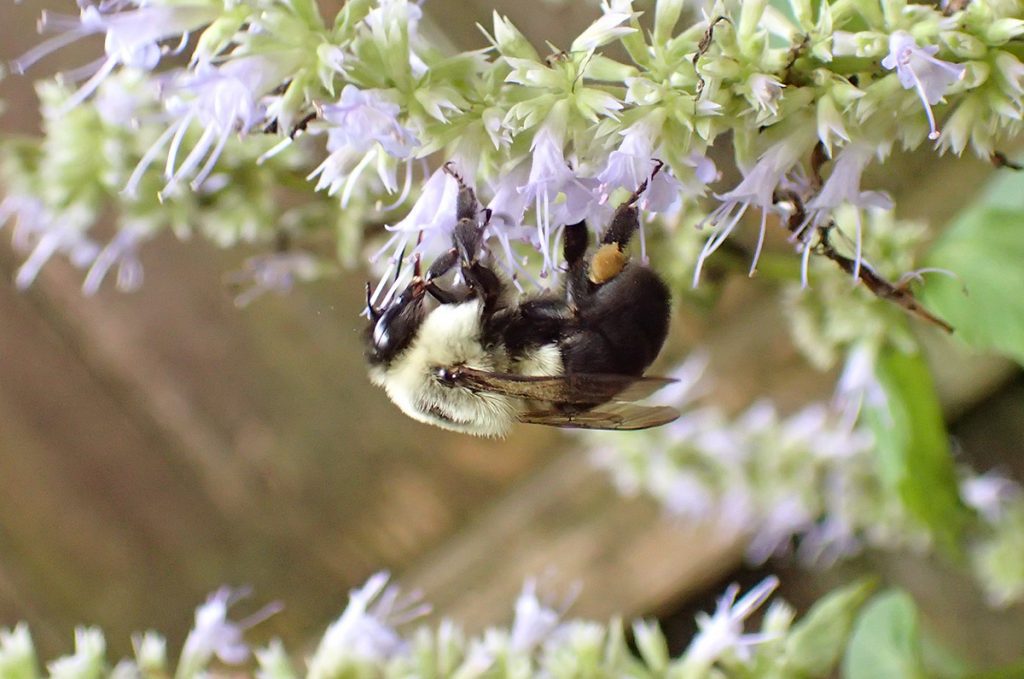
As August marches on, I keep seeing more bee species return after taking breaks. I remember from our segment on American bumblebees that those insects had two broods a year; do eastern bumblebees do the same? Those broods overlap, with the first batch helping to raise the second. Does that keep them from leaving the hive as often?
I guess I’m wondering whether eastern bumblebees appear in waves, as we se in our yard.
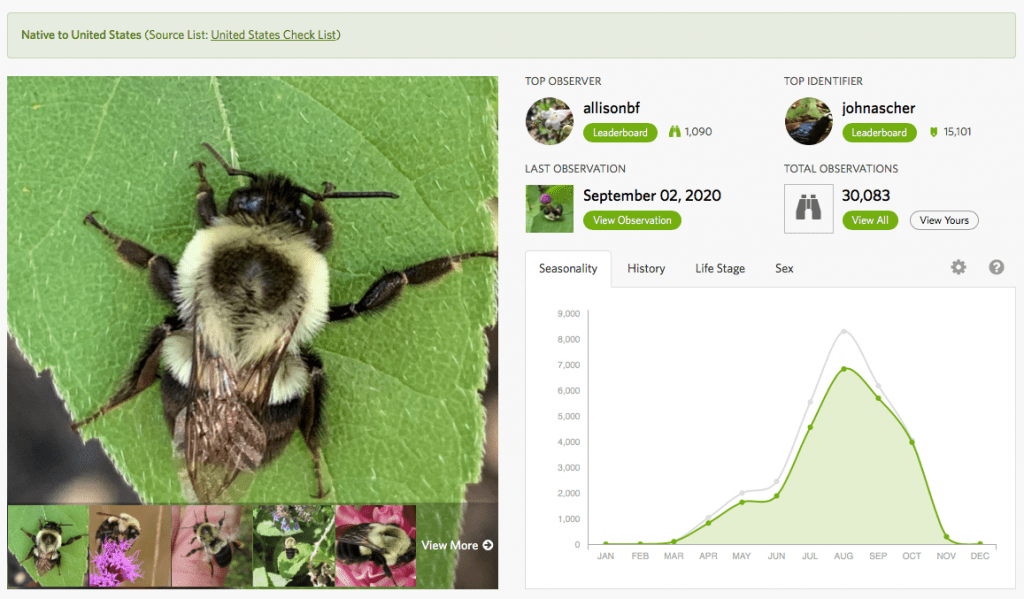
There’s some good information to be had if you click on the species name in your iNaturalist observations. According to this, this species is only spotted more as spring and summer progress, peaking in August and then declining. In our yard, I’d seen up to four at a time in June, and then not at all for a little while. I’ve been seeing one or two pretty regularly in late August/ early September.
But that’s just my yard. Looking over what all observers are collectively seeing, we get a different story. That’s one reason to record as many observations as you can; you’re adding to this data set.
August 25, 2020
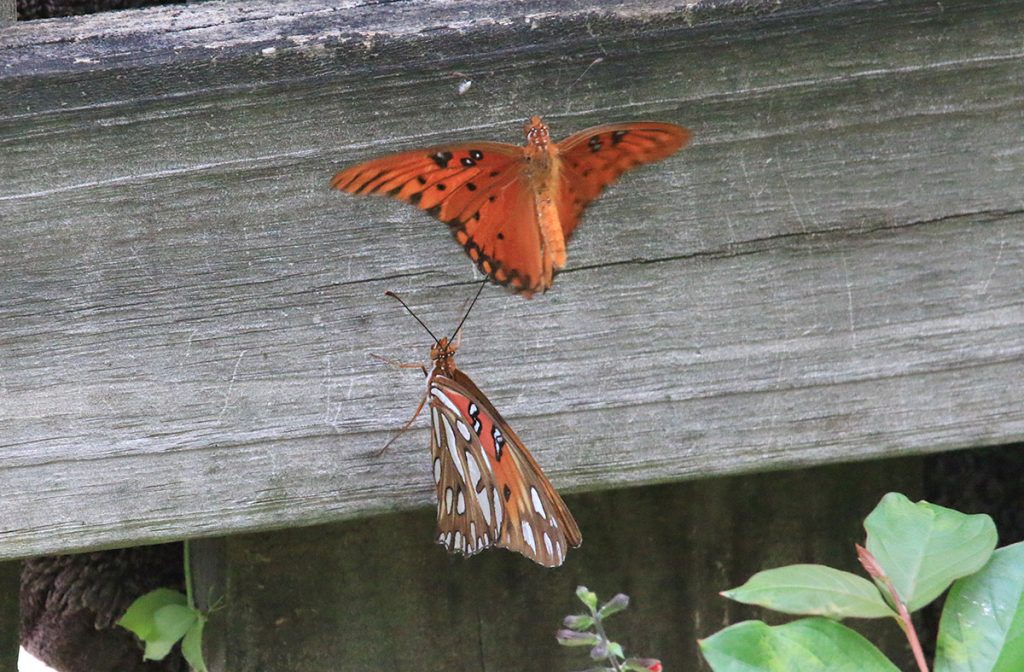
I followed this scene around the flower patch for a little while. One fritillary chased another, and then finally one landed while the other hovered above it. And he kept hovering. And then the male flew off.
From what I can tell, the butterfly on the bottom put herself in a position where the male couldn’t mount her. Eventually, the male got the hint and left, but then not long after, he made another attempt and she did about the same thing. I’ve seen this a few times this year- spicebush swallowtails at Klapp-Phipps, fiery skippers in our yard in April. One butterfly wants to, but the other not so much. Amy says they’re creeped out by my standing there with a camera.
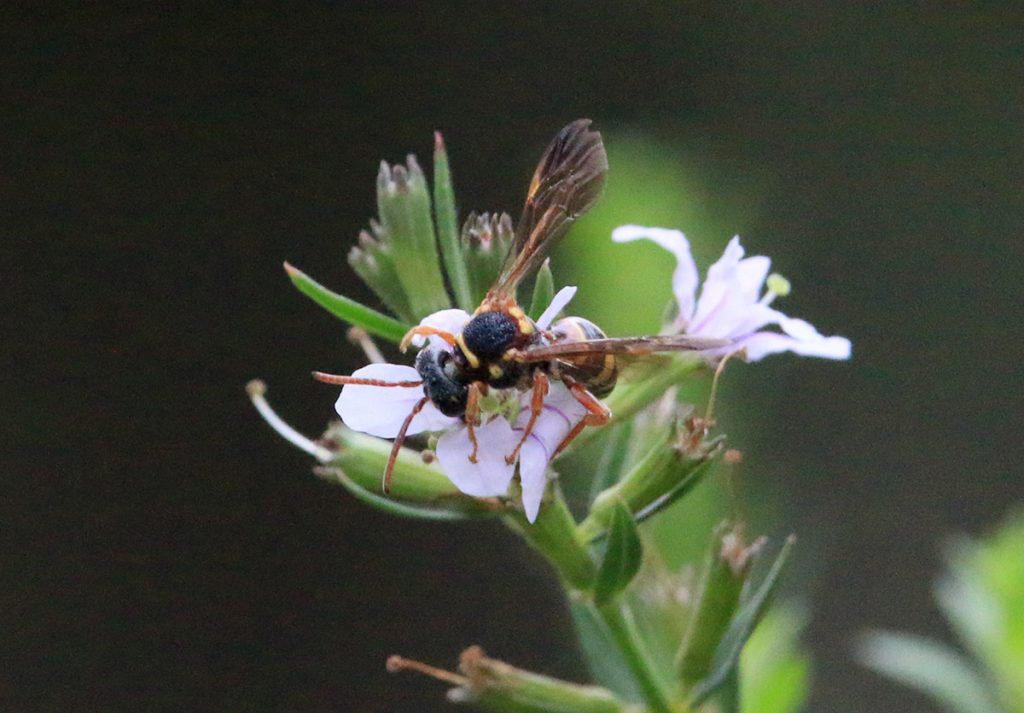
Here’s a bee I’ve never seen before. It’s small, and has kind of narrow waist, like many wasps. So, maybe I’d seen it before and didn’t think I was looking at a bee.
It continues to be a banner year for bee watching in the yard, with a diversity of species and more individuals of many species than I’ve seen in the yard before. This is our third year since we started pulling up pavers and letting native ground cover take over (with plenty of space for ground nesting insects to dig a little hole). I planted that flower patch two years ago, and threw the bee balm and coreopsis seeds down in the other patch soon after. And I add new plants when I can. We don’t have much space, but it’s becoming a good habitat.
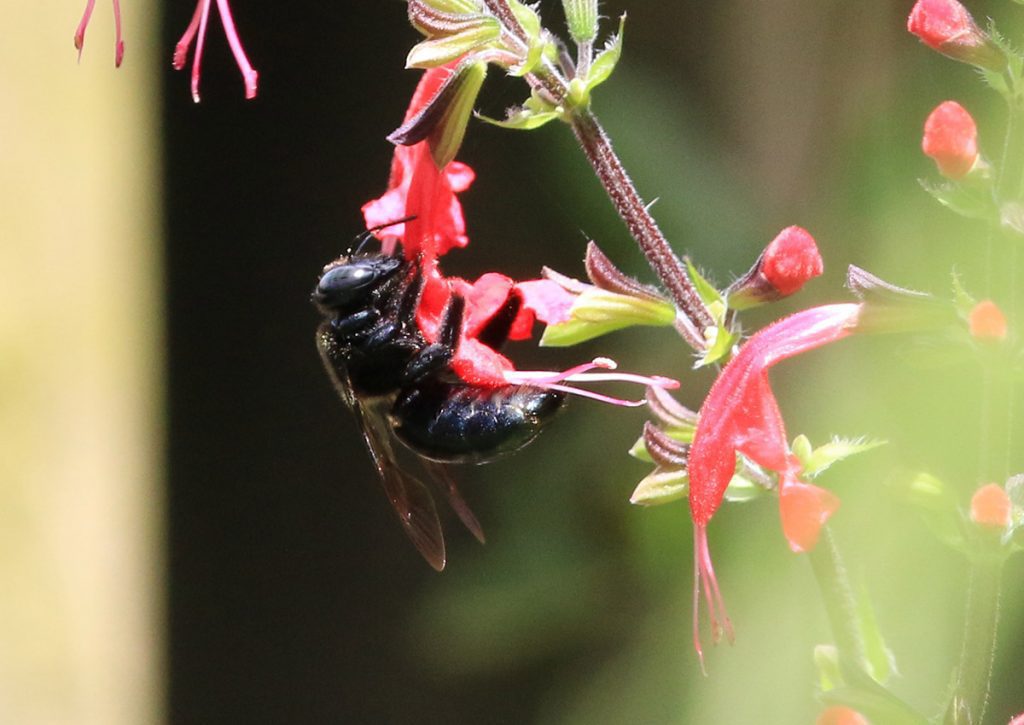
Here’s another bee I hadn’t seen in a few weeks.
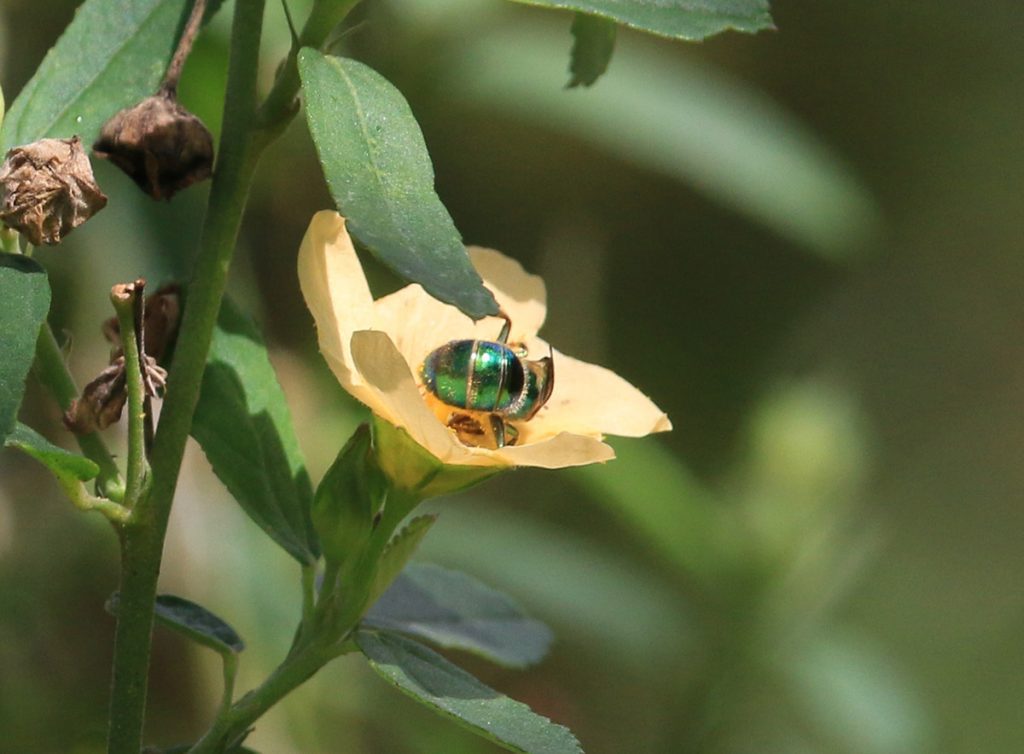
The brown-winged striped sweat bees have little swarms in multiple parts of the yard. They started on the dotted horsemint patch, and then I started seeing a little swarm on the main flower patch in the back. It feels like fanpetals get ignored until there are a lot of bees, wasps, and butterflies in the patch, and then I start seeing bees in them.
I’ve also been seeing the small Dialictus sweat bees, but haven’t photographed them. They fit nicely inside fanpetal flowers.
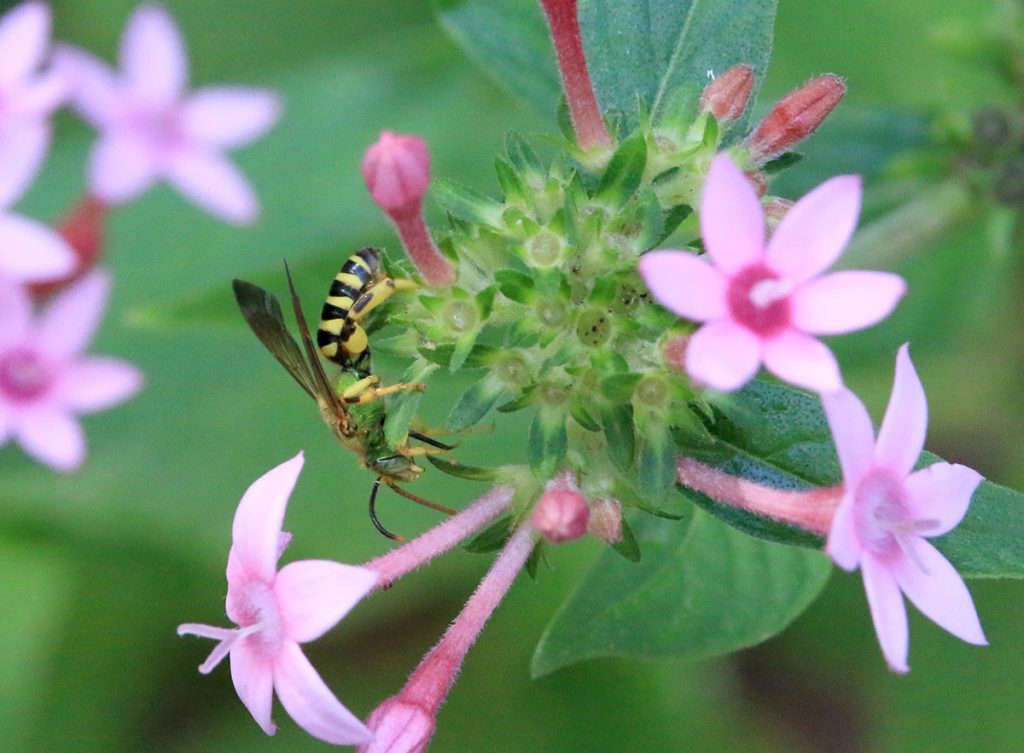
The brown-winged striped sweat bees are also visiting the potted plants in the backyard. There was a small swarm of them bouncing between the pentas, blue sage, and blue lobelia.
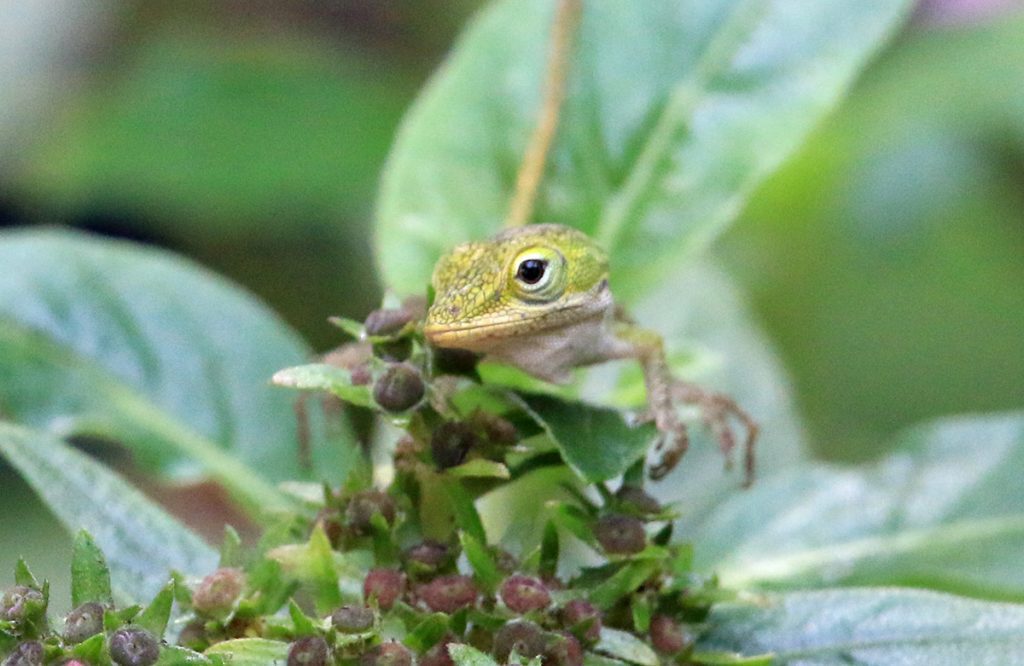
This small green anole was on the pentas plant, eyes watching the bees and red marked Pachodynerus wasps on its flowers. It seemed ambitious to me for such a small lizard to stalk stinging insects. Eventually, I did see it make as if it was eating smaller insects hiding in the flowers. Nonetheless, the bees and wasps would occasionally dive bomb him.
August 31, 2020
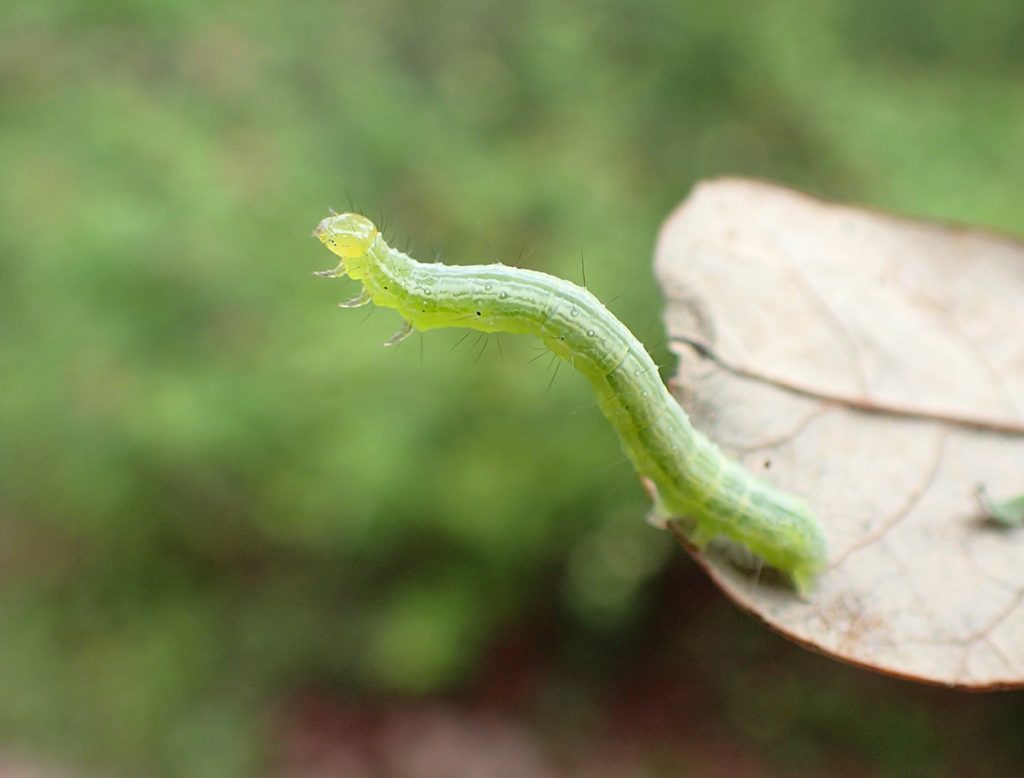
I noticed our basil leaves were being eaten by something, and I found a couple of these caterpillars. Not cool. I moved them to other plants in another part of the yard.
We’ve had a few inches of rain over the last couple of weeks, and I started noticing mushrooms all over that part of the yard.
I was surprised to find seven or eight golden chanterelles under the edge of our laurel oak’s canopy. Once, a couple of years ago, I saw two small ones. These might make an actual small snack!
For these next couple of mushrooms, I’m putting my best iNaturalist guess. Like I do with plants, I take a few photos. I try to capture the cap, the stem, and the gills. I haven’t had much luck getting confirmations on mushrooms, and in looking over the options, there are so many similar species.
This mushroom had been plucked, a bite taken out of it, lying upside down. Is this an edible mushroom? Or am I soon to find a dead squirrel in the yard? I’m fairly certain this is a bolete of some sort- my first guess is chestnut bolete.
So that’s July and August in the yard. September 2020 is starting off with a decent amount of rain, continuing the trend from August. Last year, however, September was entirely without rain. I’m curious to see how it goes this year.
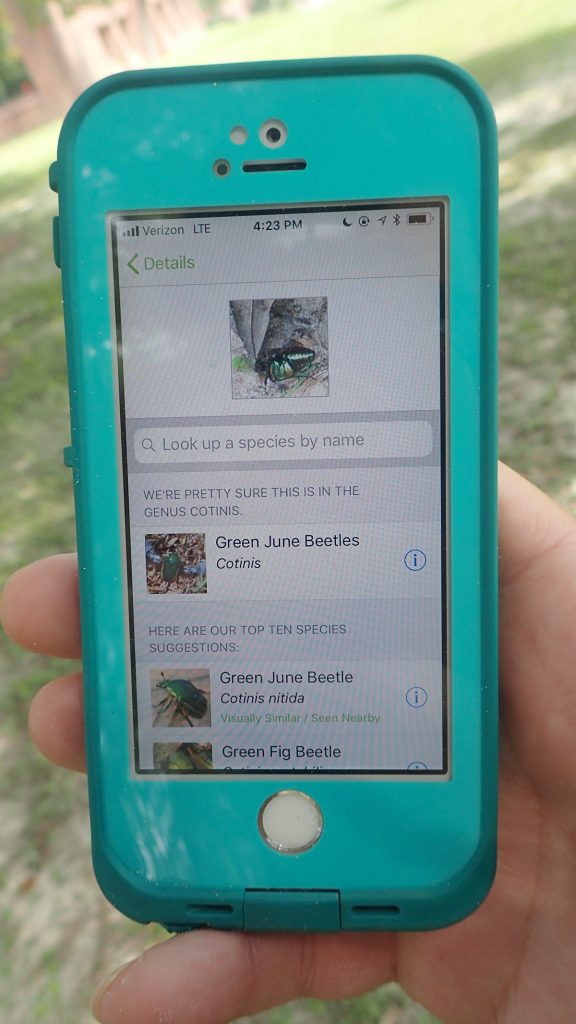
Apps and Citizen Science mentioned in the Backyard Blog
iNaturalist
Identify plants, animals, lichens, and fungi in your yard. Other users correct your identifications if you’re wrong, and even if they don’t, it can be a good springboard to further research.
Seek by iNaturalist
Instant identification, and it doesn’t record your location. This is a good option for kids with phones.
Monarch Larva Monitoring Project
Enter information about monarch caterpillars in your yard, and help researchers get a sense of the health of the monarch population that year, and how and when they’re migrating.
Great Sunflower Project
Record the number of pollinators visiting your flowers, and help researchers map pollinator activity across the country.
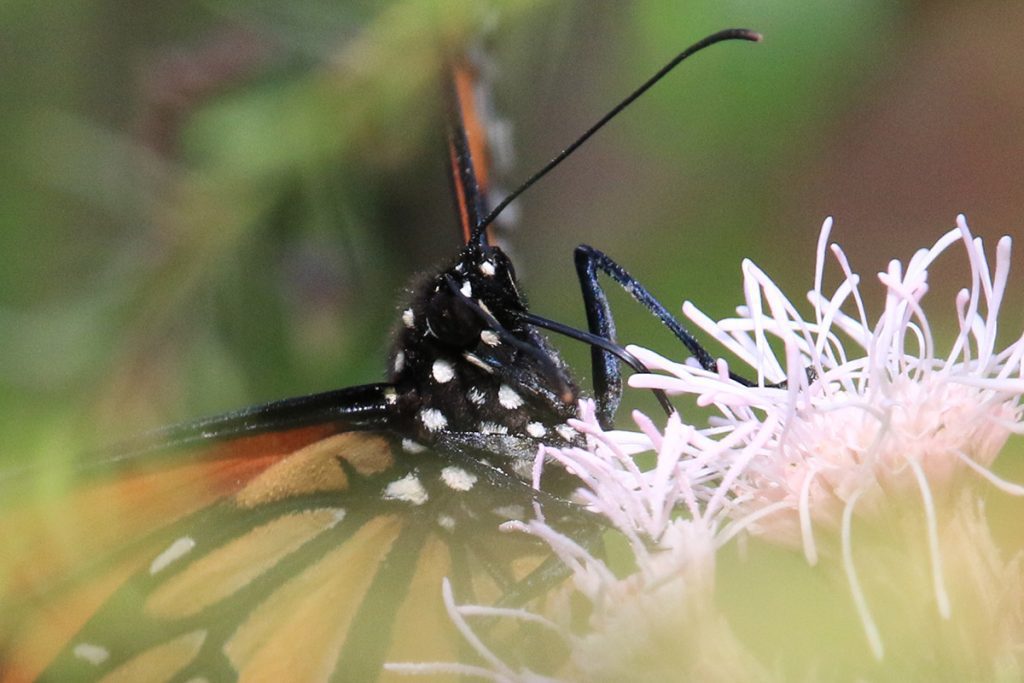
Dig Deeper into Backyard Ecology
What can we do to invite butterflies, birds, and other wildlife into our yards? And what about the flora and fauna that makes its way into our yards; the weeds, insects, and other critters that create the home ecosystem? WFSU Ecology Blog takes a closer look.


